Category
Significant Photographers
22 entries in this category | view all categories
Christmas Nocturne
Posted December 2023 in Documentary Photography, New Additions, Significant Photographers, Texts
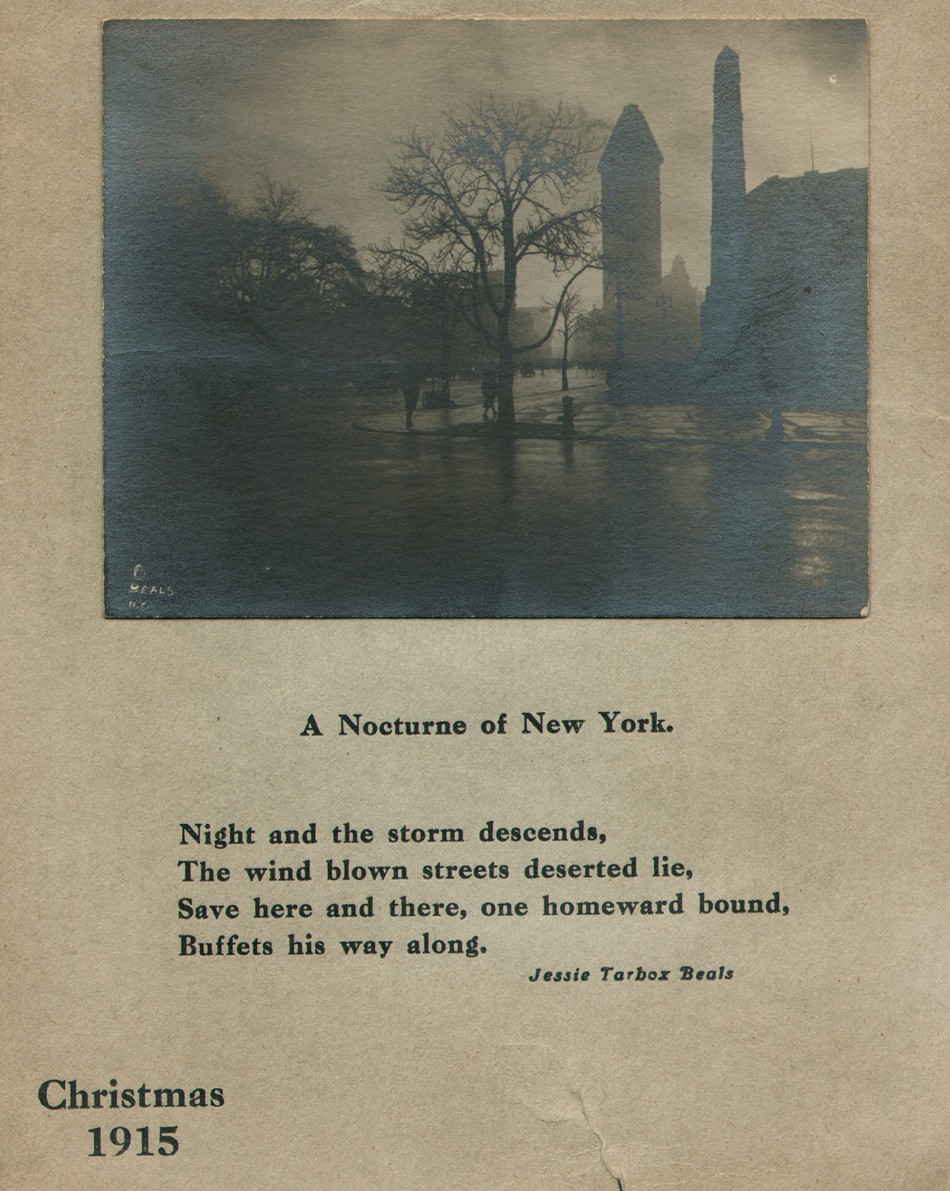 “A Nocturne of New York -Christmas 1915”: Jessie Tarbox Beals, American (1870-1942) 1915 print from negative 1905-1906: vintage Silver Bromide print 8.0 x 10.1 cm affixed within folded single sheet of tan woven paper with printed poem by Beals 18.9 x 27.7 cm. One of two known versions of Beals 1915 Christmas card, with the other held by Princeton but actually showing streetcars and the One Times Square building in the background. The famous New York City landmark skyscraper the Flatiron Building, built in 1902, is shown looming over the horizon just to the right of the center of this photograph. The original acetate negative for same is held by the Museum of the City of New York describing the view as “Fifth Avenue at 25 Street (at dusk), 1906.” (catalogue # 91.53.39) From: PhotoSeed Archive
“A Nocturne of New York -Christmas 1915”: Jessie Tarbox Beals, American (1870-1942) 1915 print from negative 1905-1906: vintage Silver Bromide print 8.0 x 10.1 cm affixed within folded single sheet of tan woven paper with printed poem by Beals 18.9 x 27.7 cm. One of two known versions of Beals 1915 Christmas card, with the other held by Princeton but actually showing streetcars and the One Times Square building in the background. The famous New York City landmark skyscraper the Flatiron Building, built in 1902, is shown looming over the horizon just to the right of the center of this photograph. The original acetate negative for same is held by the Museum of the City of New York describing the view as “Fifth Avenue at 25 Street (at dusk), 1906.” (catalogue # 91.53.39) From: PhotoSeed Archive
Deep Holbein
Posted March 2021 in Alternate Processes, Color Photography, New Additions, Significant Photographers, Significant Photographs
A reappraisal of old photos has recently invaded the public conversation of late. Artificial intelligence, in the form of video driver technology invented by Israeli company D-ID, was licensed earlier this year to genealogy and DNA company MyHeritage with the moniker Deep Nostalgia™. Old photographs, no matter their original medium, are brought to life as short animated video clips, and may never be seen in the same way again.
 Screenshot: Animated “A Holbein Woman” from YouTube. Cropped image of the same by American photographers Frances & Mary Electa Allen, ca. 1890 using the Deep Nostalgia™ app licensed to genealogy and DNA company MyHeritage. Original source photograph from PhotoSeed Archive.
Screenshot: Animated “A Holbein Woman” from YouTube. Cropped image of the same by American photographers Frances & Mary Electa Allen, ca. 1890 using the Deep Nostalgia™ app licensed to genealogy and DNA company MyHeritage. Original source photograph from PhotoSeed Archive.
Taking up the company’s free offer to try out the technology, I applied it to a recent archive acquisition, A Holbein Woman, taken in the very early 1890’s by Deerfield, Massachusetts sister photographers Frances Stebbins and Mary Electa Allen. You can see the result in a short 12 second video posted to YouTube embedded above in this post.
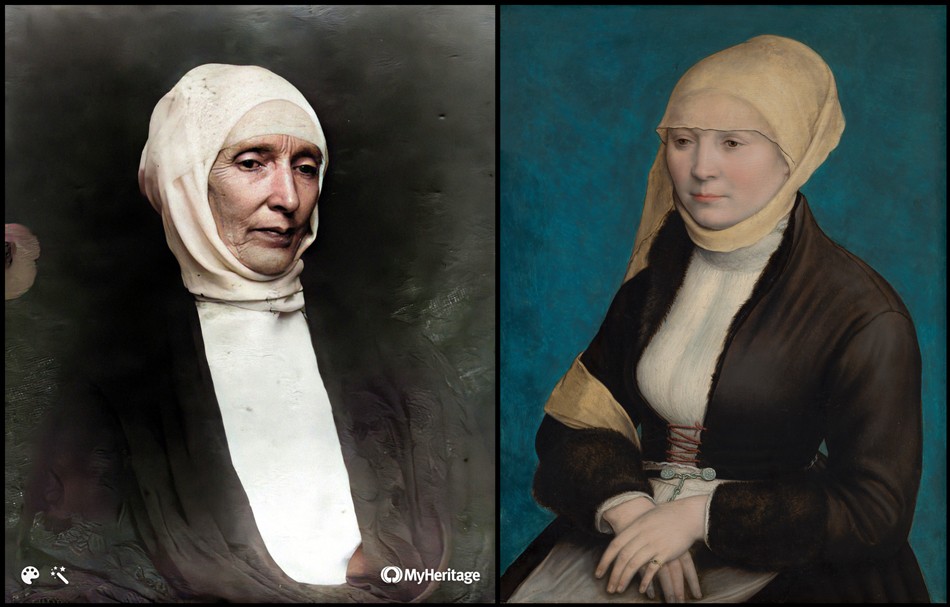 Left: Colorized version of “A Holbein Woman” by American photographers Frances & Mary Electa Allen, ca. 1890. Created by DeOldify deep learning experts Jason Antic and Dana Kelley, this colorizing technology has been licensed from DeOldify by DNA company MyHeritage, with their branding of MyHeritage In Color™. Source photograph from PhotoSeed Archive. Right: “Portrait of a Woman from Southern Germany”: c. 1520-25: Formerly attributed to Hans Holbein the Younger, Germany: (1497/1498-1543): Oil on panel: 45 x 34 cm: Courtesy: collection of the Mauritshuis museum in The Hague.
Left: Colorized version of “A Holbein Woman” by American photographers Frances & Mary Electa Allen, ca. 1890. Created by DeOldify deep learning experts Jason Antic and Dana Kelley, this colorizing technology has been licensed from DeOldify by DNA company MyHeritage, with their branding of MyHeritage In Color™. Source photograph from PhotoSeed Archive. Right: “Portrait of a Woman from Southern Germany”: c. 1520-25: Formerly attributed to Hans Holbein the Younger, Germany: (1497/1498-1543): Oil on panel: 45 x 34 cm: Courtesy: collection of the Mauritshuis museum in The Hague.
The photograph, considered a masterwork of early genre pictorialist portrait photography, is of their mother Mary Stebbins Allen, (1819-1903) and in itself done after the then fashionable practice (1.) of an imitation painting: in this case, a Renaissance portrait by Bavarian artist Hans Holbein the Elder. (c. 1460-1524) To add another layer of mystery, research I did last year revealed the primary source portrait- the oil painting (c.1520-1525) known as “Portrait of a Woman from Southern Germany” in the collection of the Mauritshuis museum in The Hague, was originally attributed to Holbein’s son “The Younger”, (c. 1497-1543) with the now updated disclaimer by the museum’s curators as being “formerly attributed” to this artist. This painting can be seen at upper right, with a colorized version of the Allen sisters portrait run through remarkable colorization technology MyHeritage In Color™ at left.
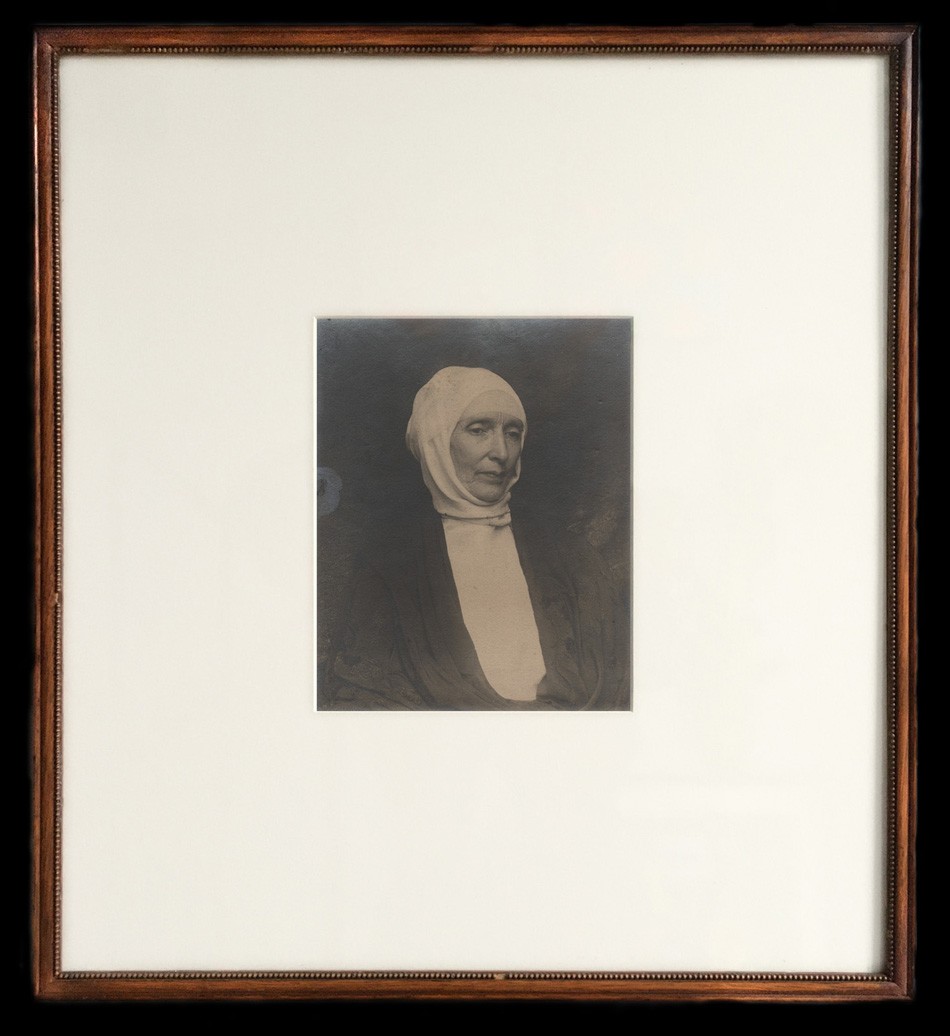 “A Holbein Woman”: Frances Stebbins & Mary Electa Allen, American: 1854-1941 & 1858–1941. Gelatin silver print ca. 1890: 20.1 x 16.3 cm laid down on light gray card mount 35.2 x 27.8 cm: presented here in original ca. 1896 beaded wood frame by Greenfield, MA framer Dunklee & Freeman with original overmat replaced. Done with the intent of being a tribute imitation painting to Hans Holbein’s “Portrait of a Woman from Southern Germany”, the subject of this portrait is the photographer’s mother Mary Stebbins Allen. (1819-1903) The result: “A Holbein Woman”, was one of the earliest and most successful examples of portraiture done by the Deerfield, MA sisters. From: PhotoSeed Archive.
“A Holbein Woman”: Frances Stebbins & Mary Electa Allen, American: 1854-1941 & 1858–1941. Gelatin silver print ca. 1890: 20.1 x 16.3 cm laid down on light gray card mount 35.2 x 27.8 cm: presented here in original ca. 1896 beaded wood frame by Greenfield, MA framer Dunklee & Freeman with original overmat replaced. Done with the intent of being a tribute imitation painting to Hans Holbein’s “Portrait of a Woman from Southern Germany”, the subject of this portrait is the photographer’s mother Mary Stebbins Allen. (1819-1903) The result: “A Holbein Woman”, was one of the earliest and most successful examples of portraiture done by the Deerfield, MA sisters. From: PhotoSeed Archive.
Another words, if being accurate to revisionist history but without the convenient addition of a famous name, (2.) the Allen sisters efforts in the modern day might conceivably be retitled “A Formerly Attributed Woman” rather than “A Holbein Woman”.
And although it is but one example reanimated from that era using new technology, it seems reasonable to conclude 21st Century progress courtesy of Deep Nostalgia™ may only reinforce and belie a continuation of certain prejudices and expectations from the past, the same criticism that could be leveled at video driver technology being only an approximation of humanity, leaving us devoid of the true mannerisms of those who actually lived.
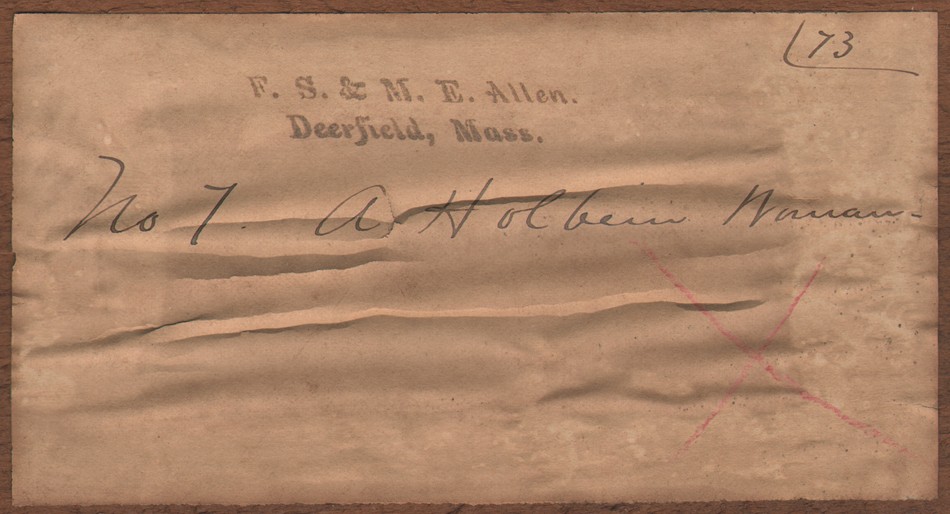 Exhibition label: “A Holbein Woman”: ca. 1896. Pasted white-paper label (7.2 x 13.6 cm) (preserved and cut out from) wood backing board with black ink photographers stamp: F.S. & M.E. Allen. Deerfield, Mass.; in black ink believed to be in the hand of the photographers: No 7 A Holbein Woman: 73 to upper right corner, faint X mark in red ink in lower right. From: PhotoSeed Archive
Exhibition label: “A Holbein Woman”: ca. 1896. Pasted white-paper label (7.2 x 13.6 cm) (preserved and cut out from) wood backing board with black ink photographers stamp: F.S. & M.E. Allen. Deerfield, Mass.; in black ink believed to be in the hand of the photographers: No 7 A Holbein Woman: 73 to upper right corner, faint X mark in red ink in lower right. From: PhotoSeed Archive
“Creepy” is one online descriptor I kept encountering in people’s reactions to this new technology, but when has that ever stopped “progress”? (3.) Are we doomed or can fleeting perceptions of the past in old photographs brought to “life” change our future for the better, our marveling reactions to it as incidental as the new shiny object of the here and now? Only time will tell. (4.) David Spencer-
Notes:
1. The worldwide pandemic brought on by COVID-19 lockdowns inspired a massive revival of imitation paintings and other works of art including photography. Amsterdam’s Rijksmuseum in March, 2020 promoted their Stay at Home Challenge!, inviting people to recreate modern day reinterpretations from masterworks in their collection. This was soon followed by the Getty museum in California. One of the very first “challenge” accounts to promote this revived genre was the Netherlands Instagram account Tussen Kunst & Quarantaine- translating to “between art and quarantine” which first inspired the Rijksmuseum challenge.
2. This would never happen.
3. An examination of ethical concerns as a result of so-called Deepfake technology contained within Deep Nostalgia™ is explored in a New York Times article written by Daniel Victor from March 10, 2021: Your Loved Ones, and Eerie Tom Cruise Videos, Reanimate Unease With Deepfakes.
4. That shiny object has been here since February, 2021. Care to upload a selfie, historical photograph or stock pic of Kim Jong-un, Mao Zedong or Joe Biden and see yourself or them “sing” to popular music? Then download the WOMBO app here. Guardian technology columnist Helen Sullivan reports on March 12, 2021 the app just might be giving competition to Deep Nostalgia™.
Henry Ravell: Embracing Art & Photography
Posted August 2020 in Alternate Processes, Cameras, Color Photography, Documentary Photography, Framing, History of Photography, New Additions, Painters|Photographers, Photography, Scientific Photography, Significant Photographers
“Coburnesque”, or, in the style of American master pictorialist Alvin Langdon Coburn, (1882-1966) was how the work of now forgotten American photographer Henry Ravell (1864-1930) was described in 1908 by London’s Amateur Photographer & Photographic News.
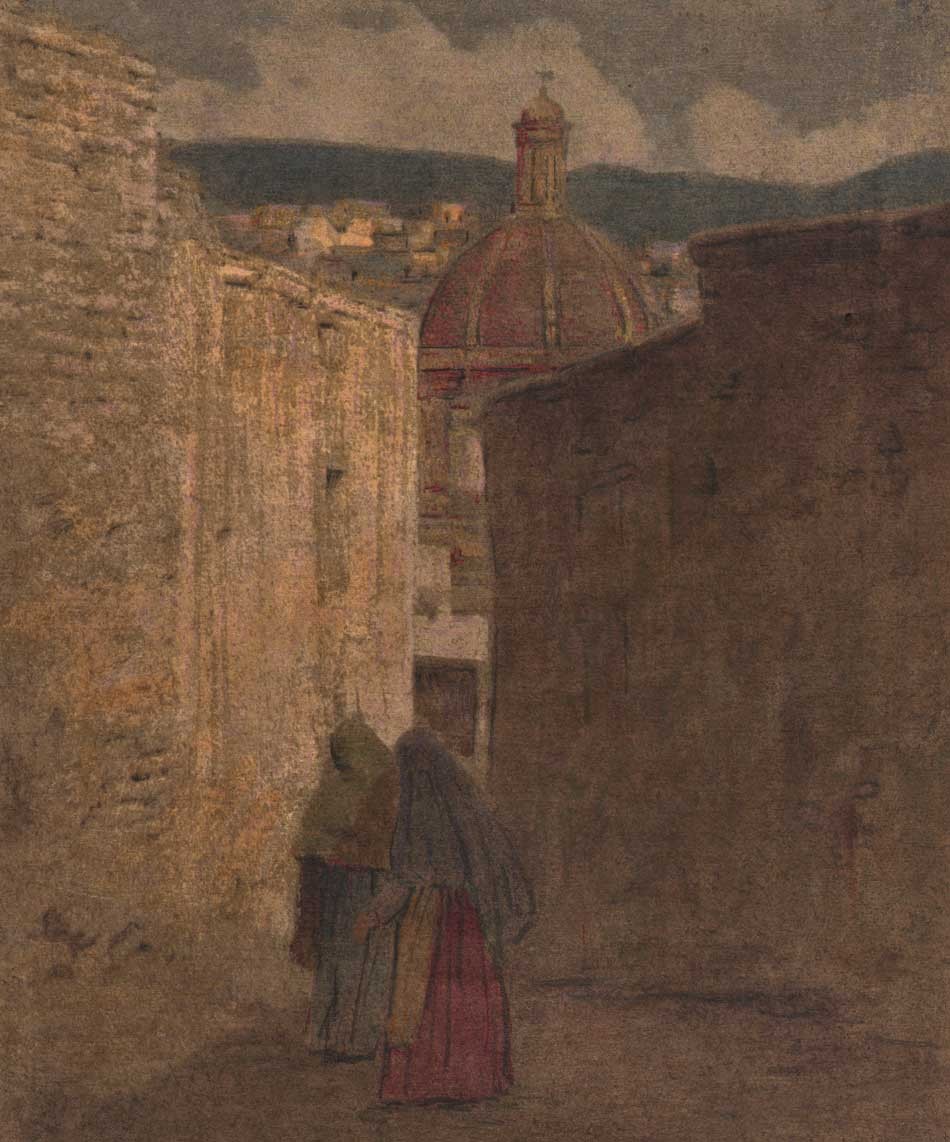 Detail: “A Narrow Street-Guanajuato”: Henry Ravell, American: 1864-1930. Vintage multiple color gum print c. 1907-14. Image: 33.1 x 23.5 presented loose within brown paper folder with overall support dimensions of 39.8 x 58.8 cm. In central Mexico, with the dome of a church framing the skyline at center in background, two native women make their way along one of Guanajuato’s narrow streets. Henry Ravell perfected the gum bichromate process to a very high level. Probably in 1906-07, he began experimenting in multiple color gum. In Germany, around this same time, similar examples were being done by the brothers Theodor (1868-1943) and Oscar Hofmeister, (1871-1937) as well as Heinrich Wilhelm Müller. (1859-1933) From: PhotoSeed Archive
Detail: “A Narrow Street-Guanajuato”: Henry Ravell, American: 1864-1930. Vintage multiple color gum print c. 1907-14. Image: 33.1 x 23.5 presented loose within brown paper folder with overall support dimensions of 39.8 x 58.8 cm. In central Mexico, with the dome of a church framing the skyline at center in background, two native women make their way along one of Guanajuato’s narrow streets. Henry Ravell perfected the gum bichromate process to a very high level. Probably in 1906-07, he began experimenting in multiple color gum. In Germany, around this same time, similar examples were being done by the brothers Theodor (1868-1943) and Oscar Hofmeister, (1871-1937) as well as Heinrich Wilhelm Müller. (1859-1933) From: PhotoSeed Archive
Under the headline “Local Colour.” by journal critic “The Magpie”, a discussion of the merits around Ravell’s new color multiple gum printing process was considered for their large readership. Commenting on a series of his Mexican church photographs published in the May issue of the Century Magazine, “Magpie” writes:
“Who is this Mr. Ravell, and what is his wonderful colour process, which is not “on the negative”? Multiple-gum, one may surmise- and one may also venture to guess that Mr. “de Forest” (Lockwood de Forest- editor) has, notwithstanding this flourish of trumpets, nothing very much to tell us. The Ravell photographs, illustrating “Some Mexican Churches,” are Coburnesque, and the pictures are, in their very Yankee style, fine and strong- which is more than can be said for those in our English monthlies. Couldn’t Mr. Ravell be induced to send some examples of his work to the R.P.S. or Salon? We badly need some new American exhibitors.” (June 16, p. 600)
A reassessment of Ravell’s output is long overdue in elevating him back to his rightful position as one of the more important practitioners of pictorialism in the early 20th Century canon of American artistic photographers.
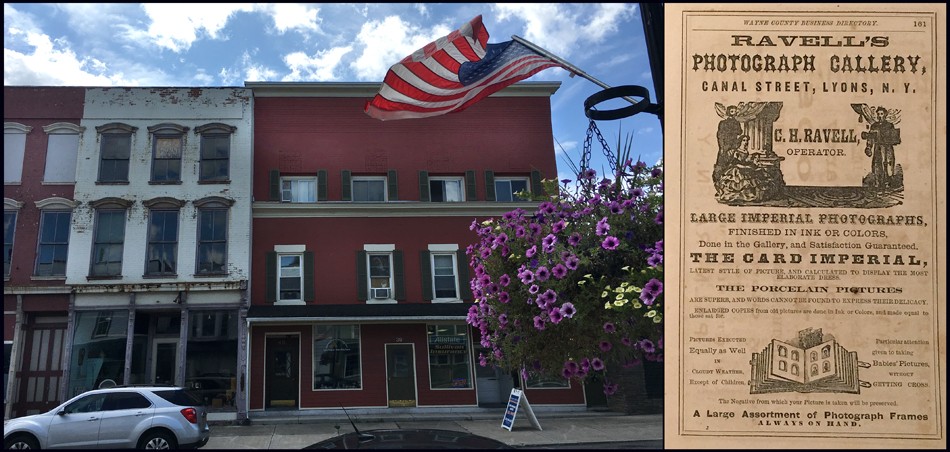 Left: Henry Ravell was only a toddler when his father Charles Henry Ravell (1833-1917) opened a skylight photographic studio on the third floor of this brick building painted red located on Canal Street in Lyons, New York around 1865-66. Shown here in the summer of 2019, the entrance was at the present day 36 Canal street (on the far right of the photo-presently an insurance office) but was numbered #30 Canal before the turn of the 20th Century. It was here that Henry was “brought up in photography from childhood and became an expert in all processes before he was twelve years old”. Right: A full-page advertisement for “Ravell’s Photograph Gallery” operated by C.H. Ravell at the Canal street building appeared in the 1867-68 Wayne County (New York) Business Directory. At the time, Charles Ravell would have been using the wet-plate process, and the ad highlights “Large Imperial Photographs finished in Ink or Colors”… “Pictures Executed Equally as Well in Cloudy Weather Except of Children”… “Particular attention given to taking Babies’ Pictures, without Getting Cross”. Left: David Spencer for PhotoSeed Archive; Right: courtesy Museum of Wayne County History.
Left: Henry Ravell was only a toddler when his father Charles Henry Ravell (1833-1917) opened a skylight photographic studio on the third floor of this brick building painted red located on Canal Street in Lyons, New York around 1865-66. Shown here in the summer of 2019, the entrance was at the present day 36 Canal street (on the far right of the photo-presently an insurance office) but was numbered #30 Canal before the turn of the 20th Century. It was here that Henry was “brought up in photography from childhood and became an expert in all processes before he was twelve years old”. Right: A full-page advertisement for “Ravell’s Photograph Gallery” operated by C.H. Ravell at the Canal street building appeared in the 1867-68 Wayne County (New York) Business Directory. At the time, Charles Ravell would have been using the wet-plate process, and the ad highlights “Large Imperial Photographs finished in Ink or Colors”… “Pictures Executed Equally as Well in Cloudy Weather Except of Children”… “Particular attention given to taking Babies’ Pictures, without Getting Cross”. Left: David Spencer for PhotoSeed Archive; Right: courtesy Museum of Wayne County History.
Undoubtedly, “Magpie” would have been pleased to know Henry Ravell sprung from fine English photographic stock. His father Charles Henry Ravell (1833-1917) emigrated to the U.S. from Boston, England and was known to have been active as a Daguerreotypist as early as 1857, (1.) his trade shingle set up early in the New York state village of Chittenango. By 1860, U.S. Census records show he had moved to Wolcott, New York, where he was a commercial photographer. Surviving cdv photographs from here bearing his C.H. Ravell back-stamp reveal some of his clients were young men heading off to fight in the American Civil War.
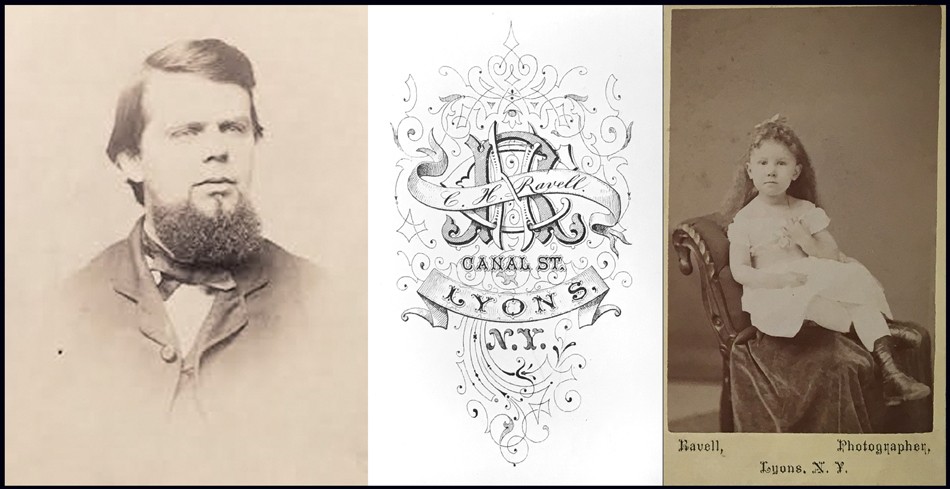 Left: This is the only known portrait of commercial portrait photographer Charles Henry Ravell, father of Henry Ravell. The carte de visite albumen portrait shows him most likely in his early 30’s, after he had settled in Lyons, New York. Born Charles Herring Ravel in Boston, England, he emigrated to the U.S. as a young man, with an early notice of his Daguerreotypist skills from 1857 showing he was living in Chittenango, New York State. By 1860, he had settled in Wolcott, where son Henry was born in early 1864. By 1867 or earlier, he and wife Cornelia Dudley Ravell (1840-1908) and Henry had moved permanently to nearby Lyons. Middle & Right: This elaborate backstamp engraving for C.H. Ravell’s Canal Street skylight studio in Lyons is ca. 1865-80, with the albumen portrait subject (Right) a young girl posing on a commercially available chair. Both: courtesy Museum of Wayne County History
Left: This is the only known portrait of commercial portrait photographer Charles Henry Ravell, father of Henry Ravell. The carte de visite albumen portrait shows him most likely in his early 30’s, after he had settled in Lyons, New York. Born Charles Herring Ravel in Boston, England, he emigrated to the U.S. as a young man, with an early notice of his Daguerreotypist skills from 1857 showing he was living in Chittenango, New York State. By 1860, he had settled in Wolcott, where son Henry was born in early 1864. By 1867 or earlier, he and wife Cornelia Dudley Ravell (1840-1908) and Henry had moved permanently to nearby Lyons. Middle & Right: This elaborate backstamp engraving for C.H. Ravell’s Canal Street skylight studio in Lyons is ca. 1865-80, with the albumen portrait subject (Right) a young girl posing on a commercially available chair. Both: courtesy Museum of Wayne County History
Born in early January of 1864 in Wolcott, Henry Ravell is known to have embraced photography from a very young age. As a boy, he became his father’s apprentice. Lockwood de Forest, (1850-1932) an important influence on Henry for the rest of his life in the 20th Century and important American painter and furniture designer, wrote in 1908 that Henry:
“was born and brought up in photography from childhood and became an expert in all processes before he was twelve years old.” Through a fascinating confluence of sons starting out in their father’s professions, Henry Ravell graduated to having an interest in art, and he studied water-color painting with the noted American artist and Tonalist Henry Ward Ranger, (1858-1916) probably in his late teens or early 20’s. The artist and student had much in common. Like Charles Henry Ravell, who had established his own Canal Street photo studio in Lyons, N.Y. by 1867, (Wayne County Business Directory) Ranger’s father Ward Valencourt Ranger (1835–1905) had opened his own commercial studio in 1868 in Syracuse, N.Y., 55 miles east of Lyons, almost at the same time. Like Henry Ravell working for his father at an early age, Henry Ranger was also known to have worked in his father’s establishment as a young man.
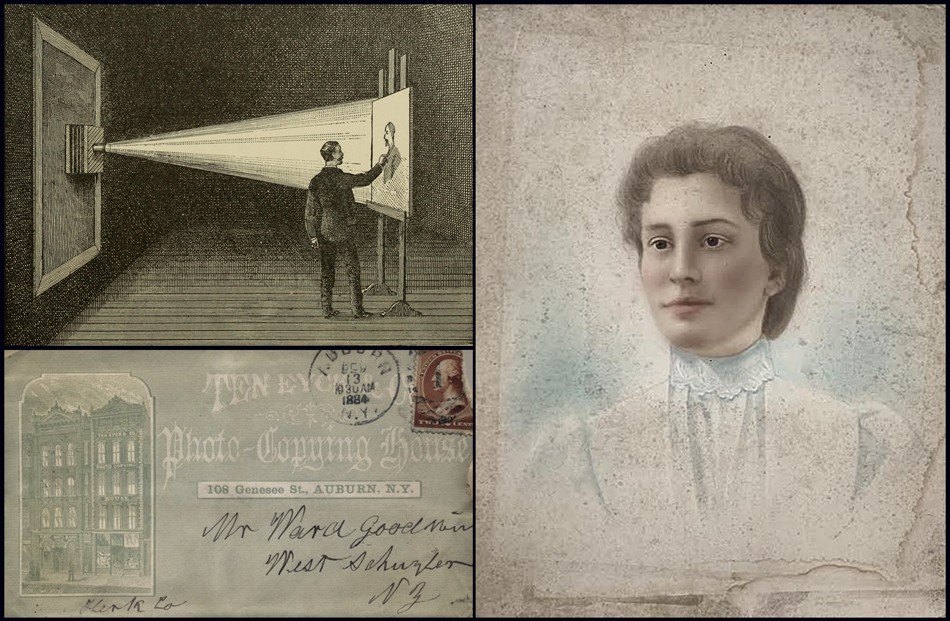 Upper Left: “Negative Outline-Dark Chamber”: woodcut from 1892 volume “Crayon Portraiture: Complete Instructions for making Crayon Portraits on Crayon Paper and on Platinum, Silver, and Bromide Enlargements” by J.A. Barhydt. In the early 1880’s, Henry Ravell worked in a similar capacity as the artist shown here for the Photo-Copying House Ten Eyck & Co. of Auburn, New York. Woodcut shows an enlarged and enhanced crayon portrait being made freehand on the easel at right. A photographic negative from a sitter has been placed inside a large box camera at left while mounted in front of a scrimmed-off window. This provides the light source for the projection within a darkened room while the artist goes over the outline and shadow lines of the projection in a first step. Other variations of crayon portraits began with an artist working in a lighted studio with charcoal and pastels after the initial projected outline on crayon, gelatin, bromide, etc. papers had been chemically fixed. Ten Eyck advertised on cover stationary from 1884: “Fine Portraits in India Ink, Water Colors and Crayon, By the Association of Celebrated Portrait Artists…” (From: Internet Archive) Lower Left: December, 1884 postmarked cover (envelope) from Ten Eyck & Co. Portraits located at 108 Genesee St., Auburn, N.Y. (8.5 x 15.0 cm-right margin perished) Ravell worked at the firm about this time, making a living combining his skill of photography and art. In the late 1880’s to early 1890’s, he became an agent for Ten Eyck after moving to Mexico. From: PhotoSeed Archive. Right: “Crayon-style Portrait” ca. 1890-5: (50.9 x 40.5 cm) enhanced water-color or India inks applied by hand to unknown (bromide?) photographic emulsion fixed onto light grade cardboard matrix. Henry Ravell produced similar crayon-style portraits for Ten Eyck, with this example from an unknown artist featuring Mary Carruthers Tucker (1877-1940) as subject, then living in Provo-City Utah. She was the spouse of C.R. Tucker, whose work is featured at PhotoSeed. From: PhotoSeed Archive
Upper Left: “Negative Outline-Dark Chamber”: woodcut from 1892 volume “Crayon Portraiture: Complete Instructions for making Crayon Portraits on Crayon Paper and on Platinum, Silver, and Bromide Enlargements” by J.A. Barhydt. In the early 1880’s, Henry Ravell worked in a similar capacity as the artist shown here for the Photo-Copying House Ten Eyck & Co. of Auburn, New York. Woodcut shows an enlarged and enhanced crayon portrait being made freehand on the easel at right. A photographic negative from a sitter has been placed inside a large box camera at left while mounted in front of a scrimmed-off window. This provides the light source for the projection within a darkened room while the artist goes over the outline and shadow lines of the projection in a first step. Other variations of crayon portraits began with an artist working in a lighted studio with charcoal and pastels after the initial projected outline on crayon, gelatin, bromide, etc. papers had been chemically fixed. Ten Eyck advertised on cover stationary from 1884: “Fine Portraits in India Ink, Water Colors and Crayon, By the Association of Celebrated Portrait Artists…” (From: Internet Archive) Lower Left: December, 1884 postmarked cover (envelope) from Ten Eyck & Co. Portraits located at 108 Genesee St., Auburn, N.Y. (8.5 x 15.0 cm-right margin perished) Ravell worked at the firm about this time, making a living combining his skill of photography and art. In the late 1880’s to early 1890’s, he became an agent for Ten Eyck after moving to Mexico. From: PhotoSeed Archive. Right: “Crayon-style Portrait” ca. 1890-5: (50.9 x 40.5 cm) enhanced water-color or India inks applied by hand to unknown (bromide?) photographic emulsion fixed onto light grade cardboard matrix. Henry Ravell produced similar crayon-style portraits for Ten Eyck, with this example from an unknown artist featuring Mary Carruthers Tucker (1877-1940) as subject, then living in Provo-City Utah. She was the spouse of C.R. Tucker, whose work is featured at PhotoSeed. From: PhotoSeed Archive
Sometime in the early 1880’s after Henry had finished this “apprenticeship”, he moved to nearby Auburn, New York, about halfway to Syracuse from Lyons, to a job crafting Crayon and Pastel portrait photographic enlargements for Ten Eyck & Co. At the time, this firm is said to have been the largest of its’ type in the world. This gave Henry additional artistic skills, combining his interest in photography and art, an important and influential confluence indeed. He kept at this profession until either 1883, according to Lockwood de Forest, or as late as 1892, in a posthumous biography of Henry by sister Florence.
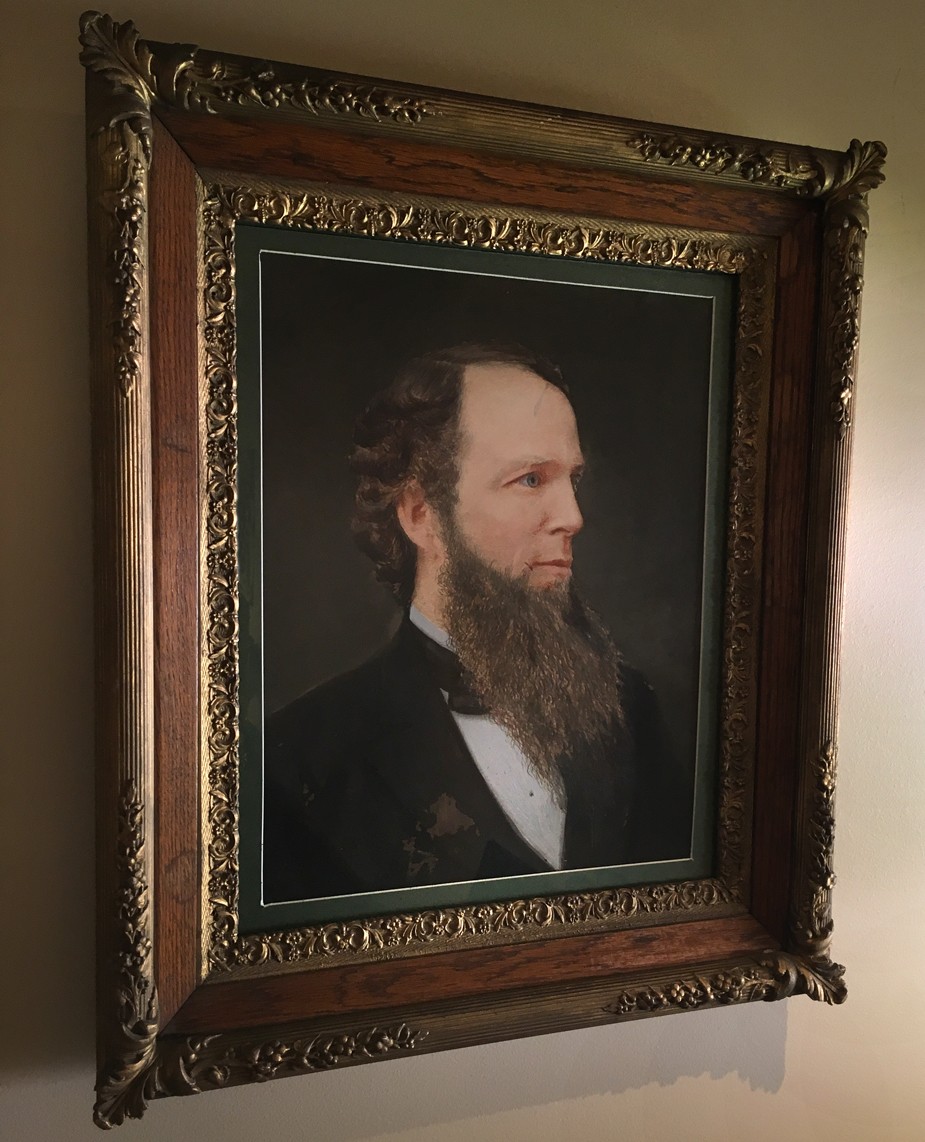 “Portrait of John Lee Cole”: Henry Ravell, American: 1864-1930. Ca. 1885 Gouache and or Oil? on paper, mounted within period wood frame bearing inscription “John L. Cole to Jason Parker, 1918”. This very rare example of a surviving painting by photographer Henry Ravell is now owned by the Museum of Wayne County History in Lyons, New York. Cole was a 1859 graduate of Yale and grandson of the Rev. John Cole, a founder with John Wesley of the Methodist Church in the U.S.. In 1862 he was admitted to the bar and later became a banker in Lyons for Mirick & Cole. An earlier 1882 notice of Henry’s artistic pursuits was published in The Democrat and Chronicle newspaper of Rochester, New York: “Henry Ravell, of Lyons, was in this city last night, on his return from Medina, (New York-editor) where he disposed of two of his latest paintings for $70.” (November 26) Photo by David Spencer for PhotoSeed Archive- artwork courtesy Museum of Wayne County History, Lyons N.Y.
“Portrait of John Lee Cole”: Henry Ravell, American: 1864-1930. Ca. 1885 Gouache and or Oil? on paper, mounted within period wood frame bearing inscription “John L. Cole to Jason Parker, 1918”. This very rare example of a surviving painting by photographer Henry Ravell is now owned by the Museum of Wayne County History in Lyons, New York. Cole was a 1859 graduate of Yale and grandson of the Rev. John Cole, a founder with John Wesley of the Methodist Church in the U.S.. In 1862 he was admitted to the bar and later became a banker in Lyons for Mirick & Cole. An earlier 1882 notice of Henry’s artistic pursuits was published in The Democrat and Chronicle newspaper of Rochester, New York: “Henry Ravell, of Lyons, was in this city last night, on his return from Medina, (New York-editor) where he disposed of two of his latest paintings for $70.” (November 26) Photo by David Spencer for PhotoSeed Archive- artwork courtesy Museum of Wayne County History, Lyons N.Y.
At this time, Henry is said to have moved to Cuernavava Mexico, south of Mexico City, where he became a far-flung agent for the Ten Eyck & Co. firm, although a certain amount of traveling back and forth to the U.S. and the family home was probably the reality. To wit, the Minnesota State Census for 1895 lists his occupation as “artist”, claiming an American residence while living with his father, mother and younger brother, Charles Ravell Jr. in the city of St. Paul. Here his father finished out his career running a photo studio on Western Ave. from 1890-92.
During the mid 1880’s back in Lyons, a fascinating yet presently unsubstantiated account of Henry’s involvement with the development of the first Kodak camera is relevant for background on his future career as a master photographer who became a striver with his own agenda. This event is worthy of historical contemplation in the present from reminisces provided in the aforementioned posthumous biography published in 1940:
“George Eastman of Rochester, New York, was a family friend. During a visit of three or four weeks, Mr. Eastman worked on and developed his famous Kodak, with the help of my father and brother.” “Their workshop was the basement of our former home at 70 Broad Street, Lyons. Mr. Eastman offered my father stock in the Kodak Company, which he often regretted not accepting.” (2.)
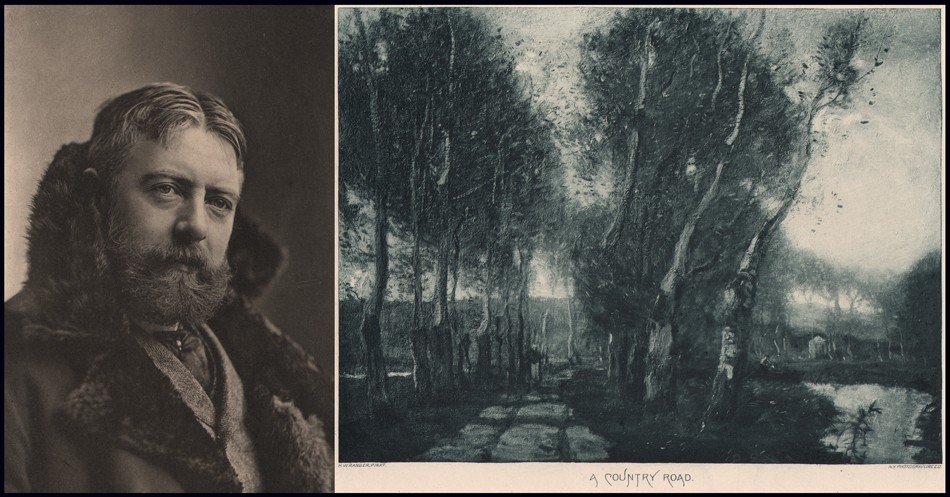 Left: “H.W. Ranger” (Henry Ward Ranger): Napoleon Sarony, American: born Quebec. (1821-1896) Photogravure published in periodical "Sun & Shade": New York: May, 1894: whole #69: N.Y. Photo-Gravure Co.: 22.4 x 15.2 | 34.9 x 27.6 cm. Like Henry Ravell assisting in his father’s studio, American artist and Tonalist Henry Ward Ranger (1858-1916) worked in his own father’s studio as a young man. Later, Ranger taught Henry water-color painting, probably when Ravell was in his late teens or early 20’s. The “Sun & Shade” periodical noting of Ranger: “His work in Lower Canada won him great repute, and as a water-color painter, before taking to oil-painting, he was undeniably excellent.” Right: “A Country Road”: Henry Ward Ranger, American. (1858-1916) Photogravure published in periodical "Sun & Shade": New York: May, 1894: whole #69: N.Y. Photo-Gravure Co.: 17.1 x 22.7 | 27.6 x 34.9 cm. Ranger’s bucolic painting style reveals itself in this simple country scene of a roadway lined with trees, probably done in Holland. Scenes like this would have undoubtedly made an impression on Henry the fledgling art student, assuming he had access to reproductions or the originals of his teacher’s work. On Ranger in the periodical: “He is an admirer and follower of the best Dutch school of art, and has made it his pleasure and his duty to pay many visits to Holland, in order to be perfectly au fait with the excellencies of its best masters.” On “A Country Road”: “It is seldom that so simple a subject becomes so important in form and color-so full of air and freedom, and so admirably harmonious in its proportions.” Both from: PhotoSeed Archive
Left: “H.W. Ranger” (Henry Ward Ranger): Napoleon Sarony, American: born Quebec. (1821-1896) Photogravure published in periodical "Sun & Shade": New York: May, 1894: whole #69: N.Y. Photo-Gravure Co.: 22.4 x 15.2 | 34.9 x 27.6 cm. Like Henry Ravell assisting in his father’s studio, American artist and Tonalist Henry Ward Ranger (1858-1916) worked in his own father’s studio as a young man. Later, Ranger taught Henry water-color painting, probably when Ravell was in his late teens or early 20’s. The “Sun & Shade” periodical noting of Ranger: “His work in Lower Canada won him great repute, and as a water-color painter, before taking to oil-painting, he was undeniably excellent.” Right: “A Country Road”: Henry Ward Ranger, American. (1858-1916) Photogravure published in periodical "Sun & Shade": New York: May, 1894: whole #69: N.Y. Photo-Gravure Co.: 17.1 x 22.7 | 27.6 x 34.9 cm. Ranger’s bucolic painting style reveals itself in this simple country scene of a roadway lined with trees, probably done in Holland. Scenes like this would have undoubtedly made an impression on Henry the fledgling art student, assuming he had access to reproductions or the originals of his teacher’s work. On Ranger in the periodical: “He is an admirer and follower of the best Dutch school of art, and has made it his pleasure and his duty to pay many visits to Holland, in order to be perfectly au fait with the excellencies of its best masters.” On “A Country Road”: “It is seldom that so simple a subject becomes so important in form and color-so full of air and freedom, and so admirably harmonious in its proportions.” Both from: PhotoSeed Archive
Memories can sometimes be suspect, but several details of Florence’s biography are important and worth following up on, with this website happy to accept the challenge. By tracking down old street addresses, the Ravell family home as published in the 1886-87 Lyons residential directory was actually found to be located as 40 Broad Street. (William Smith, whose occupation was Express Transfer Agent, lived at 70 Broad St. as published in the same directory) Coupled with the knowledge that Lyons street addresses had been renumbered, probably in the early 20th Century, and cross-referencing with a 1904 Sanborn Fire Insurance Company map found online at the Library of Congress, the former and still standing Ravell home built in 1850 revealed itself to be the present day 64 Broad Street. All of this effort, if somehow confirming a claim George Eastman had actually spent time in Lyons was true, could result in a potentially fascinating footnote to the development of one of the most important inventions of the 19th Century- The Kodak No. 1 Camera which debuted in 1888: “By far the most significant event in the history of amateur photography”, according to the Met Museum in New York City.
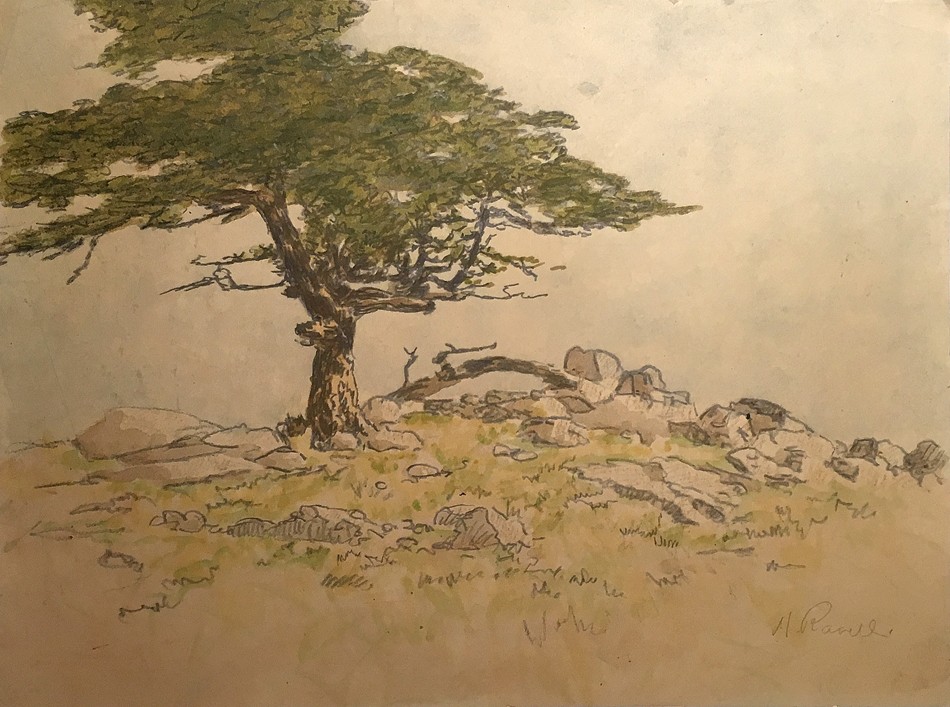 “Cypress Tree -Pebble Beach”: Henry Ravell, American: 1864-1930. Vintage watercolor drawing on paper: ca. 1915-20. (Museum of Wayne County History accession #Pi 176f with verso sticker additionally listing number 148 and $30.00) One of the few known examples of a watercolor drawing by Ravell is this delicate landscape featuring a lone cypress tree springing from a rock outcropping in Pebble Beach on California’s Monterey Peninsula. It may depict the world famous “Lone Cypress”, an approximately 250 year-old Monterey Cypress standing today on a granite hillside off the famed 17-Mile Drive. Courtesy: Museum of Wayne County History, Lyons N.Y.
“Cypress Tree -Pebble Beach”: Henry Ravell, American: 1864-1930. Vintage watercolor drawing on paper: ca. 1915-20. (Museum of Wayne County History accession #Pi 176f with verso sticker additionally listing number 148 and $30.00) One of the few known examples of a watercolor drawing by Ravell is this delicate landscape featuring a lone cypress tree springing from a rock outcropping in Pebble Beach on California’s Monterey Peninsula. It may depict the world famous “Lone Cypress”, an approximately 250 year-old Monterey Cypress standing today on a granite hillside off the famed 17-Mile Drive. Courtesy: Museum of Wayne County History, Lyons N.Y.
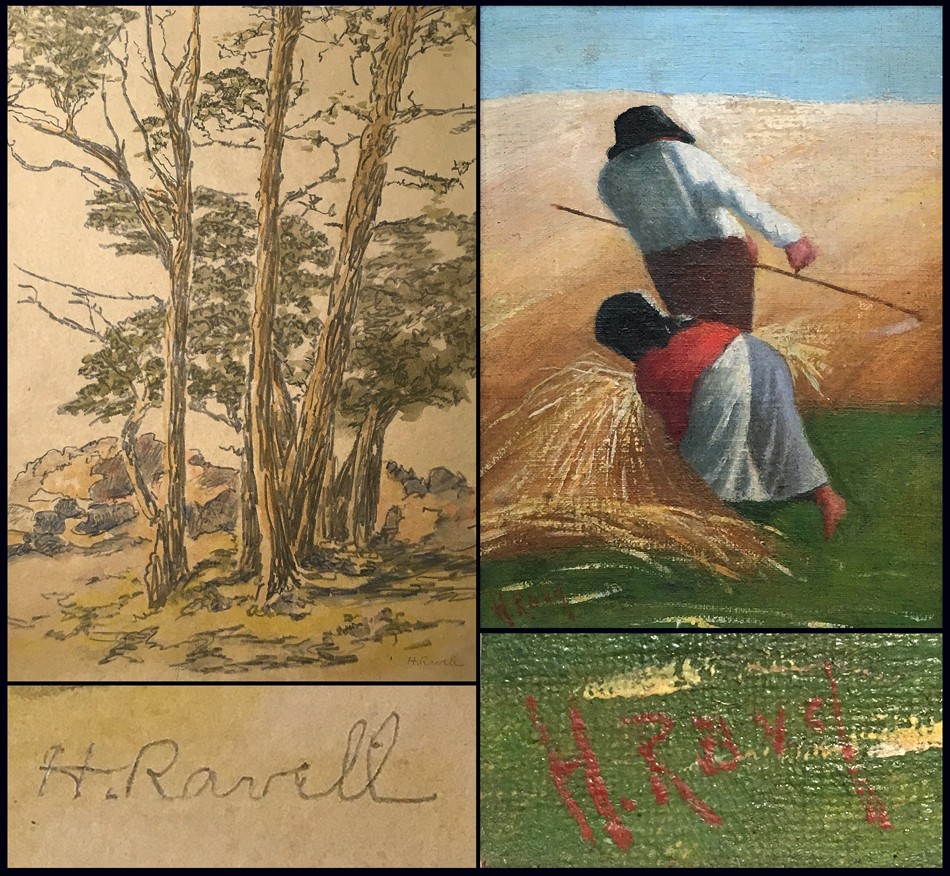 This panel reveals the artistic styles of two distinct artists signing their work nearly identically. It’s presented with the hope a distinction can be made for a larger audience. The reality at present: nearly every painting returned on web searches is misattributed to being by photographer/artist Henry Ravell. Left Diptych: Top: “Cypress Trees at Pebble Beach”: Henry Ravell, American: 1864-1930. Vintage watercolor drawing on paper: ca. 1915-20. (Museum of Wayne County History accession #Pi 176e with verso sticker additionally listing number 147 and $20.00) This is one of three rare watercolor drawings by Ravell. Showing a stand of cypress trees in Pebble Beach on California’s Monterey Peninsula, the signature of “H.Ravell” in graphite has been enlarged in separate bottom panel. Courtesy: Museum of Wayne County History. Right Diptych: Top: “The Ripers” (The Reapers): Henry Etienne Ravel, American, born Naples Italy to French citizens. (1872-1962) Oil on artists board: ca. 1946: 20.5 x 15.4 presented within wood frame (not shown) 24.5 x 19.4 x 2.0 cm. Two field workers harvest wheat, a small landscape most likely depicting the Italian countryside. Henry Ravel immigrated to America in 1906 and became a naturalized US citizen in 1920. A transportation clerk by trade in the early 1920’s, his paintings- many done in Europe- date from ca. 1930’s-1950’s. Enlarged signature at bottom panel: “H. Ravel”. From: PhotoSeed Archive
This panel reveals the artistic styles of two distinct artists signing their work nearly identically. It’s presented with the hope a distinction can be made for a larger audience. The reality at present: nearly every painting returned on web searches is misattributed to being by photographer/artist Henry Ravell. Left Diptych: Top: “Cypress Trees at Pebble Beach”: Henry Ravell, American: 1864-1930. Vintage watercolor drawing on paper: ca. 1915-20. (Museum of Wayne County History accession #Pi 176e with verso sticker additionally listing number 147 and $20.00) This is one of three rare watercolor drawings by Ravell. Showing a stand of cypress trees in Pebble Beach on California’s Monterey Peninsula, the signature of “H.Ravell” in graphite has been enlarged in separate bottom panel. Courtesy: Museum of Wayne County History. Right Diptych: Top: “The Ripers” (The Reapers): Henry Etienne Ravel, American, born Naples Italy to French citizens. (1872-1962) Oil on artists board: ca. 1946: 20.5 x 15.4 presented within wood frame (not shown) 24.5 x 19.4 x 2.0 cm. Two field workers harvest wheat, a small landscape most likely depicting the Italian countryside. Henry Ravel immigrated to America in 1906 and became a naturalized US citizen in 1920. A transportation clerk by trade in the early 1920’s, his paintings- many done in Europe- date from ca. 1930’s-1950’s. Enlarged signature at bottom panel: “H. Ravel”. From: PhotoSeed Archive
The earliest published references to Ravell’s photographic work in the popular press is found around 1905, when Boston’s Photo-Era, writing for their December issue, pronounces him “A new star of the first magnitude”, although noting his two pictures: “Pleasant Valley” and “Viga Canal”, “do not represent him at his best.” This assessment also including listing him on the journal’s noteworthy list of exhibitors whose work had been accepted for the Second American Photographic Salon which ran from 1905-06.
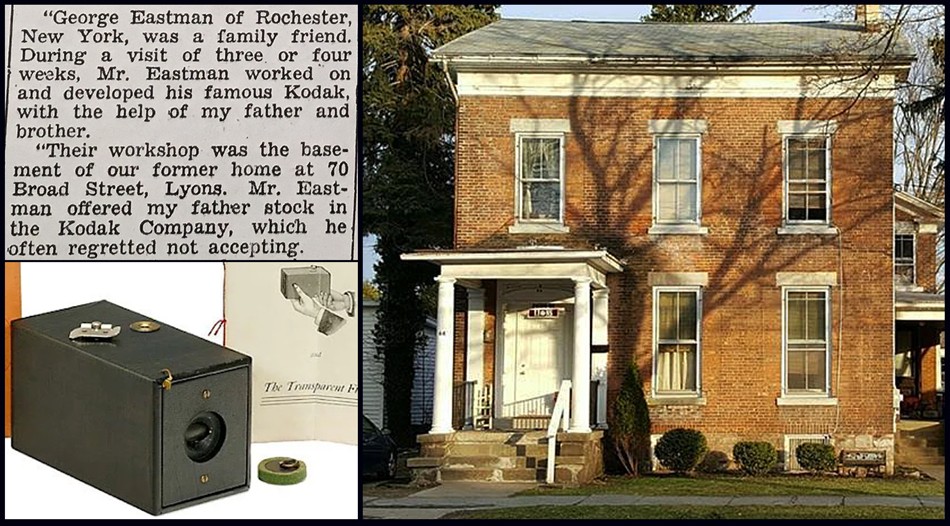 Upper Left: This quote by Henry Ravell’s older sister Florence Ravell Lothrop appeared in The Lyons Republican & Clyde Times on March 21, 1940 stating Henry and their father Charles Henry Ravell had worked with a young George Eastman in developing the world’s first Kodak camera from 1888 in the basement workshop of their Lyons home. Clipping courtesy Museum of Wayne County History. Lower Left: An original Kodak No. 1 camera from 1888 shown with its lens cap and original documents appeared as Lot 0238 and sold by Auction Team Breker of Cologne, Germany on September 30, 2006. The Metropolitan Museum of Art in New York states: “By far the most significant event in the history of amateur photography was the introduction of the Kodak #1 camera in 1888. Invented and marketed by George Eastman (1854–1932), a former bank clerk from Rochester, New York, the Kodak was a simple box camera that came loaded with a 100-exposure roll of film”. Courtesy Auction Team Breker. Far Right: Built in 1850, the former Ravell family home in Lyons, New York was actually located at 64 Broad Street-seen here: not 70 Broad Street as stated in the clipping. The actual address was confirmed by this website using Sanborn fire insurance maps and a Lyons residential street directory from 1886-7. Home exterior courtesy 2018 online real estate sales listing.
Upper Left: This quote by Henry Ravell’s older sister Florence Ravell Lothrop appeared in The Lyons Republican & Clyde Times on March 21, 1940 stating Henry and their father Charles Henry Ravell had worked with a young George Eastman in developing the world’s first Kodak camera from 1888 in the basement workshop of their Lyons home. Clipping courtesy Museum of Wayne County History. Lower Left: An original Kodak No. 1 camera from 1888 shown with its lens cap and original documents appeared as Lot 0238 and sold by Auction Team Breker of Cologne, Germany on September 30, 2006. The Metropolitan Museum of Art in New York states: “By far the most significant event in the history of amateur photography was the introduction of the Kodak #1 camera in 1888. Invented and marketed by George Eastman (1854–1932), a former bank clerk from Rochester, New York, the Kodak was a simple box camera that came loaded with a 100-exposure roll of film”. Courtesy Auction Team Breker. Far Right: Built in 1850, the former Ravell family home in Lyons, New York was actually located at 64 Broad Street-seen here: not 70 Broad Street as stated in the clipping. The actual address was confirmed by this website using Sanborn fire insurance maps and a Lyons residential street directory from 1886-7. Home exterior courtesy 2018 online real estate sales listing.
Florence Ravell, quoting Lockwood de Forest for her 1940 article on Henry, expanded on her brothers new found respect in the profession, particularly in his mastery of the gum print, which would soon establish him as a major talent:
“Henry Ravell was recognized as one of the leading artists in his profession, both in this country and in Europe where he had exhibited, and has been a contributor to many of the photographic magazines, where a description of his technical processes are given. He succeeded in making a gum print in one printing with results far beyond the finest etchings and very similar in character.”
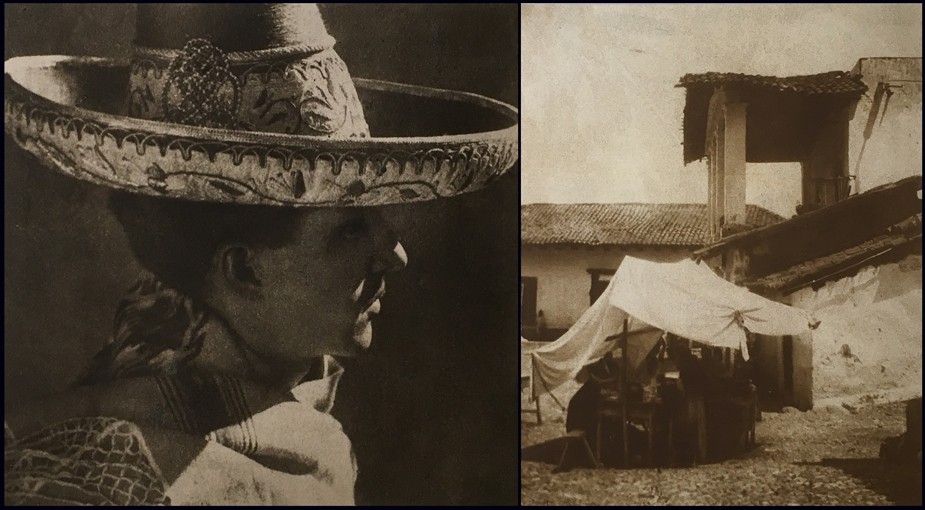 Left: “Mexican Peon”: Henry Ravell, American: 1864-1930. Vintage gum print ca. 1900-15. Alternately titled “A Mexican Peon” as listed in the catalogue of a 1978 retrospective of the artist at the Museum of Wayne County History, although an uncropped variant titled “Mexican Charro” (Mexican Cowboy)- is a more accurate description based on his fancily embroidered sombrero- is held by the California Museum of Photography, Riverside. Right: “Eating Tent-Taxco, Mexico”: Henry Ravell, American: 1864-1930. Vintage gum print ca. 1900-15. These photographs are part of a grouping of 18 singular gum prints featuring Mexican scenes and subjects held in the collection of the Museum of Wayne County History, Lyons N.Y.
Left: “Mexican Peon”: Henry Ravell, American: 1864-1930. Vintage gum print ca. 1900-15. Alternately titled “A Mexican Peon” as listed in the catalogue of a 1978 retrospective of the artist at the Museum of Wayne County History, although an uncropped variant titled “Mexican Charro” (Mexican Cowboy)- is a more accurate description based on his fancily embroidered sombrero- is held by the California Museum of Photography, Riverside. Right: “Eating Tent-Taxco, Mexico”: Henry Ravell, American: 1864-1930. Vintage gum print ca. 1900-15. These photographs are part of a grouping of 18 singular gum prints featuring Mexican scenes and subjects held in the collection of the Museum of Wayne County History, Lyons N.Y.
Henry perfected the gum bichromate process to a very high level. Probably in 1906-07, he began experimenting in multiple color gum. In Germany, around this same time, similar examples were being done by the brothers Theodor (1868-1943) and Oscar Hofmeister, (1871-1937) as well as Heinrich Wilhelm Müller (1859-1933) (3.) The following quote in the December,1908 issue of Boston’s Photo-Era encapsulates the admiration these gum prints received:
“It will be remembered that last summer Henry Ravell, of Mexico, exhibited in New York and Boston his results in multiple gum-bichromate printing in color. They excited considerable interest at the time, especially among our painters, who were very cordial in their praise of Mr. Ravell’s beautiful work, for it showed, in an eminent degree, the artistic possibilities of the gum-process.” (p. 300)
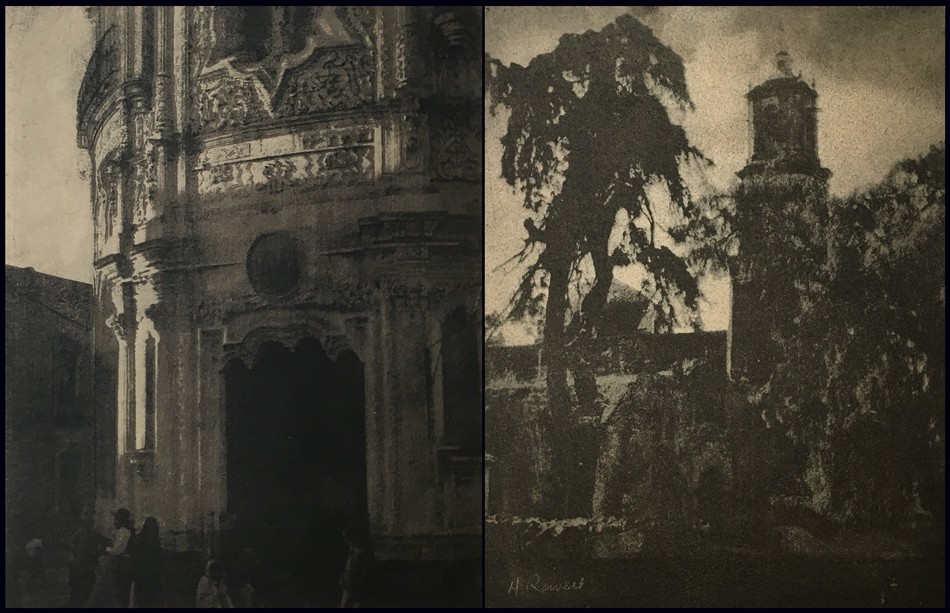 Left: “Chapel of the Holy Well near Mexico City”: Henry Ravell, American: 1864-1930. Vintage gum print ca. 1900-15. Right: “Church, Mexico”: Henry Ravell, American: 1864-1930. Vintage gum print ca. 1900-15. Museum of Wayne County History accession #Pi 176p with verso sticker additionally listing number 2 and $5.00) Featuring church architecture, these are part of a grouping of 18 singular gum prints of Mexican scenes and subjects held in the collection of the Museum of Wayne County History, Lyons N.Y.
Left: “Chapel of the Holy Well near Mexico City”: Henry Ravell, American: 1864-1930. Vintage gum print ca. 1900-15. Right: “Church, Mexico”: Henry Ravell, American: 1864-1930. Vintage gum print ca. 1900-15. Museum of Wayne County History accession #Pi 176p with verso sticker additionally listing number 2 and $5.00) Featuring church architecture, these are part of a grouping of 18 singular gum prints of Mexican scenes and subjects held in the collection of the Museum of Wayne County History, Lyons N.Y.
Again writing in 1940, Florence wrote of her younger brother: “but his favorite work was photography, and the gum print process. This process was original with an Austrian who refused to make it known, but Henry experimented until he developed it, and later gave the formula to the world.” The conjecture of this website is the possibility Henry originally gleaned and modified his own multiple gum color process from the earlier work of Austrian photographer Heinrich Kühn. (1866-1944) An 1897 example of a three-color gum print by him can be found in the collection of the Museum für Kunst und Gewerbe in Hamburg Germany.
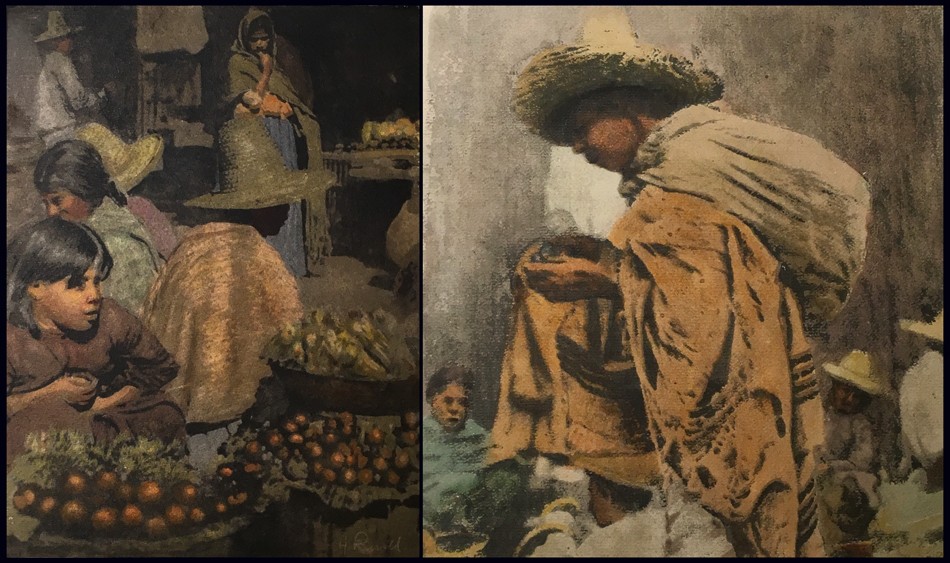 Left: “Mexican Vegetable Seller”: Henry Ravell, American: 1864-1930. Vintage multiple color gum print c. 1907-14. Right: “Mexican Youth”: Henry Ravell, American: 1864-1930. Vintage multiple color gum print c. 1907-14. These are two of the three rare multiple color gum prints by Henry Ravell held in the collection of the Museum of Wayne County History, Lyons N.Y.
Left: “Mexican Vegetable Seller”: Henry Ravell, American: 1864-1930. Vintage multiple color gum print c. 1907-14. Right: “Mexican Youth”: Henry Ravell, American: 1864-1930. Vintage multiple color gum print c. 1907-14. These are two of the three rare multiple color gum prints by Henry Ravell held in the collection of the Museum of Wayne County History, Lyons N.Y.
In 1908, Henry’s champion Lockwood de Forest gave a fuller explanation of the technical details for this color process, as part of copy included with a series of Mexican Church studies published in the May issue of the Century Illustrated Monthly Magazine:
“Last summer he started experiments in color-printing. His process is simple. Instead of introducing colors on the negatives, as in the lumière process, he is using the colors in the sensitizer of the printing paper. The specimens he has sent me are printed in three or four colors. Each print is finished, recoated all over with the sensitizer with the next color, and again printed. This is done for each color separately, the black print coming last, as in the regular color-printing process.”
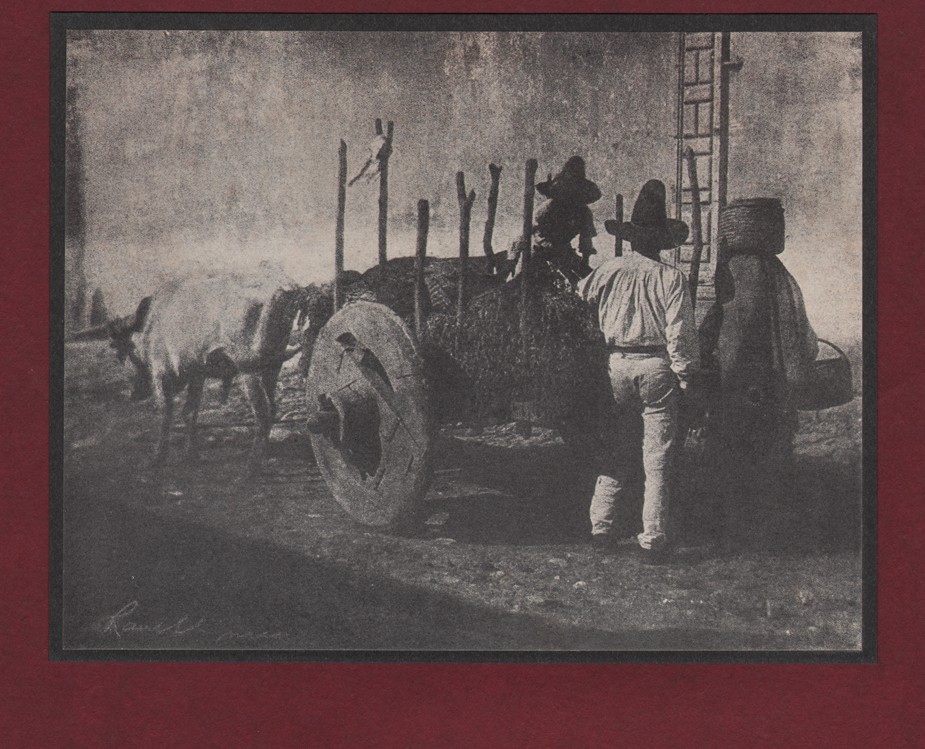 “An Ox Cart” (Mexico): Henry Ravell, American: 1864-1930. 1905: Vintage halftone tipped to mount: 16.6 x 21.4 | 17.4 x 22.2 | 45.0 x 30.5 cm “This mount is Sultan Bokhara and Royal Melton Egyptine Made by the Niagara Paper Mills”. Taken in Mexico ca. 1900-05, this is one of the earliest published examples of a Ravell photograph to appear in the popular press. It was included in the luxury portfolio publication “Art in Photography” issued by the Photo Era Publishing Company of Boston. From: PhotoSeed Archive
“An Ox Cart” (Mexico): Henry Ravell, American: 1864-1930. 1905: Vintage halftone tipped to mount: 16.6 x 21.4 | 17.4 x 22.2 | 45.0 x 30.5 cm “This mount is Sultan Bokhara and Royal Melton Egyptine Made by the Niagara Paper Mills”. Taken in Mexico ca. 1900-05, this is one of the earliest published examples of a Ravell photograph to appear in the popular press. It was included in the luxury portfolio publication “Art in Photography” issued by the Photo Era Publishing Company of Boston. From: PhotoSeed Archive
Ravell continued to work in Mexico until about 1914, when it is believed he moved back to the Los Angeles area of California in order to escape the Civil War (Mexican Revolution) then engulfing the country. A short biography included in the 1978 volume Pictorial Photography in Britain 1900-1920 gives 1916 as a slightly later date, although it was likely he was traveling back and forth from Mexico to the U.S. several times during this tumultuous time:
“In 1916 an article entitled “Cathedrals of Mexico”, illustrated by his work, was published in Harper’s magazine. About this time he left Mexico, almost as a refugee. His studio in Cuernavaca was destroyed by rebels. He moved to California where he began to photograph near Carmel and settled at Santa Barbara.”
Now that this American born “refugee” was back in his home country for good, he immediately set out photographing the beauty of the southern California coastline, with an emphasis on capturing the numerous entanglements of old cypress trees set against the landscape and Pacific Ocean. Conveniently, and perhaps not coincidentally, Lockwood de Forest had moved permanently to Santa Barbara in 1915 after wintering in the area since 1902, with his professional connections to the world of art giving Henry and his work credibility and entrance to a larger audience. These included retrospective exhibitions of nearly 100 framed works of his Mexican and California subjects at major American institutions. These began in October, 1918 at the Pratt Institute Art Gallery in Brooklyn and continued into 1919 at the Albright Art Gallery in Buffalo, New York followed by shows the same year at the newly opened Cleveland Museum of Art and then at the Chicago Art Institute.
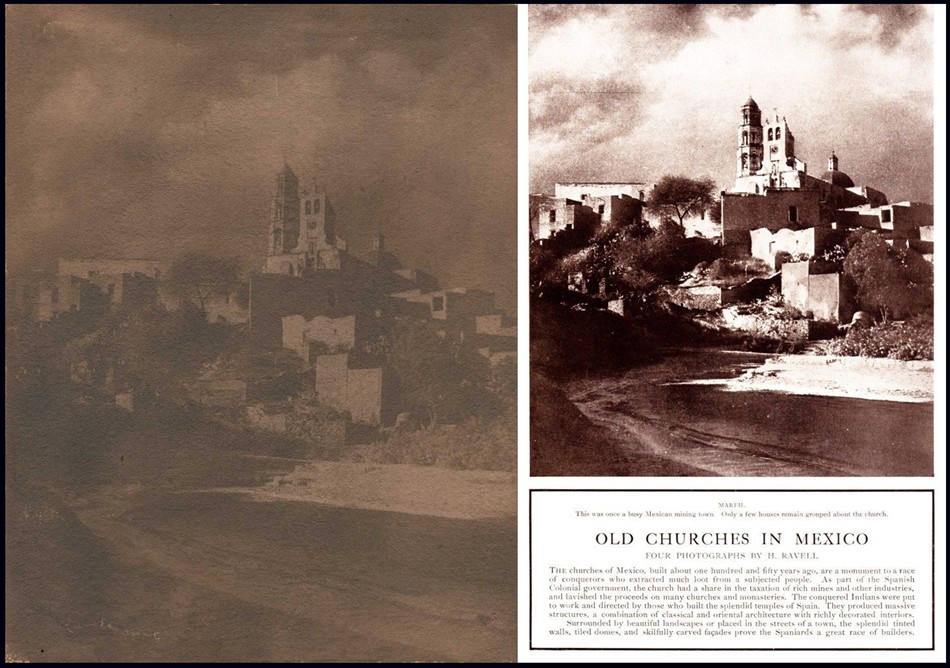 Left: “Marfil: Templo De Marfil De Arriba”: Henry Ravell, American: 1864-1930. Vintage gum print c. 1900-10: 37.4 x 29.0 cm. Still standing today, this church constructed in the Baroque style is located in Marfil, a suburb of the central Mexican city of Guanajuato. The church is colloquially known as “La Iglesia de Arriba”, or the “Church up Top”. From: PhotoSeed Archive Right: Four photographs of Mexican churches by Henry Ravell, including the Templo De Marfil De Arriba photograph, were published in the February, 1914 issue of Century Magazine for a picture spread titled “Old Churches in Mexico”: “The churches of Mexico, built about one hundred and fifty years ago, are a monument to a race of conquerors who extracted much loot from a subjected people. As part of the Spanish Colonial government, the church had a share in the taxation of rich mines and other industries, and lavished the proceeds on many churches and monasteries. The conquered Indians were put to work and directed by those who built the splendid temples of Spain. They produced massive structures, a combination of classical and oriental architecture with richly decorated interiors. Surrounded by beautiful landscapes or placed in the streets of a town, the splendid tinted walls, tiled domes, and skilfully carved facades prove the Spaniards a great race of builders.” From: Internet Archive
Left: “Marfil: Templo De Marfil De Arriba”: Henry Ravell, American: 1864-1930. Vintage gum print c. 1900-10: 37.4 x 29.0 cm. Still standing today, this church constructed in the Baroque style is located in Marfil, a suburb of the central Mexican city of Guanajuato. The church is colloquially known as “La Iglesia de Arriba”, or the “Church up Top”. From: PhotoSeed Archive Right: Four photographs of Mexican churches by Henry Ravell, including the Templo De Marfil De Arriba photograph, were published in the February, 1914 issue of Century Magazine for a picture spread titled “Old Churches in Mexico”: “The churches of Mexico, built about one hundred and fifty years ago, are a monument to a race of conquerors who extracted much loot from a subjected people. As part of the Spanish Colonial government, the church had a share in the taxation of rich mines and other industries, and lavished the proceeds on many churches and monasteries. The conquered Indians were put to work and directed by those who built the splendid temples of Spain. They produced massive structures, a combination of classical and oriental architecture with richly decorated interiors. Surrounded by beautiful landscapes or placed in the streets of a town, the splendid tinted walls, tiled domes, and skilfully carved facades prove the Spaniards a great race of builders.” From: Internet Archive
Henry Ravell would continue to exhibit his work late into the 1920’s at smaller venues, one example being a tri-colored gum print titled “Mexican Peon Boy” shown at the 1927 Los Angeles Salon and remarked on by Camera Craft, his gum prints deemed “for which he has gained a warranted renown”. Gum printing was indeed so important to the artist that he listed “Gum Printer” as his occupation for the 1920 U.S. Census.
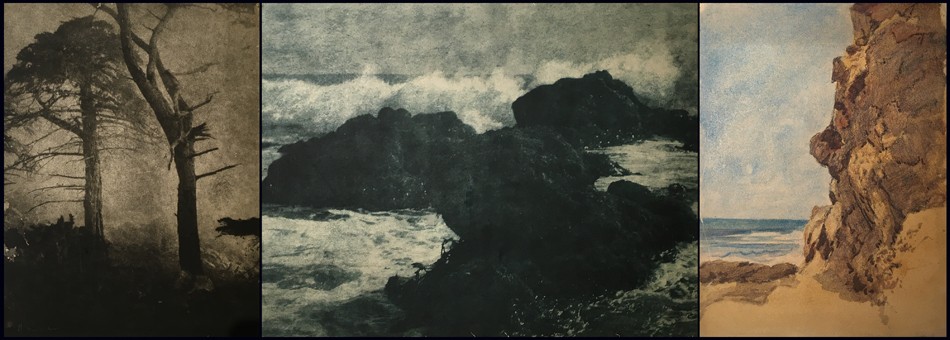 Left: “Pine and Cypress, Pebble Beach”: Henry Ravell, American: 1864-1930. Vintage gum print ca. 1915-20. (Museum of Wayne County History accession #Pi 176a with verso sticker additionally listing number 17 and $3.00) Middle: “Big Splash” (California coastline) Henry Ravell, American: 1864-1930. Vintage gum print ca. 1915-20. (Museum of Wayne County History accession #Pi 176m with verso sticker additionally listing number 122 and $12.00) Right: “Untitled Marine Landscape” (Mexico or California): Henry Ravell, American: 1864-1930. Vintage multiple colored gum print ca. 1907-1920. (Museum of Wayne County History accession #Pi 176n with verso sticker additionally listing number 156 ) All: Courtesy Museum of Wayne County History, Lyons N.Y.
Left: “Pine and Cypress, Pebble Beach”: Henry Ravell, American: 1864-1930. Vintage gum print ca. 1915-20. (Museum of Wayne County History accession #Pi 176a with verso sticker additionally listing number 17 and $3.00) Middle: “Big Splash” (California coastline) Henry Ravell, American: 1864-1930. Vintage gum print ca. 1915-20. (Museum of Wayne County History accession #Pi 176m with verso sticker additionally listing number 122 and $12.00) Right: “Untitled Marine Landscape” (Mexico or California): Henry Ravell, American: 1864-1930. Vintage multiple colored gum print ca. 1907-1920. (Museum of Wayne County History accession #Pi 176n with verso sticker additionally listing number 156 ) All: Courtesy Museum of Wayne County History, Lyons N.Y.
The Albright Art Gallery was an important venue for Ravell’s work, considering the groundbreaking exhibition it previously hosted in November, 1910: the International Exhibition of Pictorial Photography. Organized by the Photo-Secession under the direction of Alfred Stieglitz, it was “the first exhibition held at an American museum that aimed to elevate photography’s stature from a purely scientific pursuit to a visual form of artistic expression.” Even nine years later, in 1919, at a time when museum shows devoted to the work of a singular photographer anywhere in the world were still few and far between and remained so decades later, it’s refreshing in the present to read observations by one curator remarking on Ravell’s 93 framed photographs displayed at the Albright gallery for Academy Notes, the mouthpiece for The Buffalo Fine Arts Academy:
“THE collection of photographs by H. Ravell—which was on view in the gallery during the last week in February and all of March—is very unique and valuable. These photographs are technically known as gum-prints and have all the painter’s quality in their execution. They do not impress one as photographs but rather as work directly from the artist’s brush. The photographs were made by H. Ravell who is now in Santa Barbara. Many of the pictures were taken near Carmel, California, a seashore of much variety where the fantastic cypress trees with their twisted dramatic forms produce wonderful compositions against sea and sky.” …This is but a short description of the remarkable exhibition of photographs shown at the Albright Art Gallery. It was seen by many art lovers and appreciated especially by all of those interested in artistic photography.” (4.)
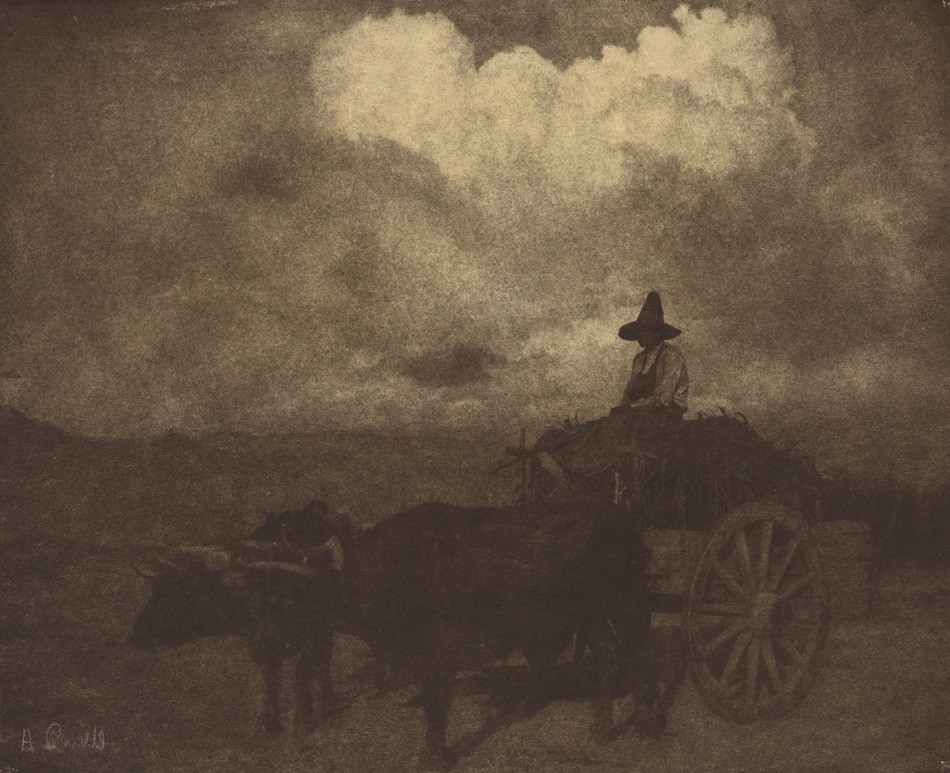 “Ox Cart- Sunset”: Henry Ravell, American: 1864-1930. Vintage gum print ca. 1900-10. Image: 27.0 x 32.6 cm presented loose within dark brown paper folder with overall support dimensions of 58.8 x 36.7 cm. Wearing a traditional sombrero hat, (Sombrero de charro) the driver of this ox or bullock cart pauses atop a full load of what looks like hay or silage. This Mexican scene may date to around 1905-consistent with a different view by the artist of an ox cart published that year in “Art in Photography” by the the Photo Era Publishing Company of Boston. From: PhotoSeed Archive
“Ox Cart- Sunset”: Henry Ravell, American: 1864-1930. Vintage gum print ca. 1900-10. Image: 27.0 x 32.6 cm presented loose within dark brown paper folder with overall support dimensions of 58.8 x 36.7 cm. Wearing a traditional sombrero hat, (Sombrero de charro) the driver of this ox or bullock cart pauses atop a full load of what looks like hay or silage. This Mexican scene may date to around 1905-consistent with a different view by the artist of an ox cart published that year in “Art in Photography” by the the Photo Era Publishing Company of Boston. From: PhotoSeed Archive
A reevaluation of Henry Ravell’s body of work is important to consider in the present given the broad acknowledgement of his talent by major institutions and the popular press for the benefit of many large audiences over 100 years ago. An important pictorialist photographer who was also a painter, Henry Ravell was a striver and apprentice graduate inspired by his father’s steady trade in the New York state village of Lyons who embraced a love for craft and mastery of art. Together, these skills gave him the passion to embrace adventure in capturing the beauty in far-off Mexico and southern California for the ages.
Four original gum prints in the PhotoSeed Archive can be seen here, each listing an expanded biography, timeline and major institutional holdings for the artist.
Afterword | Notes
A conundrum on internet research into Henry Ravell’s artistic output reveals itself quickly. The bottom line is that most every painting on the web attributed to Henry Ravell the photographer is not by him. Instead, through PhotoSeed’s research and purchase of the small painting: “The Ripers”, (The Reapers) the true identity of this artist can now be revealed as Henry Etienne Ravel. (1872-1962) Born in Naples Italy to French citizens, Henry Ravel immigrated to America in 1906 and became a naturalized US citizen in 1920. A transportation clerk by trade in the early 1920’s, his paintings- many done in Europe- date from ca. 1930’s-1950’s. What causes the confusion is that like Henry Ravell the photographer, who signed his photographs “H. Ravell”, Henry Ravel the painter also signed his work similarly, but as “H. Ravel” Numerous examples of his paintings show up on Google searches-unlike the real and quite rare examples of watercolors done by Ravell the photographer. I’ve included links to some of these paintings on the page showing “The Ripers”. As always- buyer beware and do your homework!
1. C. Ravel won a $3.00 premium for “Best Daguerreotypes” during the Annual Fair of the Madison County Agricultural Society held at Morrisville, (N.Y.) on the 15th, 16th and 17th days of September,1857 according to a newspaper account in the Cazenovia Republican. Shout out to the Pioneer American Photographers 1839-1860 website. Langdon’s List of 19th & Early 20th Century Photographers additionally list Ravel working in Manlius, New York in the 1859 N.Y. State Business Directory.
2. See: The Lyons Republican & Clyde Times: Lyons, N.Y. Thursday, March 21, 1940. Article excerpts: HENRY RAVELL: “Resided in Lyons for twenty-eight years, died in Los Angeles California, January 20, 1930. This account was written by his sister, Mrs. Florence Ravell Lothrop, of 721 Fifth Street North, St. Petersburg, Florida.: “Henry had no special training in any school or under any masters except my father, Charles Herring Ravel, who was born in Boston, England, and became one of the first photographers in the United States. His forbears came over with William the Conqueror to England, which accounts for the one “L” in the name. My mother was annoyed because most people called her Mrs. Rav’-el and persuaded my father to add “L”, so the family adopted that spelling of our name.…Henry studied and experimented all his life. His photographic subjects were portraits, landscapes, street scenes, trees, cloud and moonlight effects. His Mexican Cathedrals were especially noteworthy. He used both oils and water colors, but his favorite work was photography, and the gum print process. This process was original with an Austrian who refused to make it known, but Henry experimented until he developed it, and later gave the formula to the world. I remember seeing around his studio, pans of water about three inches deep. The photo-print was put into the water and pigments of paint dropped on it, this gave the effect when completed of a soft beautiful painting. My description to an artist will seem crude but that is as I recall it.…Henry never taught, that is, acted as a teacher in any school, and I do not know what societies he belonged. He exhibited in the Pittsburgh, Pennsylvania, Salon about 1907. From the thousands of photographs submitted, three of his were among the 237 accepted. His work was exhibited at the Salmagundi Club, New York City; Thurber’s and Anderson’s Galleries in Chicago, Los Angeles, California, and many, many other places. Fifteen of his photographs are at the Metropolitan Museum, New York City. Seven are Mexican subjects and eight are California trees. These were selected by Forest Lockwood.(sic) After Henry’s death at Los Angeles, California, in 1930, a request came for him to send an exhibit to the Fifth International Photographic Salon of Japan held at Tokyo and Osaka in May, 1931.”
3. In the December, 1908 issue of Boston’s Photo-Era, a short article titled “Gum-Prints In Colors” appeared, linking Ravell’s gum prints as being similar to “a collection of prints by the same process, probably with modifications” to work done by the Hofmeister brothers and Müller. These German works were shown at the offices of The British Journal of Photography in London’s Strand from September 28- October 24, 1907.
4. See: Academy Notes: The Buffalo Fine Arts Academy: Albright Art Gallery: Buffalo, New York: vol. XIV: Jan.-Oct. 1919, p. 67
Heaven on Earth
Posted July 2020 in New Additions, Significant Photographers, Significant Photographs
America’s birthday is best defined by the natural beauty of her National Parks, undisturbed by man’s folly.
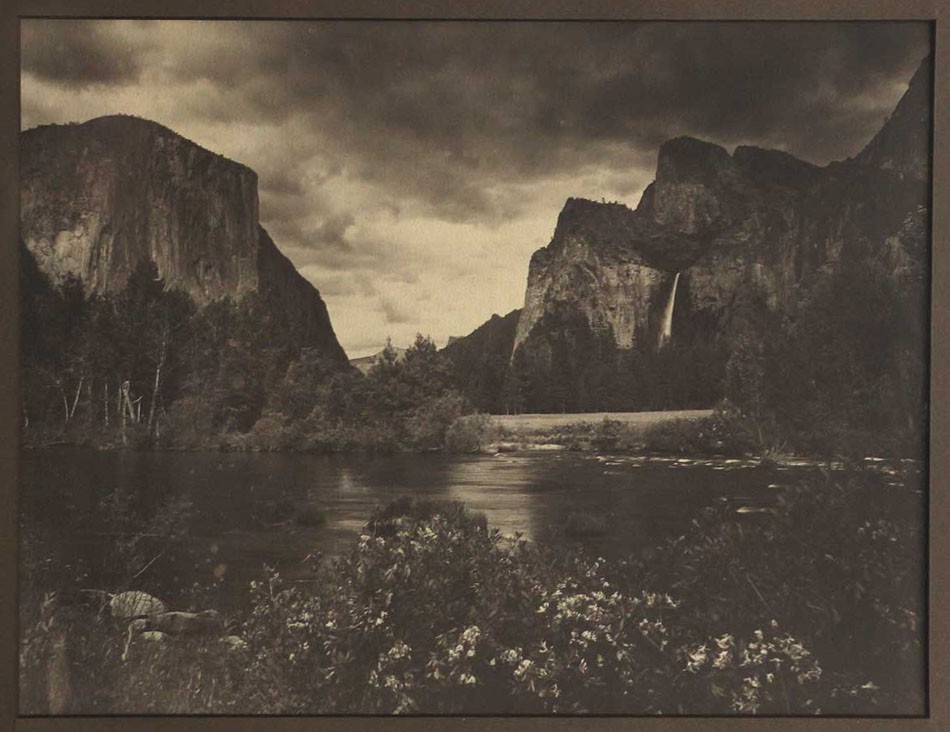 “The Gates of Yosemite”: Arthur C. Pillsbury, American: 1870-1946. Vintage bromide print c. 1915-20 (from original negative c. 1906-10) Image: 26.4 x 34.1 | 27.2 x 35.0 cm. Support: original framing: 37.9 x 45.8 hardboard primary mount | frame: stained hardwood: 40.7 x 48.5 x 1.5 cm. From the 1914 volume Yosemite and its High Sierra by John H. Williams, the following passage is reproduced along with this photograph “The Gates of Yosemite”: “Soon, quitting the narrow, cluttered wildness of the lower river, the newcomer is face to face with the ordered peace and glory of Yosemite itself. Gratefully, silently, he breathes the very magic of the Enchanted Valley. For here, fully spread before him, is that combination of sylvan charm with stupendous natural phenomena which makes Yosemite unique among Earth’s great pictures. He sees the cañon’s level floor, telling of an ancient glacial lake that has given place to wide, grassy meadows; fields of glad mountain flowers; forests of many greens and lavenders; the fascination of the winding Merced, and, gleaming high above this world of gentle loveliness, the amazing gray face of El Capitan, while Pohono drops from a ‘hanging valley’ superbly sculptured, and so beautiful that he may well deem it the noblest setting Nature has given to any of her famous waterfalls.” From: PhotoSeed Archive
“The Gates of Yosemite”: Arthur C. Pillsbury, American: 1870-1946. Vintage bromide print c. 1915-20 (from original negative c. 1906-10) Image: 26.4 x 34.1 | 27.2 x 35.0 cm. Support: original framing: 37.9 x 45.8 hardboard primary mount | frame: stained hardwood: 40.7 x 48.5 x 1.5 cm. From the 1914 volume Yosemite and its High Sierra by John H. Williams, the following passage is reproduced along with this photograph “The Gates of Yosemite”: “Soon, quitting the narrow, cluttered wildness of the lower river, the newcomer is face to face with the ordered peace and glory of Yosemite itself. Gratefully, silently, he breathes the very magic of the Enchanted Valley. For here, fully spread before him, is that combination of sylvan charm with stupendous natural phenomena which makes Yosemite unique among Earth’s great pictures. He sees the cañon’s level floor, telling of an ancient glacial lake that has given place to wide, grassy meadows; fields of glad mountain flowers; forests of many greens and lavenders; the fascination of the winding Merced, and, gleaming high above this world of gentle loveliness, the amazing gray face of El Capitan, while Pohono drops from a ‘hanging valley’ superbly sculptured, and so beautiful that he may well deem it the noblest setting Nature has given to any of her famous waterfalls.” From: PhotoSeed Archive
I am America
Posted June 2020 in Significant Photographers, Significant Photographs, Sports Photography
“I am America. I am the part you won’t recognize. But get used to me—black, confident, cocky; my name, not yours; my religion, not yours; my goals, my own. Get used to me.” ― Muhammad Ali
Remember his name: George Floyd
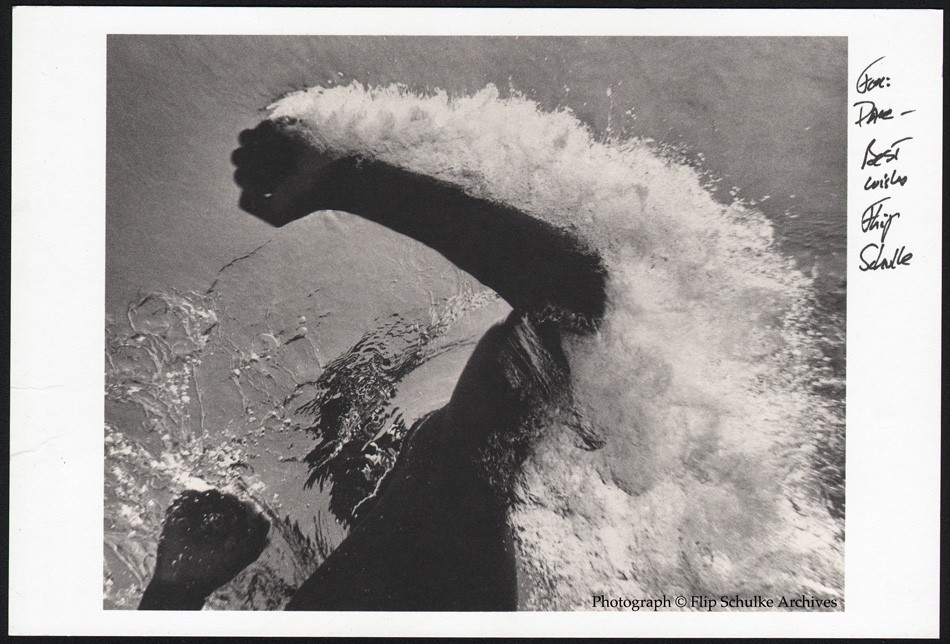 “Left Hook” (Muhammad Ali training underwater): Graeme Phelps "Flip" Schulke, American: 1930-2008: Fine Halftone ca. 1994 on manilla cardstock from original 1961 copy or source negative or print: 14.6 x 21.6 cm. (overall) Used here as a promotional gallery card for the New York City based James Danziger show: “Sport Stories: Sports photographs from 1900 to today”- February 18 - March 12, 1994. “Left Hook” was one of a series of photographs of boxer Muhammad Ali (then known as Cassius Clay) training underwater taken by American photojournalist Flip Schulke in the swimming pool of Miami’s Sir John Hotel in August, 1961. The photograph was first published of the then 19 year-old fighter in the September 8, 1961 weekly issue of Life magazine as part of a two-page spread titled “A Wet Way to Train for a Fight”. Schulke, an accomplished underwater photographer, donned Scuba gear and an underwater camera to make these photographs, learning three years later to his delight that Ali did not know how to swim at the time: “Boy, to con Life magazine! I never had an inkling that I had been taken. …To me, it shows his genius.” the photographer said for his volume “Muhammad Ali: the Birth of a Legend, Miami, 1961-1964” published in 2000. Photograph © Flip Schulke Archives. Gallery card from collection of PhotoSeed site owner signed by Schulke in 1999.
“Left Hook” (Muhammad Ali training underwater): Graeme Phelps "Flip" Schulke, American: 1930-2008: Fine Halftone ca. 1994 on manilla cardstock from original 1961 copy or source negative or print: 14.6 x 21.6 cm. (overall) Used here as a promotional gallery card for the New York City based James Danziger show: “Sport Stories: Sports photographs from 1900 to today”- February 18 - March 12, 1994. “Left Hook” was one of a series of photographs of boxer Muhammad Ali (then known as Cassius Clay) training underwater taken by American photojournalist Flip Schulke in the swimming pool of Miami’s Sir John Hotel in August, 1961. The photograph was first published of the then 19 year-old fighter in the September 8, 1961 weekly issue of Life magazine as part of a two-page spread titled “A Wet Way to Train for a Fight”. Schulke, an accomplished underwater photographer, donned Scuba gear and an underwater camera to make these photographs, learning three years later to his delight that Ali did not know how to swim at the time: “Boy, to con Life magazine! I never had an inkling that I had been taken. …To me, it shows his genius.” the photographer said for his volume “Muhammad Ali: the Birth of a Legend, Miami, 1961-1964” published in 2000. Photograph © Flip Schulke Archives. Gallery card from collection of PhotoSeed site owner signed by Schulke in 1999.
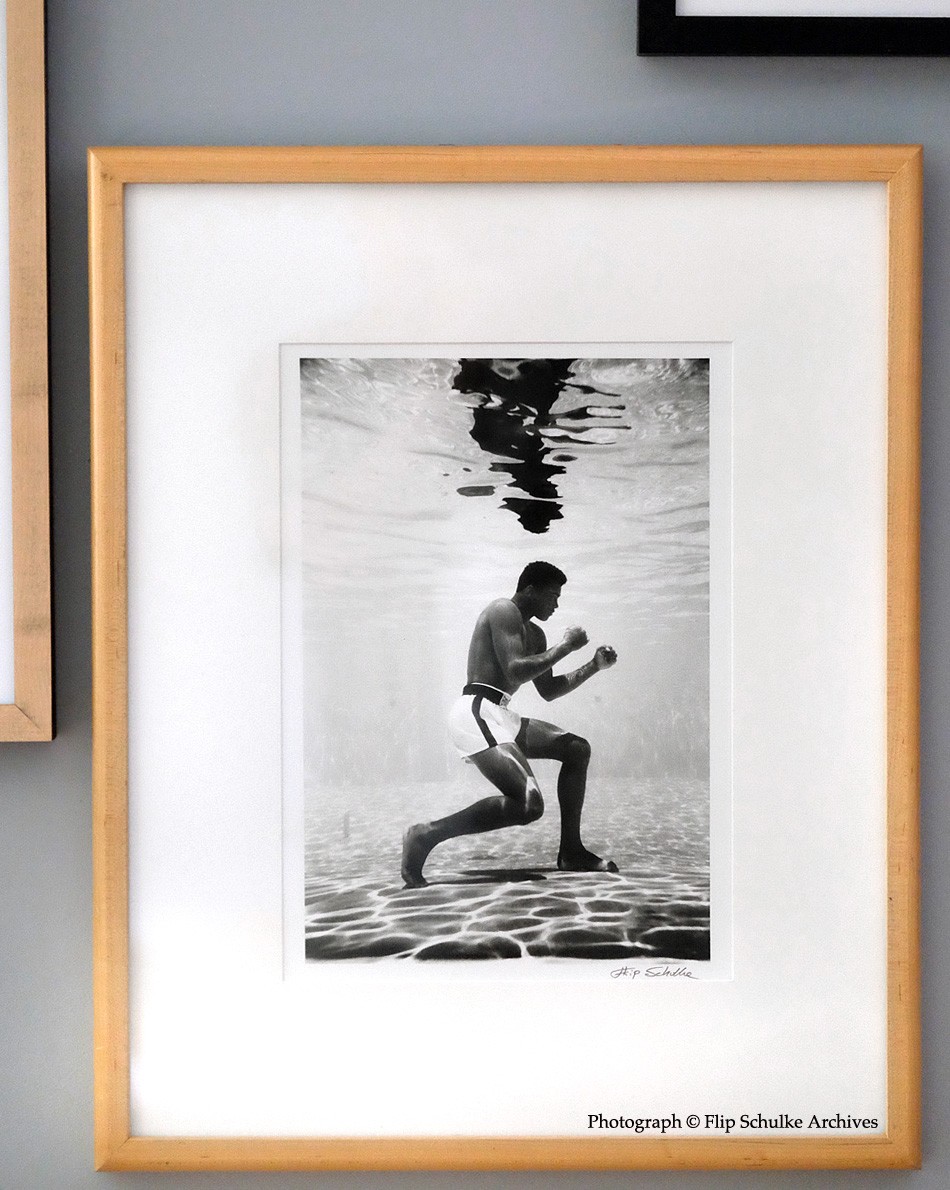 “Ali Underwater”: Graeme Phelps "Flip" Schulke, American: 1930-2008: Gelatin Silver print ca. 1999 from original 1961 source negative: 31.5 x 21.1 | 35.2 x 27.9 cm. Flip Schulke’s iconic photograph of boxer Muhammad Ali holding his breath while assuming a traditional boxing stance was one of a series of the world champion (then known as Cassius Clay) training underwater in the swimming pool of Miami’s Sir John Hotel in August, 1961. “For the picture of him standing on the bottom of the pool, he just sank down and stood on the bottom. It’s hard to do. I didn’t ask him to do it, I didn’t put any weights on him or anything. He exhaled all of his air-that’s the only way you can sink down.” the photographer said for his volume “Muhammad Ali: the Birth of a Legend, Miami, 1961-1964” published in 2000. Flip Schulke was a close friend of American Civil Rights icon Dr. Martin Luther King Jr. , and he spent more than a decade covering the movement for national magazines including Life, Time and Newsweek. These photographs were featured in three volumes by him: "Martin Luther King, Jr.: A Documentary, Montgomery to Memphis" (1976); "King Remembered" (1986); and "He Had A Dream" (1995). Other volumes by the photographer include "Underwater Photography for Everyone" (1979); "Your Future in Space: The U.S. Space Camp Training Program" (1986); "Muhammad Ali: the Birth of a Legend, Miami, 1961-1964" (2000); and "Witness to Our Times: My Life as a Photojournalist" (2003). Photograph © Flip Schulke Archives. Framed photograph from PhotoSeed Archive.
“Ali Underwater”: Graeme Phelps "Flip" Schulke, American: 1930-2008: Gelatin Silver print ca. 1999 from original 1961 source negative: 31.5 x 21.1 | 35.2 x 27.9 cm. Flip Schulke’s iconic photograph of boxer Muhammad Ali holding his breath while assuming a traditional boxing stance was one of a series of the world champion (then known as Cassius Clay) training underwater in the swimming pool of Miami’s Sir John Hotel in August, 1961. “For the picture of him standing on the bottom of the pool, he just sank down and stood on the bottom. It’s hard to do. I didn’t ask him to do it, I didn’t put any weights on him or anything. He exhaled all of his air-that’s the only way you can sink down.” the photographer said for his volume “Muhammad Ali: the Birth of a Legend, Miami, 1961-1964” published in 2000. Flip Schulke was a close friend of American Civil Rights icon Dr. Martin Luther King Jr. , and he spent more than a decade covering the movement for national magazines including Life, Time and Newsweek. These photographs were featured in three volumes by him: "Martin Luther King, Jr.: A Documentary, Montgomery to Memphis" (1976); "King Remembered" (1986); and "He Had A Dream" (1995). Other volumes by the photographer include "Underwater Photography for Everyone" (1979); "Your Future in Space: The U.S. Space Camp Training Program" (1986); "Muhammad Ali: the Birth of a Legend, Miami, 1961-1964" (2000); and "Witness to Our Times: My Life as a Photojournalist" (2003). Photograph © Flip Schulke Archives. Framed photograph from PhotoSeed Archive.Old New York Strong
Posted April 2020 in Documentary Photography, New Additions, Significant Photographers, Unknown Photographers
As New York City takes center stage for the role of viral epicenter it did not ask for, it has revealed a longstanding tenacity of spirit and resilience baked in- her very landmarks, monuments and memorials infused with the history of the shared past now standing silently yet propelling it ever forward. Combined with those higher graces of social inclusion and togetherness representing an ideal for American Democracy, these places and symbols will continue to forge and unite the connections between cultures, commerce and diasporas for the common good- in the days ahead and for the future. -David Spencer
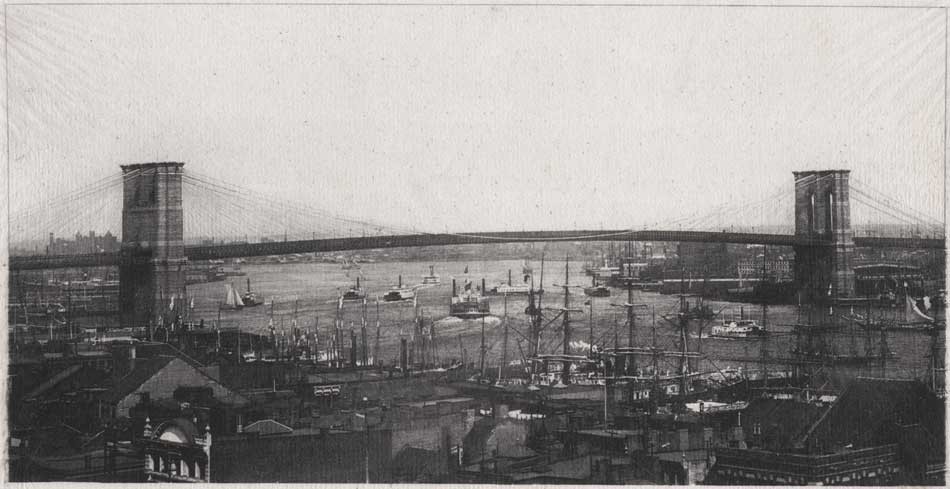 “Brooklyn Bridge”: Adolph A. Wittemann, American (1845-1938). Vintage Japan-tissue photogravure: 1889: printed ca. 1897-1900: Photogravure and Color Co. (New York): 8.8 x 17.1 | 12.6 x 19.7 cm | supports: 20.6 x 28.0 | 22.2 x 29.1 cm. Ferries and other marine craft navigate the East River in this pictorial view emphasizing the span of the famous bridge by Wittemann. Conversely, in a gelatin silver variant held by the Museum of the City of New York: “Looking over New York toward the Brooklyn Bridge”, (x2010.11.3891) the foreground frame shows a greater concentration of buildings and less river activity. In 1890,The Getty Research Institute’s Art & Architecture Thesaurus notes, Adolph Wittemann and his brother Herman would found The Albertype Company, a Brooklyn-based publisher employing the collotype (or albertype) photographic process. “The company operated from 1890 to 1952 and produced over 25,000 prints. The Albertype Company both produced their own photographs (Adolph was a photographer), as well as reproduced photographic images produced by other companies or individual photographers. Using the prints, the company published postcards and viewbooks. Viewbooks, also known as souvenir albums or view albums, are books that contain commercially published groups of photographs depicting a place, activity, or event.” From: PhotoSeed Archive
“Brooklyn Bridge”: Adolph A. Wittemann, American (1845-1938). Vintage Japan-tissue photogravure: 1889: printed ca. 1897-1900: Photogravure and Color Co. (New York): 8.8 x 17.1 | 12.6 x 19.7 cm | supports: 20.6 x 28.0 | 22.2 x 29.1 cm. Ferries and other marine craft navigate the East River in this pictorial view emphasizing the span of the famous bridge by Wittemann. Conversely, in a gelatin silver variant held by the Museum of the City of New York: “Looking over New York toward the Brooklyn Bridge”, (x2010.11.3891) the foreground frame shows a greater concentration of buildings and less river activity. In 1890,The Getty Research Institute’s Art & Architecture Thesaurus notes, Adolph Wittemann and his brother Herman would found The Albertype Company, a Brooklyn-based publisher employing the collotype (or albertype) photographic process. “The company operated from 1890 to 1952 and produced over 25,000 prints. The Albertype Company both produced their own photographs (Adolph was a photographer), as well as reproduced photographic images produced by other companies or individual photographers. Using the prints, the company published postcards and viewbooks. Viewbooks, also known as souvenir albums or view albums, are books that contain commercially published groups of photographs depicting a place, activity, or event.” From: PhotoSeed Archive
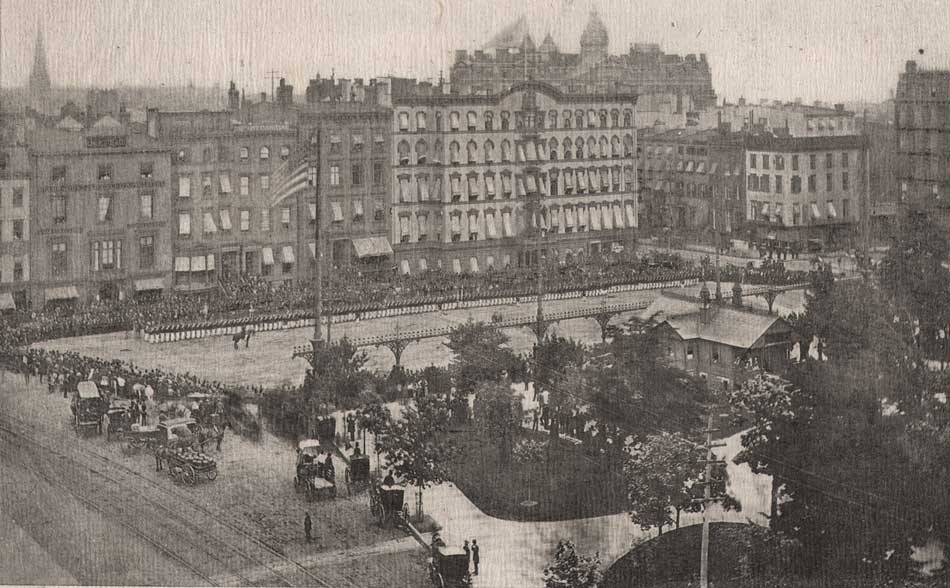 Detail: “Union Square”: unknown American photographer. Vintage Japan-tissue photogravure: ca. 1880-1900: printed ca. 1897-1900: Photogravure and Color Co. (New York): 10.8 x 16.4 | 14.5 x 18.8 cm | supports: 19.1 x 24.5 | 22.2 x 29.1 cm. Soldiers, possibly Cadets from the U.S. Military Academy at West Point, assemble in parade formation (Washington’s Birthday?) two abreast on the north side of Union Square in New York City. Everett House, a fine residential hotel that opened in 1853 at background center of photograph can be seen, and other clues might help a modern viewer more accurately date this view. They include an American flag flying at center, horse-drawn carriages at foreground left, a telegraph pole at foreground right and intact signs (upon close-magnification) on the building at far background left, directly behind the head of the line of soldiers. Located at 29 East 17th Street, it was the warehouse and shop for L. Marcotte & Co., a manufacturer and importer of fine carpets, furniture, and “looking glass plates, frames, gas fixtures, bronzes, and all articles of art”, according to an 1876 sales invoice, and is believed to have been at this location as early as 1860. From: PhotoSeed Archive
Detail: “Union Square”: unknown American photographer. Vintage Japan-tissue photogravure: ca. 1880-1900: printed ca. 1897-1900: Photogravure and Color Co. (New York): 10.8 x 16.4 | 14.5 x 18.8 cm | supports: 19.1 x 24.5 | 22.2 x 29.1 cm. Soldiers, possibly Cadets from the U.S. Military Academy at West Point, assemble in parade formation (Washington’s Birthday?) two abreast on the north side of Union Square in New York City. Everett House, a fine residential hotel that opened in 1853 at background center of photograph can be seen, and other clues might help a modern viewer more accurately date this view. They include an American flag flying at center, horse-drawn carriages at foreground left, a telegraph pole at foreground right and intact signs (upon close-magnification) on the building at far background left, directly behind the head of the line of soldiers. Located at 29 East 17th Street, it was the warehouse and shop for L. Marcotte & Co., a manufacturer and importer of fine carpets, furniture, and “looking glass plates, frames, gas fixtures, bronzes, and all articles of art”, according to an 1876 sales invoice, and is believed to have been at this location as early as 1860. From: PhotoSeed Archive
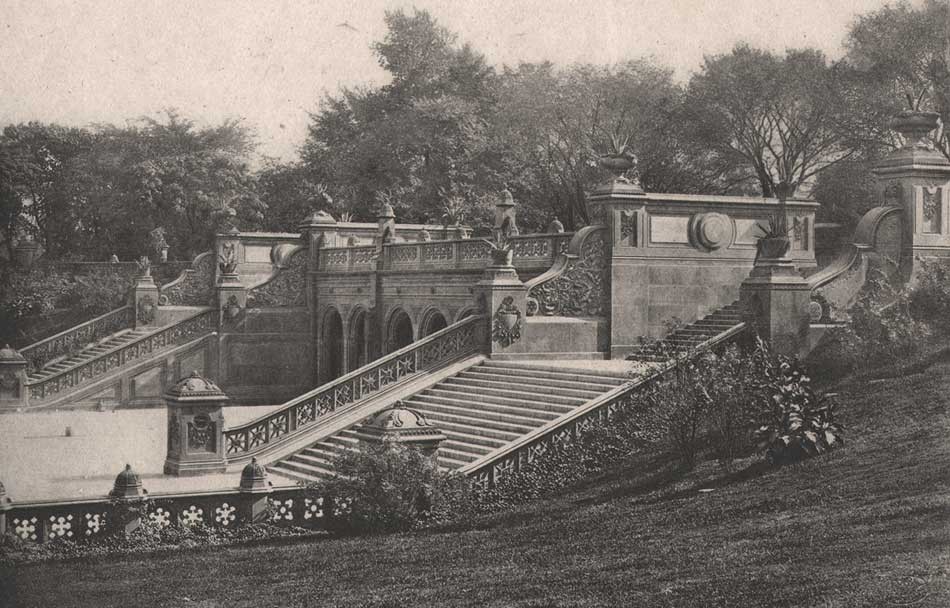 “Central Park” (Bethesda Terrace Steps): unknown American photographer. Vintage Japan-tissue photogravure: ca. 1885-1888: printed ca. 1897-1900: Photogravure and Color Co. (New York): 11.2 x 16.5 | 14.7 x 19.3 cm | supports: 19.8 x 25.3 | 22.2 x 29.1 cm. The Central Park Conservancy considers Bethesda Terrace- “the heart of Central Park and is, by design, its singular formal feature. Overlooking the Lake, it stands at the end of the Park’s long, tree-lined promenade known as the Mall. A grand staircase descends into the subterranean Arcade, which offers a welcome respite from rain and heat.” Shown in this photograph are the two flanking grand staircases for the terrace, designed by park architects Calvert Vaux with sculptural details by Jacob Wrey Mould. Although American commercial photographer John S. Johnston (c.1839-1899) was known to have documented features in Central Park in 1893-94, albeit with people in his views, this photograph, titled “Central Park-The Terrace and Grand Stairway”, first appeared in 1888 in the volume The Empire State: Its Industries and Wealth. (p.45) Later, it was included as part of a series of four architectural studies of Central Park bridges in the 1896 volume The Engineering Magazine, Vol. 11. (“The Terrace”: p. 863) The work was further published as “Terrace Steps, Central Park”- an offset color lithograph print souvenir inserted within the pages of The New York Recorder newspaper between 1891-96: see New York Public Library catalog ID (B-number): b17094307. From: PhotoSeed Archive
“Central Park” (Bethesda Terrace Steps): unknown American photographer. Vintage Japan-tissue photogravure: ca. 1885-1888: printed ca. 1897-1900: Photogravure and Color Co. (New York): 11.2 x 16.5 | 14.7 x 19.3 cm | supports: 19.8 x 25.3 | 22.2 x 29.1 cm. The Central Park Conservancy considers Bethesda Terrace- “the heart of Central Park and is, by design, its singular formal feature. Overlooking the Lake, it stands at the end of the Park’s long, tree-lined promenade known as the Mall. A grand staircase descends into the subterranean Arcade, which offers a welcome respite from rain and heat.” Shown in this photograph are the two flanking grand staircases for the terrace, designed by park architects Calvert Vaux with sculptural details by Jacob Wrey Mould. Although American commercial photographer John S. Johnston (c.1839-1899) was known to have documented features in Central Park in 1893-94, albeit with people in his views, this photograph, titled “Central Park-The Terrace and Grand Stairway”, first appeared in 1888 in the volume The Empire State: Its Industries and Wealth. (p.45) Later, it was included as part of a series of four architectural studies of Central Park bridges in the 1896 volume The Engineering Magazine, Vol. 11. (“The Terrace”: p. 863) The work was further published as “Terrace Steps, Central Park”- an offset color lithograph print souvenir inserted within the pages of The New York Recorder newspaper between 1891-96: see New York Public Library catalog ID (B-number): b17094307. From: PhotoSeed Archive
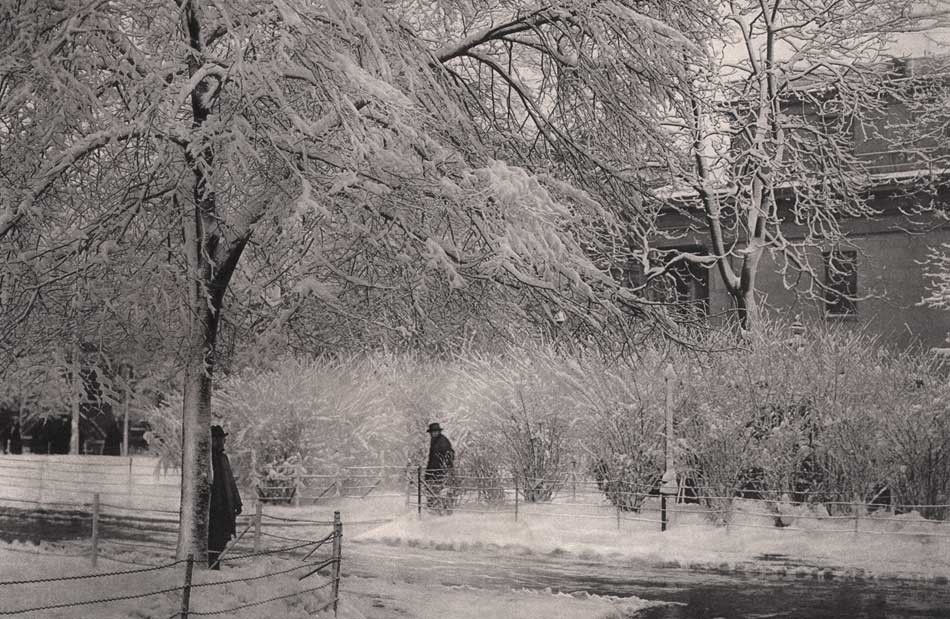 “City Hall Park, New York, March 2, 1896”: William H. Cooper, American. Vintage hand-pulled photogravure by the N.Y. Photogravure Co.: 18.0 x 22.9 | 27.6 x 34.8 cm. Plate issued with the March, 1896 Whole # 91 monthly issue of “Sun and Shade, An Artistic Periodical”. Snow from a late Winter storm coats trees and nearly everything else in New York City’s City Hall Park. From Wikipedia: “City Hall Park is a public park surrounding New York City Hall in the Civic Center of Manhattan. It was the town commons of the nascent city of New York… During the pre-Revolutionary and Revolutionary eras, City Hall Park was the site of many rallies and movements.” Photographer William H. Cooper was the President of the Department of Photography at the Brooklyn Institute of Arts and Science when this photograph was published. The editors of Sun and Shade commented on this work: “The present picture, taken it may be noted for technical readers, by a 2A Zeiss lens, is, without exception, one of the most remarkable productions, so far, which photography has produced. Every one who has seen the strange and peculiar aspect of leafless trees, when showered with fleecy snow, has longed to carry in his mind the memory of the pretty sight: but, until now, it is doubtful if such a weird aspect has ever been perpetuated; certainly not by the hand of a painter, for it would be far and away beyond any artist’s powers.” From: PhotoSeed Archive
“City Hall Park, New York, March 2, 1896”: William H. Cooper, American. Vintage hand-pulled photogravure by the N.Y. Photogravure Co.: 18.0 x 22.9 | 27.6 x 34.8 cm. Plate issued with the March, 1896 Whole # 91 monthly issue of “Sun and Shade, An Artistic Periodical”. Snow from a late Winter storm coats trees and nearly everything else in New York City’s City Hall Park. From Wikipedia: “City Hall Park is a public park surrounding New York City Hall in the Civic Center of Manhattan. It was the town commons of the nascent city of New York… During the pre-Revolutionary and Revolutionary eras, City Hall Park was the site of many rallies and movements.” Photographer William H. Cooper was the President of the Department of Photography at the Brooklyn Institute of Arts and Science when this photograph was published. The editors of Sun and Shade commented on this work: “The present picture, taken it may be noted for technical readers, by a 2A Zeiss lens, is, without exception, one of the most remarkable productions, so far, which photography has produced. Every one who has seen the strange and peculiar aspect of leafless trees, when showered with fleecy snow, has longed to carry in his mind the memory of the pretty sight: but, until now, it is doubtful if such a weird aspect has ever been perpetuated; certainly not by the hand of a painter, for it would be far and away beyond any artist’s powers.” From: PhotoSeed Archive
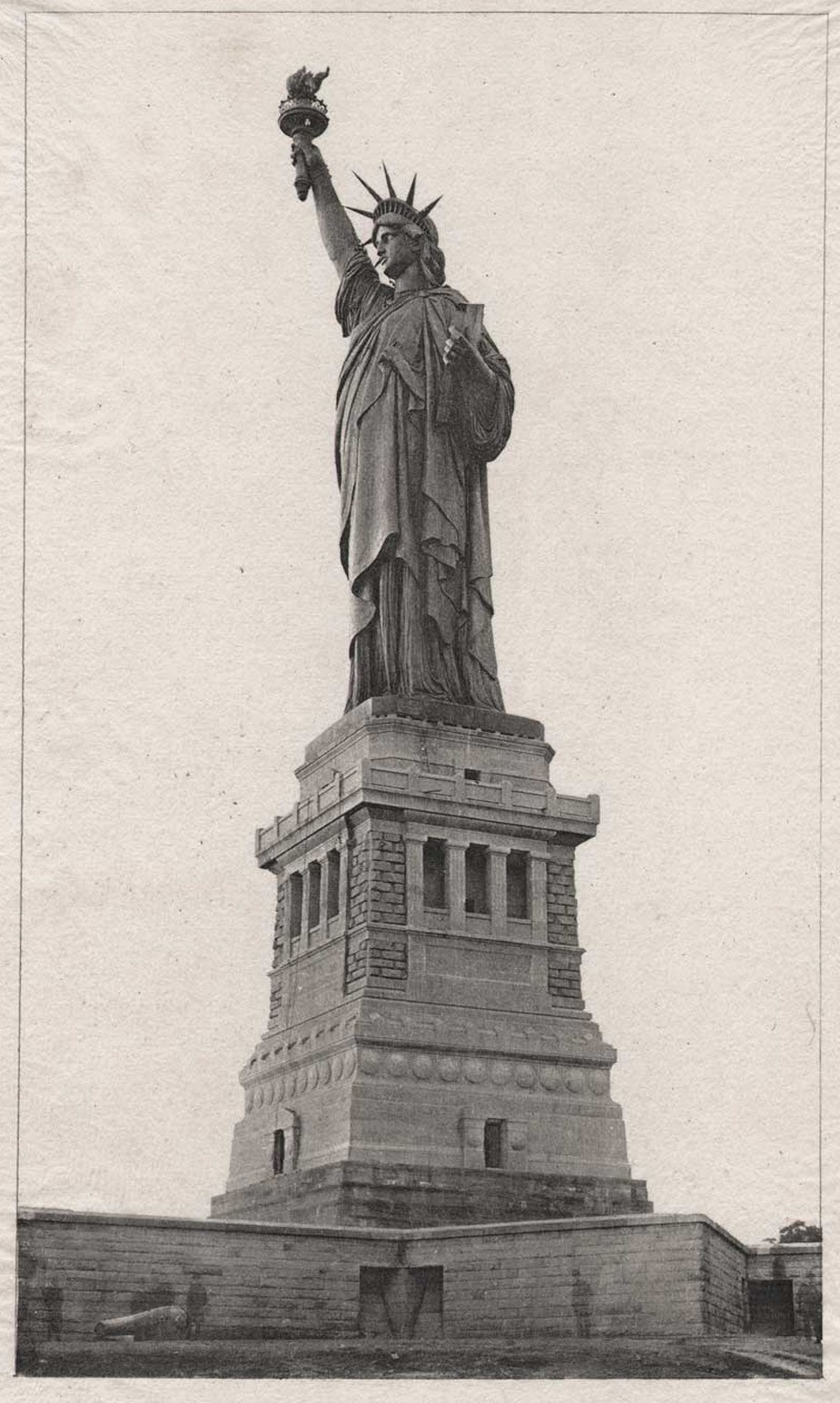 “Statue of Liberty”: Edward H. Hart, American photographer. Vintage Japan-tissue photogravure: 1886: printed ca. 1897-1900: Photogravure and Color Co. (New York): 17.2 x 10.1 | 20.9 x 12.5 cm | supports: 23.5 x 20.0 | 29.0 x 22.2 cm. This rare view of the Statue of Liberty (Liberty Enlightening the World) in New York Harbor was taken in the year it was officially dedicated, which took place October 28, 1886. E.H. Hart was a New York City based photographer with a studio at 1162 Broadway when contracted by the Photo-Gravure Co. of New York in 1886 to make several views of the statue. The company copyrighted one of these that year, titling it “Liberty”. A surviving example in the form of a mounted woodburytype process photograph is held by the National Archives at College Park in the U.S. state of Maryland. (Identifier: 45701938) This variant view by Hart includes the intriguing presence of six people who appear as “ghosts” at the base of the pedestal to the statue, their likeness due to movement during the long time-exposure required. The photographer billed himself an official U.S. Naval photographer, although it’s unclear if he was actually an employee of the Federal Government. A contract photographer for the Detroit Publishing Company in the late 19th Century, he was the author and publisher of the 1898 volume “The Authentic Photographic Views of the United States Navy”. From: PhotoSeed Archive
“Statue of Liberty”: Edward H. Hart, American photographer. Vintage Japan-tissue photogravure: 1886: printed ca. 1897-1900: Photogravure and Color Co. (New York): 17.2 x 10.1 | 20.9 x 12.5 cm | supports: 23.5 x 20.0 | 29.0 x 22.2 cm. This rare view of the Statue of Liberty (Liberty Enlightening the World) in New York Harbor was taken in the year it was officially dedicated, which took place October 28, 1886. E.H. Hart was a New York City based photographer with a studio at 1162 Broadway when contracted by the Photo-Gravure Co. of New York in 1886 to make several views of the statue. The company copyrighted one of these that year, titling it “Liberty”. A surviving example in the form of a mounted woodburytype process photograph is held by the National Archives at College Park in the U.S. state of Maryland. (Identifier: 45701938) This variant view by Hart includes the intriguing presence of six people who appear as “ghosts” at the base of the pedestal to the statue, their likeness due to movement during the long time-exposure required. The photographer billed himself an official U.S. Naval photographer, although it’s unclear if he was actually an employee of the Federal Government. A contract photographer for the Detroit Publishing Company in the late 19th Century, he was the author and publisher of the 1898 volume “The Authentic Photographic Views of the United States Navy”. From: PhotoSeed Archive
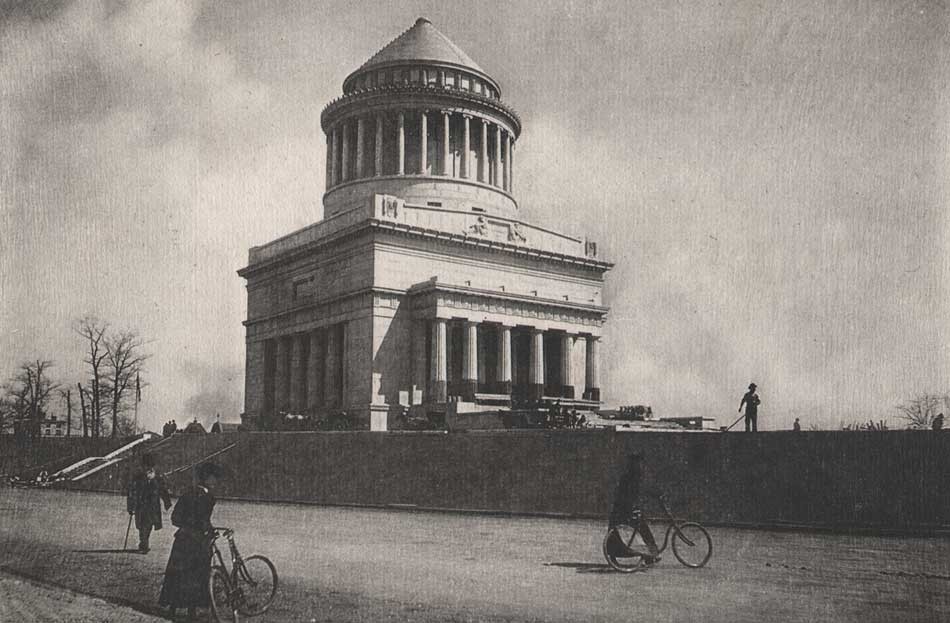 “Grant Memorial”: John S. Johnston, American photographer, born England or Ireland. (c.1839-1899). Vintage Japan-tissue photogravure: 1897: printed ca. 1897-1900: Photogravure and Color Co. (New York): 10.6 x 14.8 | 14.5 x 17.4 cm | supports: 19.5 x 24.5 | 22.2 x 29.0 cm. Taken in early 1897, this New York City view shows bicyclists on Riverside Drive with the soon to be opened General Grant National Memorial in the background. Known more commonly as Grant’s Tomb, it is located in the Morningside Heights neighborhood of Upper Manhattan. The massive domed mausoleum in the Neoclassical style is the final resting place for American Civil War General and 18th President of the United States Ulysses S. Grant. (1822-1885) Grant led the Union Army as Commanding General of the United States Army in winning the American Civil War. A close inspection of this photograph reveals ongoing work to the front stairwell area to the memorial, with large boards erected lengthwise against the base of the large columns. It was dedicated on April 27, 1897, the 75th-anniversary ceremony of Grant's birth on April 27, 1822. A known variant giving credit to Johnston is held privately, along with another more frontal view of the memorial and one example believed to be this very image at The Library of Congress. The library holds approximately 750 dry plate glass negatives of yachts and other marine craft views taken by Johnston when he was a contract photographer for the Detroit Publishing Company. A New York Times obituary for the photographer noted he “made a specialty of scenic photography. He photographed most of the United States warships during the war with Spain. He also photographed all of the international yacht races during the past ten years.” From: PhotoSeed Archive
“Grant Memorial”: John S. Johnston, American photographer, born England or Ireland. (c.1839-1899). Vintage Japan-tissue photogravure: 1897: printed ca. 1897-1900: Photogravure and Color Co. (New York): 10.6 x 14.8 | 14.5 x 17.4 cm | supports: 19.5 x 24.5 | 22.2 x 29.0 cm. Taken in early 1897, this New York City view shows bicyclists on Riverside Drive with the soon to be opened General Grant National Memorial in the background. Known more commonly as Grant’s Tomb, it is located in the Morningside Heights neighborhood of Upper Manhattan. The massive domed mausoleum in the Neoclassical style is the final resting place for American Civil War General and 18th President of the United States Ulysses S. Grant. (1822-1885) Grant led the Union Army as Commanding General of the United States Army in winning the American Civil War. A close inspection of this photograph reveals ongoing work to the front stairwell area to the memorial, with large boards erected lengthwise against the base of the large columns. It was dedicated on April 27, 1897, the 75th-anniversary ceremony of Grant's birth on April 27, 1822. A known variant giving credit to Johnston is held privately, along with another more frontal view of the memorial and one example believed to be this very image at The Library of Congress. The library holds approximately 750 dry plate glass negatives of yachts and other marine craft views taken by Johnston when he was a contract photographer for the Detroit Publishing Company. A New York Times obituary for the photographer noted he “made a specialty of scenic photography. He photographed most of the United States warships during the war with Spain. He also photographed all of the international yacht races during the past ten years.” From: PhotoSeed Archive
Photograph: Meet Frame
Posted February 2020 in Conservation, Framing, New Additions, Photographic Preservation, PhotoSeed, Significant Photographers
Last August I had the uncommon opportunity to purchase five photographs ca. 1905-1910 that were still in their original picture frames taken by William T. Knox, (1863-1927) then president of the Brooklyn Camera Club.
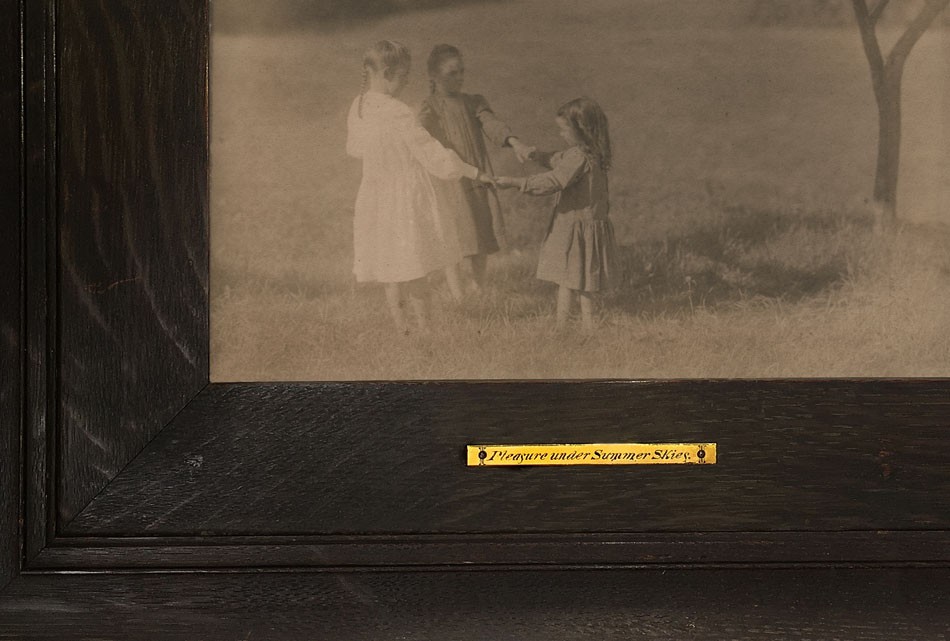 Detail: “Pleasure Under Summer Skies”: William T. Knox, American: (1863-1927) Vintage sepia Platinum print ca. 1905-10; 19.6 x 24.5 | 19.6 x 24.5 cm (flush-mounted on Bristol-board type matrix). Photograph framed in quarter-sawn oak frame with brass title nameplate made by James Engle Underhill, American: (1870-1914) two-piece integrated: 34.5 x 39.5 x 2.0 cm shown with glass removed. “Pleasure Under Summer Skies” dates to 1905, and was initially exhibited in the Second American Photographic Salon, overseen by the American Federation of Photographic Societies under President Curtis Bell. At the time, William Knox was Federation Secretary. From: PhotoSeed Archive
Detail: “Pleasure Under Summer Skies”: William T. Knox, American: (1863-1927) Vintage sepia Platinum print ca. 1905-10; 19.6 x 24.5 | 19.6 x 24.5 cm (flush-mounted on Bristol-board type matrix). Photograph framed in quarter-sawn oak frame with brass title nameplate made by James Engle Underhill, American: (1870-1914) two-piece integrated: 34.5 x 39.5 x 2.0 cm shown with glass removed. “Pleasure Under Summer Skies” dates to 1905, and was initially exhibited in the Second American Photographic Salon, overseen by the American Federation of Photographic Societies under President Curtis Bell. At the time, William Knox was Federation Secretary. From: PhotoSeed Archive
Additionally, three of them were in beautiful wood frames made by his fellow club member James E. Underhill, 1870-1914, who I discovered had made his living as a fine picture framer since around 1900 in New York City at his shop at 33 John Street, at the corner of Nassau Street.
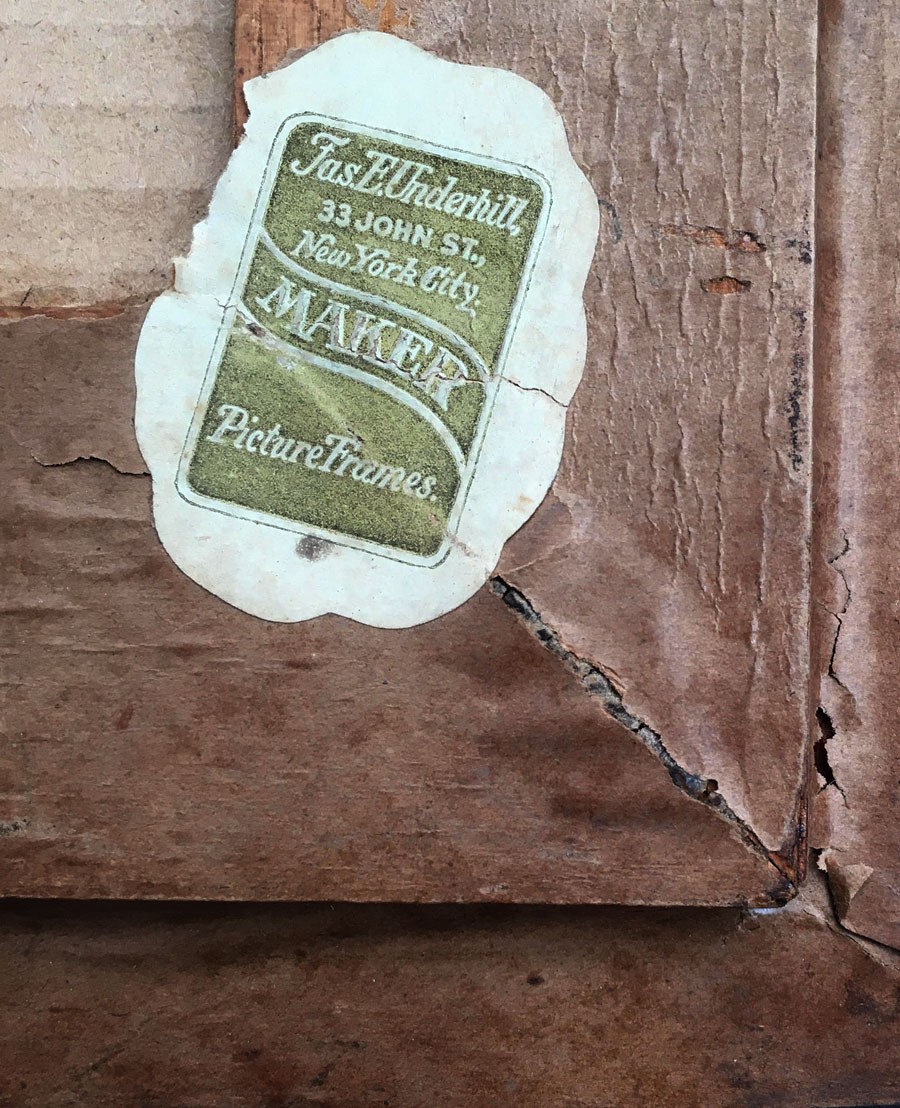 Before limited conservation, the original James E. Underhill white-paper letterpress label in olive-green (2.9 x 2.0 | 4.3 x 3.2 cm) is seen affixed to the frame backing verso of his oak frame enclosing the William T. Knox photograph “Pleasure Under Summer Skies”. Conservation treatment by this archive carefully left this label in place. James Engle Underhill was a fellow member along with Knox at the Brooklyn Camera Club when this photograph was taken and framed. (ca. 1905-10) Underhill’s picture framing shop: “Jas.E.Underhill, 33 John St., New York City. MAKER PictureFrames.” was in operation at this location (corner Nassau) from around 1900 to his death in 1914. From: PhotoSeed Archive
Before limited conservation, the original James E. Underhill white-paper letterpress label in olive-green (2.9 x 2.0 | 4.3 x 3.2 cm) is seen affixed to the frame backing verso of his oak frame enclosing the William T. Knox photograph “Pleasure Under Summer Skies”. Conservation treatment by this archive carefully left this label in place. James Engle Underhill was a fellow member along with Knox at the Brooklyn Camera Club when this photograph was taken and framed. (ca. 1905-10) Underhill’s picture framing shop: “Jas.E.Underhill, 33 John St., New York City. MAKER PictureFrames.” was in operation at this location (corner Nassau) from around 1900 to his death in 1914. From: PhotoSeed Archive
In my 20+ years of collecting photography, and with a definite impression the “bloom is off the rose” when it comes to the intersection of internet commerce, it seems to me today more difficult to acquire vintage photographs of artistic note still in their original frames. This is a pity, because framed photographs left undisturbed from 100+ years ago can often reveal the more honest intent photographers wished for their work to be seen and appreciated- for the time they were created no doubt, but also on a higher aesthetic level.
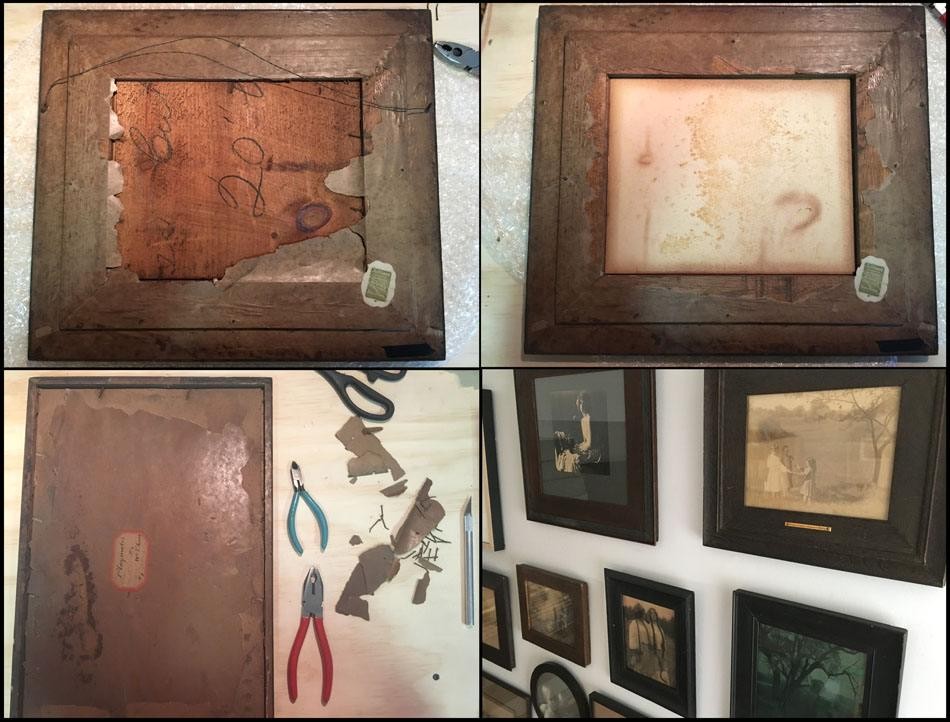 Upper left: When first received by PhotoSeed after purchase in late August, 2019, the verso of the framed William T. Knox photograph “Pleasure Under Summer Skies” is seen in its’ original James E. Underhill oak frame. As was common in framed works from the late 19th and early 20th centuries, a thin sheet of pine wood veneer was used as a backing board, secured by small nails. Upper Right: Conservation treatment on the framed work included removal of this wood backing board along with rusted screw-eyes and wiring used for hanging as well as some of the frame backing paper. The original Underhill framing label is carefully left undisturbed at lower right and the Bristol-board type matrix with flush-mounted photograph on recto is revealed, showing the “burning in” of several wood knot holes from the recto of the original sheet of wood veneer. Next steps included the thorough cleaning of the original framing glass and then cutting a piece of acid-free, 4-ply mat board that would be sandwiched between the photographic matrix and new piece of cardboard backing board. Finally, a Fletcher brand framing gun was used to secure glass, mounted photograph and the two separate backing matrixes using new metal framer’s points to the inside perimeter of the frame verso. Lower Left: Tools at right including small pliers and a wire-cutter were used to remove the original verso framing nails from the William T. Knox photograph “Playmates”, along with an X-Acto knife at far right to cut away the delicate and very acidic backing paper. A unique paper label signed and titled by the artist in the middle of the paper was then carefully removed and preserved within a newly encapsulated frame using a piece of acid-free mat board. New flush-mounted hanging hardware (screw-eyes not recommended!) and braided wire were also installed. Lower Right: A selection shows vintage frames with photographs from the PhotoSeed Archive, including the William T. Knox photograph “Pleasure Under Summer Skies”, now re-installed within its’ original James E. Underhill frame at upper right. To the left of it is a separate frame made by Underhill’s contemporary, George F. Of Jr. (1876-1954) From: PhotoSeed Archive
Upper left: When first received by PhotoSeed after purchase in late August, 2019, the verso of the framed William T. Knox photograph “Pleasure Under Summer Skies” is seen in its’ original James E. Underhill oak frame. As was common in framed works from the late 19th and early 20th centuries, a thin sheet of pine wood veneer was used as a backing board, secured by small nails. Upper Right: Conservation treatment on the framed work included removal of this wood backing board along with rusted screw-eyes and wiring used for hanging as well as some of the frame backing paper. The original Underhill framing label is carefully left undisturbed at lower right and the Bristol-board type matrix with flush-mounted photograph on recto is revealed, showing the “burning in” of several wood knot holes from the recto of the original sheet of wood veneer. Next steps included the thorough cleaning of the original framing glass and then cutting a piece of acid-free, 4-ply mat board that would be sandwiched between the photographic matrix and new piece of cardboard backing board. Finally, a Fletcher brand framing gun was used to secure glass, mounted photograph and the two separate backing matrixes using new metal framer’s points to the inside perimeter of the frame verso. Lower Left: Tools at right including small pliers and a wire-cutter were used to remove the original verso framing nails from the William T. Knox photograph “Playmates”, along with an X-Acto knife at far right to cut away the delicate and very acidic backing paper. A unique paper label signed and titled by the artist in the middle of the paper was then carefully removed and preserved within a newly encapsulated frame using a piece of acid-free mat board. New flush-mounted hanging hardware (screw-eyes not recommended!) and braided wire were also installed. Lower Right: A selection shows vintage frames with photographs from the PhotoSeed Archive, including the William T. Knox photograph “Pleasure Under Summer Skies”, now re-installed within its’ original James E. Underhill frame at upper right. To the left of it is a separate frame made by Underhill’s contemporary, George F. Of Jr. (1876-1954) From: PhotoSeed Archive
On a technical note, PhotoSeed does minimum conservation on framed works when they enter the collection. The mantra of “do no harm” as well as the realization of being temporary custodians of an archive is embraced. When in doubt about proceeding with photographic conservation, advice given me many years ago from a George Eastman Museum conservator to basically just leave things alone when unsure of how to proceed is something I’ve always kept in mind. Of course, the financial realities of proper conservation standards will always be at the forefront for collectors, both private and institutional.
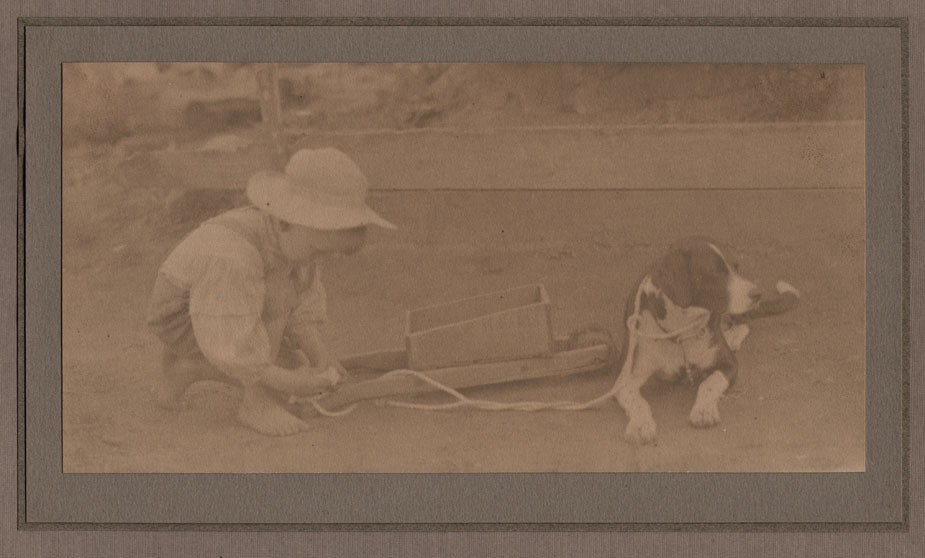 “Playmates”: William T. Knox, American: (1863-1927) Vintage sepia Platinum print ca. 1905-10; image: 12.0 x 23.5 mounted on fine art papers: 19.6 x 24.5 | 19.6 x 24.5 cm. This fine children’s genre study by Brooklyn Camera Club president William T. Knox dates to 1905 or slightly before as it was known to have been exhibited in the Second American Photographic Salon that year. It shows a young child attaching a leash from his faithful canine companion to his toy wooden wheelbarrow. From: PhotoSeed Archive
“Playmates”: William T. Knox, American: (1863-1927) Vintage sepia Platinum print ca. 1905-10; image: 12.0 x 23.5 mounted on fine art papers: 19.6 x 24.5 | 19.6 x 24.5 cm. This fine children’s genre study by Brooklyn Camera Club president William T. Knox dates to 1905 or slightly before as it was known to have been exhibited in the Second American Photographic Salon that year. It shows a young child attaching a leash from his faithful canine companion to his toy wooden wheelbarrow. From: PhotoSeed Archive
Frame Conservation: A Few Ideas
For framed works, conservation on my end typically includes the removal of acidic frame backing materials and replacement with acid-free mounting materials that come into direct contact with the physical print. Embedded dirt and other foreign matter is then carefully removed and or wiped away from the frame itself, with original finishes showing the passing of decades left deliberately intact and never stripped off. Finally, everything is put back together for storage or display: the original glass from the frame is also cleaned on both sides and then carefully put back into place. If cracks are discovered or worse, replacement with a custom cut piece of window glass will typically suffice.
Digital Presentation on PhotoSeed
For digital presentation on this website, the frame is then photographed separately and the print scanned. I use Photoshop to combine the two-leaving the original framing glass out. Purists may object to this but I’m not changing the physical object in any way-just taking advantage to present you with an optimum web experience. Of course, the joy of collecting is being able to appreciate a vintage photograph in the very best form possible: in person. Never the less, I’ve included a small photo along with three other conservation snaps in this post showing a small display of conserved and “reframed” works from this archive. Other examples can be found here.
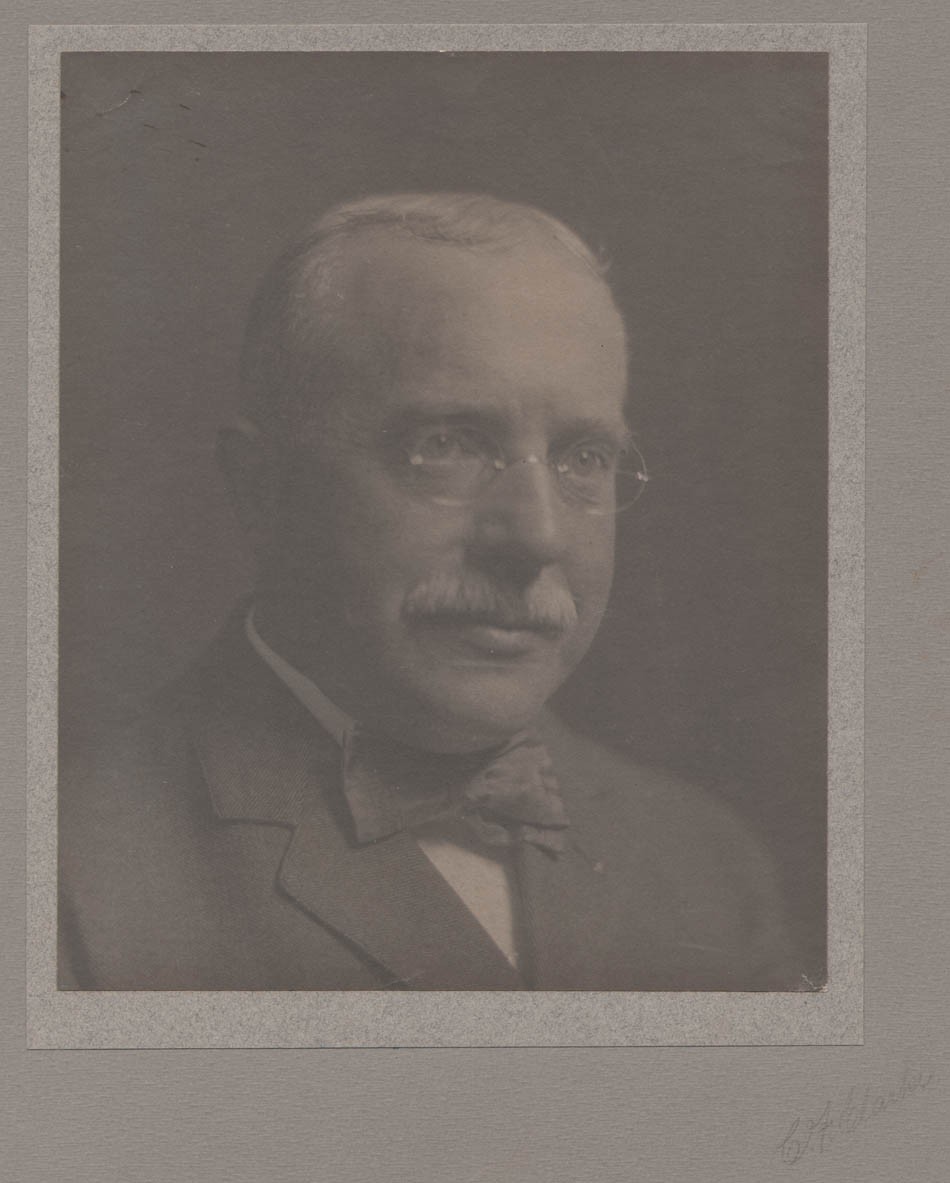 “Portrait: Brooklyn Camera Club President William T. Knox”: Charles Frederick Clarke, American, born Nova Scotia: (1865-1912) image: 21.7 x 17.8 cm; supports: light-gray art paper 23.7 x 19.4 | 36.4 x 29.5 cm; Vintage platinum print ca. 1905-10. William T. Knox (1863-1927) was an important American amateur photographer and promoter of photography from Brooklyn, New York. From at least 1891-1915, he was a partner of McCormick, Hubbs & Co., importers and commission merchants in West India and Florida Fruits and Produce with offices at 279 Washington Street in New York City. (Manhattan) From: PhotoSeed Archive
“Portrait: Brooklyn Camera Club President William T. Knox”: Charles Frederick Clarke, American, born Nova Scotia: (1865-1912) image: 21.7 x 17.8 cm; supports: light-gray art paper 23.7 x 19.4 | 36.4 x 29.5 cm; Vintage platinum print ca. 1905-10. William T. Knox (1863-1927) was an important American amateur photographer and promoter of photography from Brooklyn, New York. From at least 1891-1915, he was a partner of McCormick, Hubbs & Co., importers and commission merchants in West India and Florida Fruits and Produce with offices at 279 Washington Street in New York City. (Manhattan) From: PhotoSeed Archive
Intriguingly, I have owned a platinum portrait of William T. Knox, showing him to be quite the dapper gentleman- mustachioed, and sporting a bow tie taken about the same time he was club president, for many years prior to my collecting any of his actual photographs. This was by Charles F. Clarke, 1865-1912, (American, born Nova Scotia) an amateur and business agent for the Forbes Lithograph Company of Springfield, MA.
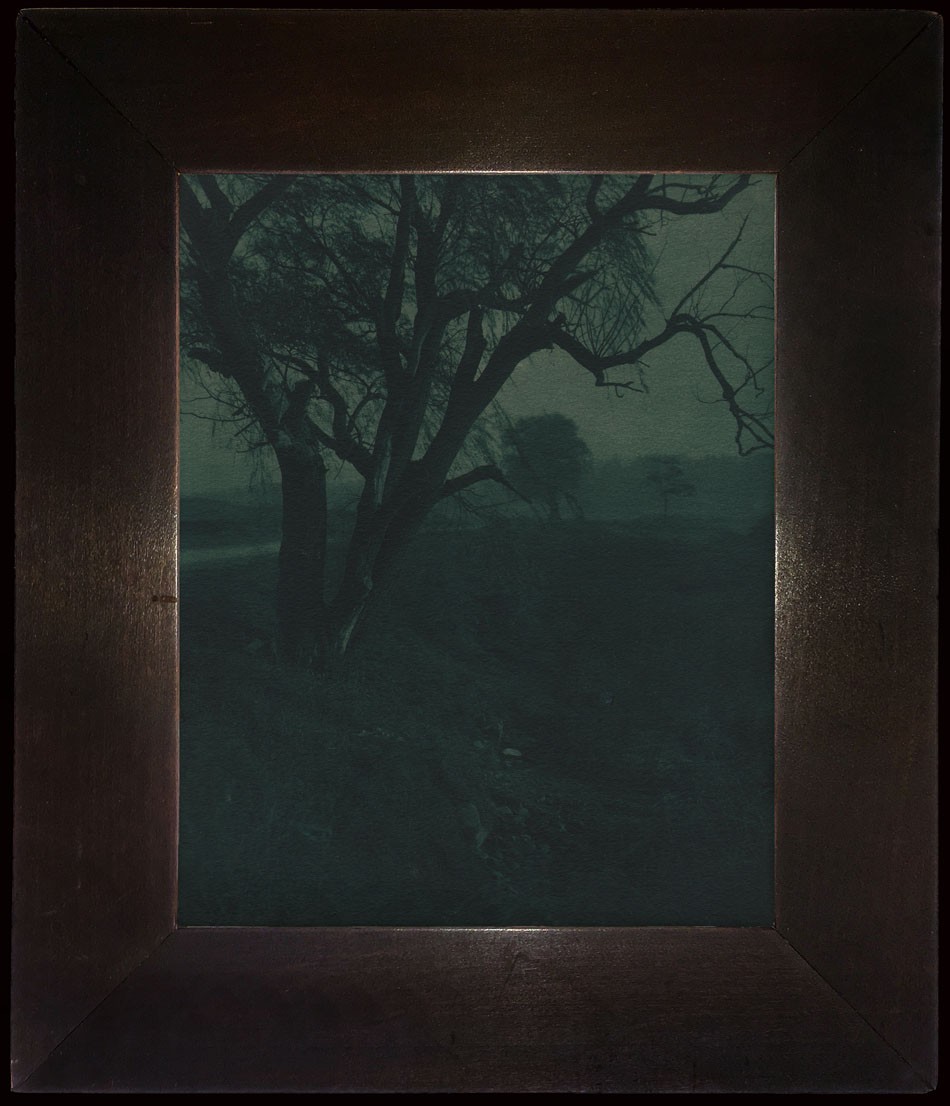 “Landscape in Green Carbon”: attributed to William T. Knox, American: (1863-1927) Vintage green Carbon print ca. 1905-10; image: 23.4 x 19.7 cm flush mounted to thick, Bristol-board type matrix: 23.6 x 19.7 cm shown within its’ original oak frame: 32.6 x 28.6 x 2.0 cm (with glass removed) by James E. Underhill (1870-1914) of New York City. Knox and Underhill were members of the Brooklyn Camera Club when this photograph was taken and framed. From: PhotoSeed Archive
“Landscape in Green Carbon”: attributed to William T. Knox, American: (1863-1927) Vintage green Carbon print ca. 1905-10; image: 23.4 x 19.7 cm flush mounted to thick, Bristol-board type matrix: 23.6 x 19.7 cm shown within its’ original oak frame: 32.6 x 28.6 x 2.0 cm (with glass removed) by James E. Underhill (1870-1914) of New York City. Knox and Underhill were members of the Brooklyn Camera Club when this photograph was taken and framed. From: PhotoSeed Archive
You can see all of Mr. Knox’s framed works in the collection here, which includes a professional chronology for his friend the framer and fellow Brooklyn Camera Club member James E. Underhill. Happy hunting! -David Spencer
Summer Streams Wide & Small
Posted June 2019 in Alternate Processes, Childhood Photography, Color Photography, Documentary Photography, Journals, New Additions, Painters|Photographers, Scientific Photography, Significant Photographers, Significant Photographs, Unknown Photographers
Herein a summer interlude, if you will, of still, trickling and gushing streams from years past. And if they inspire and beckon for the present, find your own peace or wonderment in the mountains, valleys or pastures of summer wherever your own stream flows.
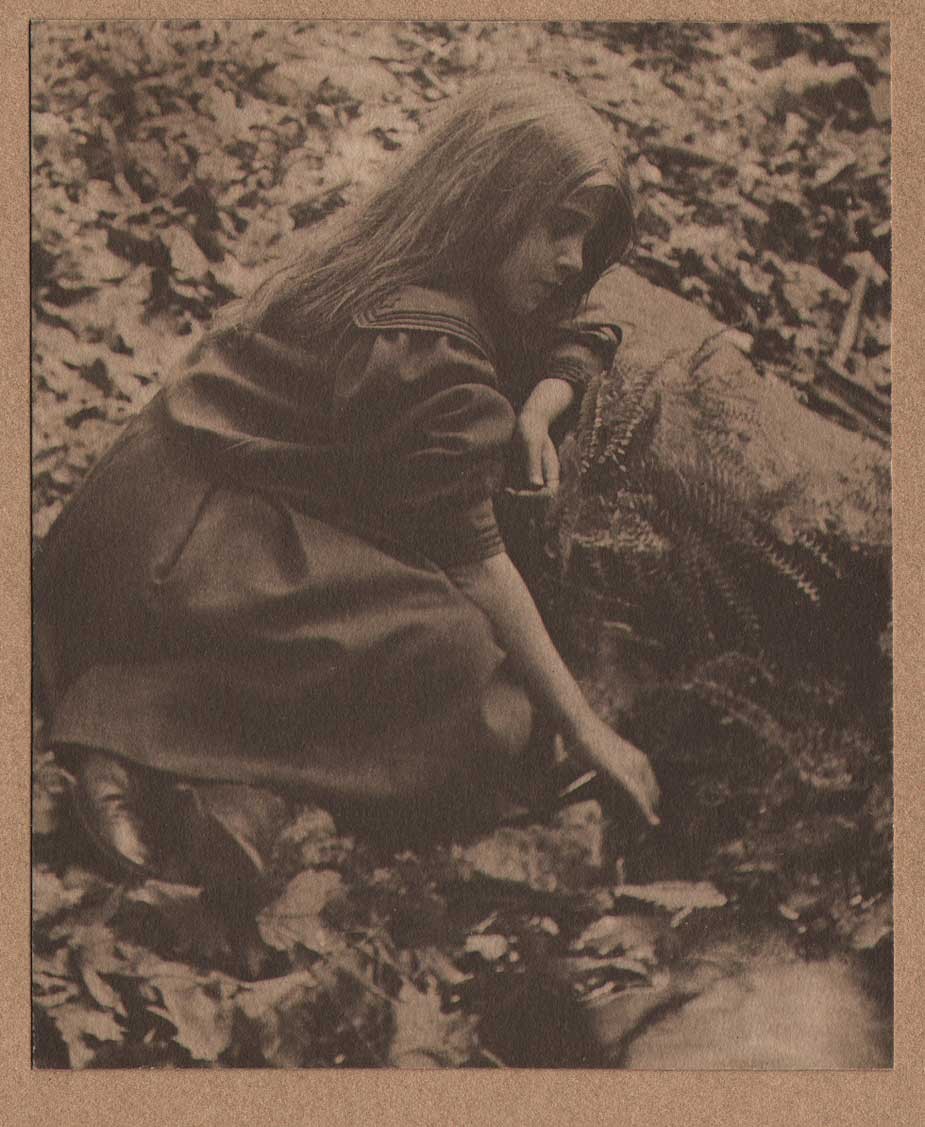 “Dorothy Tucker Gathering Ferns”: Charles Rollins Tucker, American (b. 1868): ca. 1910: mounted brown-toned platinum print: 9.4 x 7.7 cm | 31.2 x 16.0 cm. Born in August, 1899, Dorothy Tucker, a constant photographic subject for her father, then a high school physics teacher at Curtis High School on Staten Island, New York state, holds a spray of freshly-picked ferns while investigating the edge of a stream in the woods. From: PhotoSeed Archive
“Dorothy Tucker Gathering Ferns”: Charles Rollins Tucker, American (b. 1868): ca. 1910: mounted brown-toned platinum print: 9.4 x 7.7 cm | 31.2 x 16.0 cm. Born in August, 1899, Dorothy Tucker, a constant photographic subject for her father, then a high school physics teacher at Curtis High School on Staten Island, New York state, holds a spray of freshly-picked ferns while investigating the edge of a stream in the woods. From: PhotoSeed Archive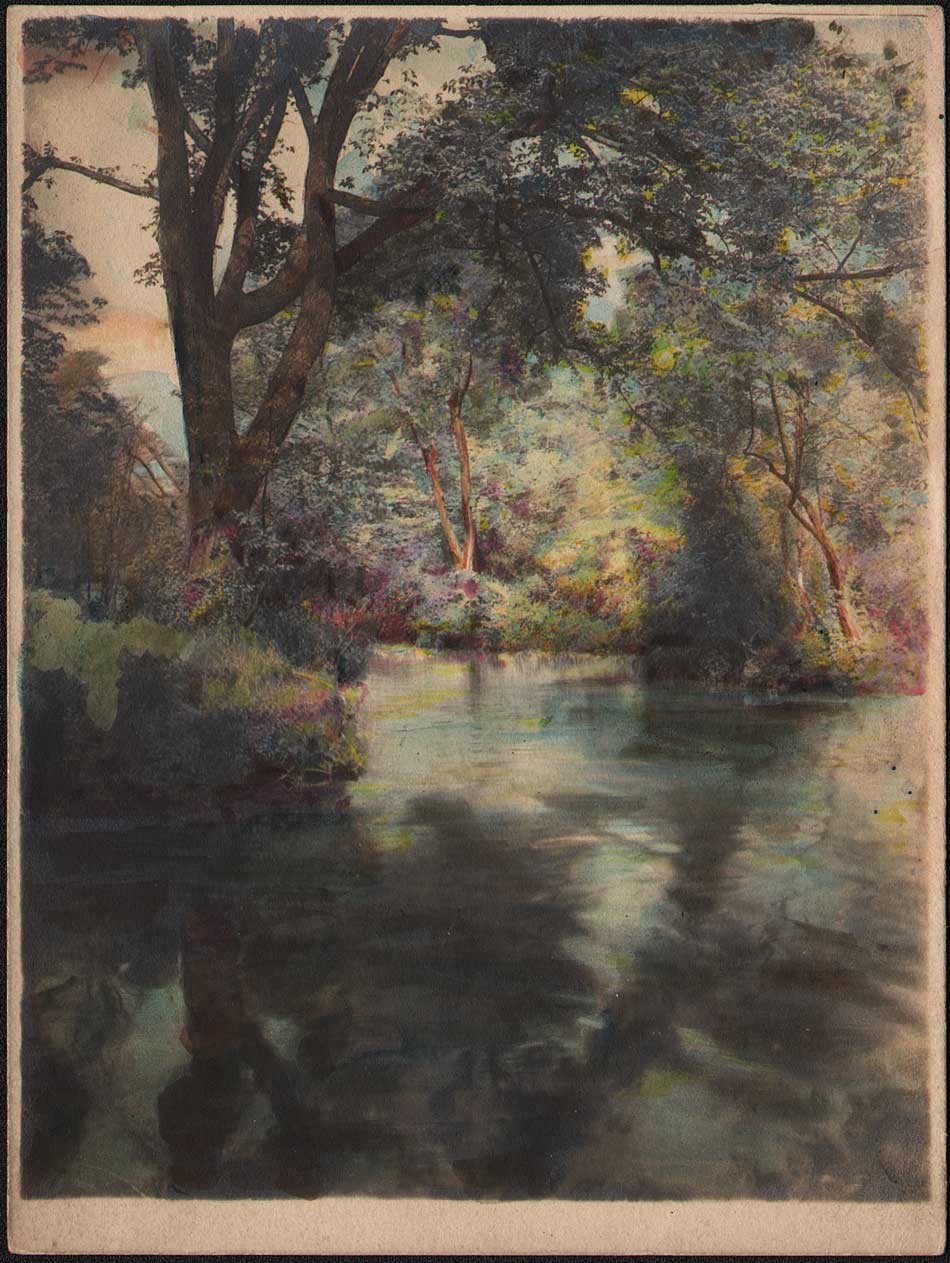 “Stream or Pond at Prospect Park"(Brooklyn, New York): ca. 1910-20: Unknown Brooklyn photographer: hand-colored gelatin silver print: 11.7 x 8.9 cm | 12.4 x 9.3 cm: From: PhotoSeed Archive
“Stream or Pond at Prospect Park"(Brooklyn, New York): ca. 1910-20: Unknown Brooklyn photographer: hand-colored gelatin silver print: 11.7 x 8.9 cm | 12.4 x 9.3 cm: From: PhotoSeed Archive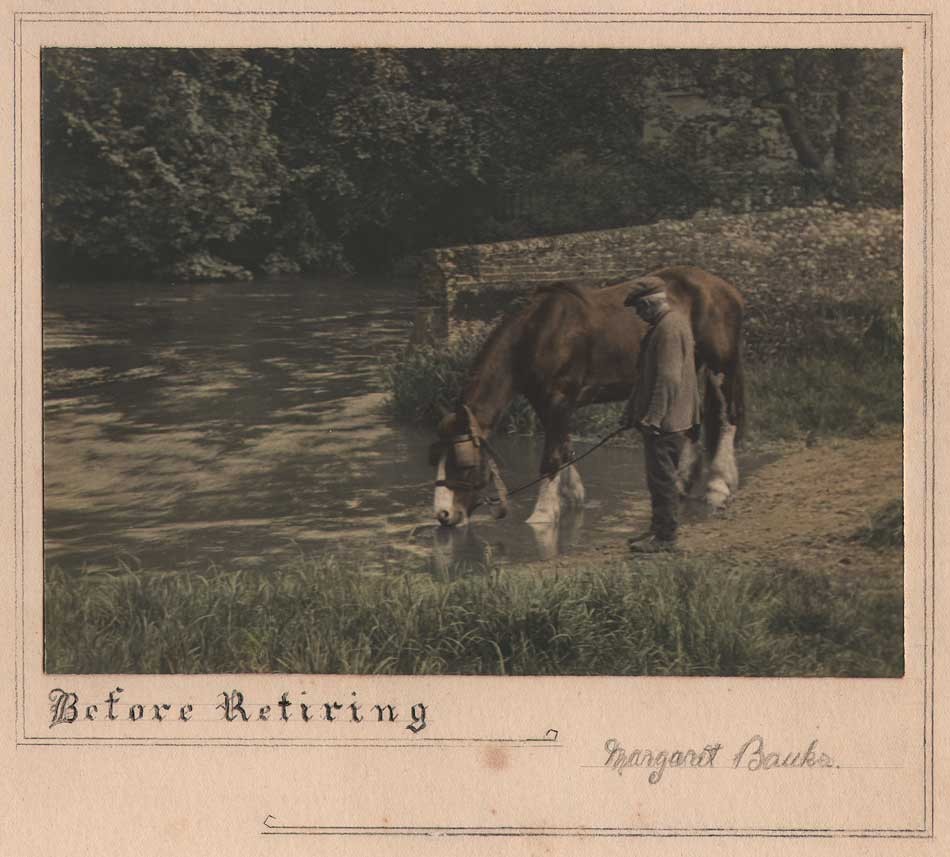 “Before Retiring”: ca. 1910-20: Margaret Bauks, British- (possibly Margaret Florence Bauks: b. 1872?) : hand-colored gelatin silver print: 11.6 x 15.9 cm | 27.8 x 22.8 cm: From: PhotoSeed Archive
“Before Retiring”: ca. 1910-20: Margaret Bauks, British- (possibly Margaret Florence Bauks: b. 1872?) : hand-colored gelatin silver print: 11.6 x 15.9 cm | 27.8 x 22.8 cm: From: PhotoSeed Archive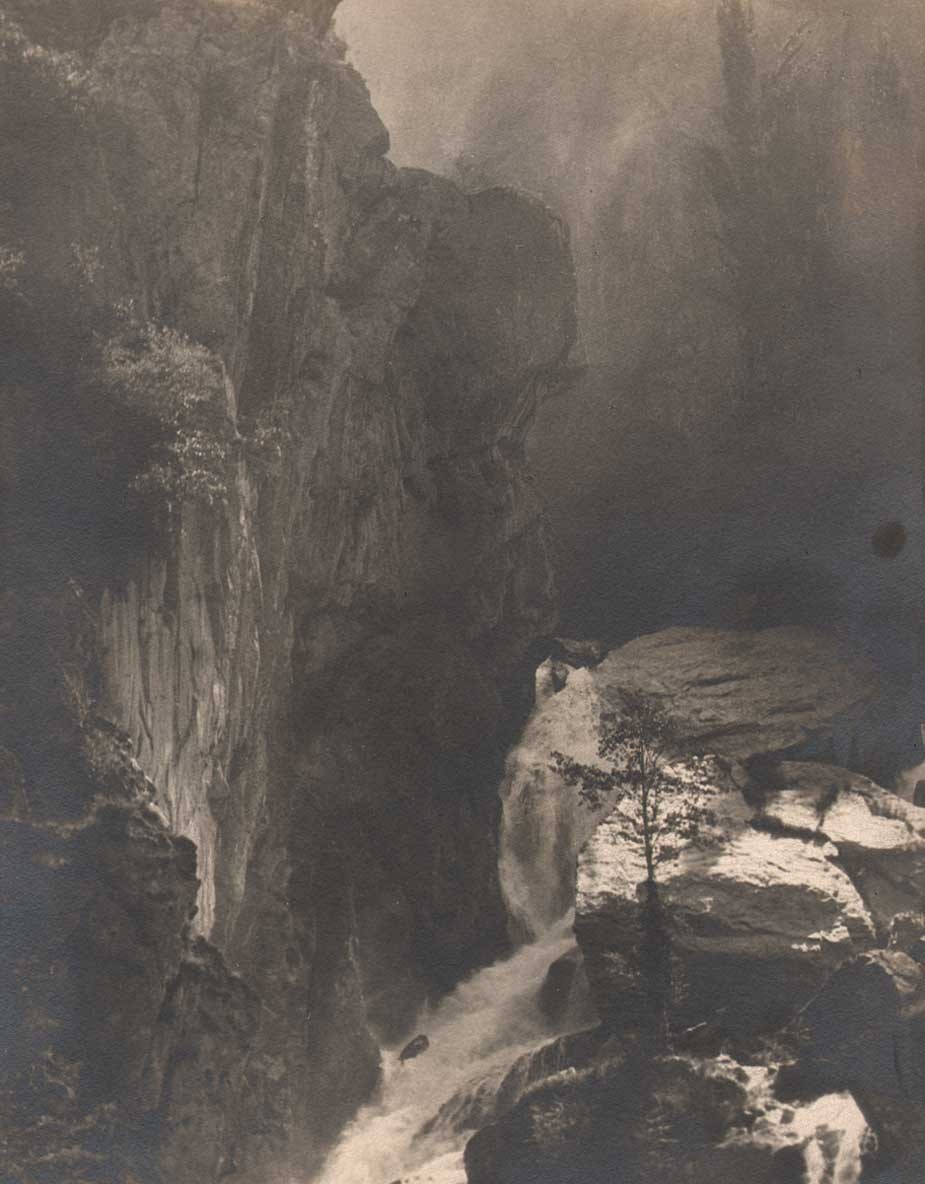 “A Stream of Savoy”: ca. 1927: this print exhibited 1935: Frank Roy Fraprie, American (1874-1951): vintage Bromide print: 24.0 x 18.6 cm | 30.5 x 25.4 cm: As noted in the 1946 American Annual of Photography, (p. 170) Fraprie had been taking photographs in June of 1926 in Eastern France. The area, located in the Haute-Savoie, or Upper Savoy, is a mountainous region of spectacular beauty which includes Lake Annecy, one of France’s largest freshwater lakes. Photographic historian Christian Peterson’s biography of Fraprie gives some background on this important photographer and editor: “Fraprie was the most influential author/publisher of American pictorial photography during the period following the Photo-Secession. From the 1910s to the 1940s, he wrote books and countless articles on all aspects of pictorialism. He edited photographic monthlies and annuals for nearly the entire first half of the twentieth century. In addition, he created his own highly successful pictorial photographs and exhibited them extensively.” From: PhotoSeed Archive
“A Stream of Savoy”: ca. 1927: this print exhibited 1935: Frank Roy Fraprie, American (1874-1951): vintage Bromide print: 24.0 x 18.6 cm | 30.5 x 25.4 cm: As noted in the 1946 American Annual of Photography, (p. 170) Fraprie had been taking photographs in June of 1926 in Eastern France. The area, located in the Haute-Savoie, or Upper Savoy, is a mountainous region of spectacular beauty which includes Lake Annecy, one of France’s largest freshwater lakes. Photographic historian Christian Peterson’s biography of Fraprie gives some background on this important photographer and editor: “Fraprie was the most influential author/publisher of American pictorial photography during the period following the Photo-Secession. From the 1910s to the 1940s, he wrote books and countless articles on all aspects of pictorialism. He edited photographic monthlies and annuals for nearly the entire first half of the twentieth century. In addition, he created his own highly successful pictorial photographs and exhibited them extensively.” From: PhotoSeed Archive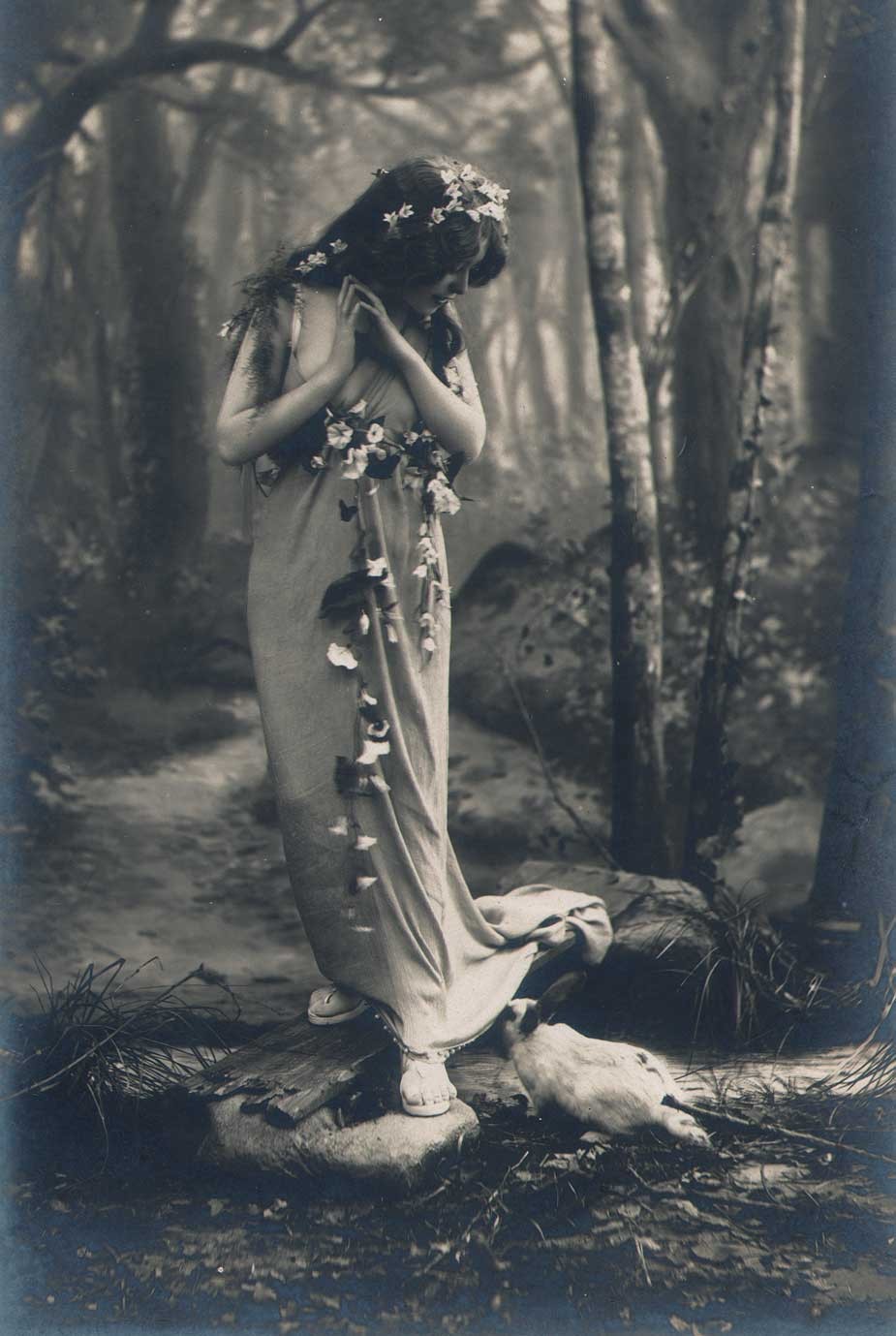 Detail: “Les Fleurs Dans Le Bois” : Léopold-Émile Reutlinger: French (1863-1937): vintage Bromide photograph, ca. 1905. 22.3 x 14.1 | 34.0 x 24.2 cm. Featuring a painted backdrop and wood board placed over a “stream”, this studio photograph features a white rabbit investigating the Belle Epoque era model identified from other variants as “Miss Doll”.(proper identification of this model would be of interest as she has remained a popular subject seen in countless vintage postcards, many hand-tinted) This example was printed by the Milan atelier Maison Tensi and included as a full-page plate in the February, 1905 issue of “La Fotographia Artistica”, a French/Italian photographic journal. From: PhotoSeed Archive
Detail: “Les Fleurs Dans Le Bois” : Léopold-Émile Reutlinger: French (1863-1937): vintage Bromide photograph, ca. 1905. 22.3 x 14.1 | 34.0 x 24.2 cm. Featuring a painted backdrop and wood board placed over a “stream”, this studio photograph features a white rabbit investigating the Belle Epoque era model identified from other variants as “Miss Doll”.(proper identification of this model would be of interest as she has remained a popular subject seen in countless vintage postcards, many hand-tinted) This example was printed by the Milan atelier Maison Tensi and included as a full-page plate in the February, 1905 issue of “La Fotographia Artistica”, a French/Italian photographic journal. From: PhotoSeed Archive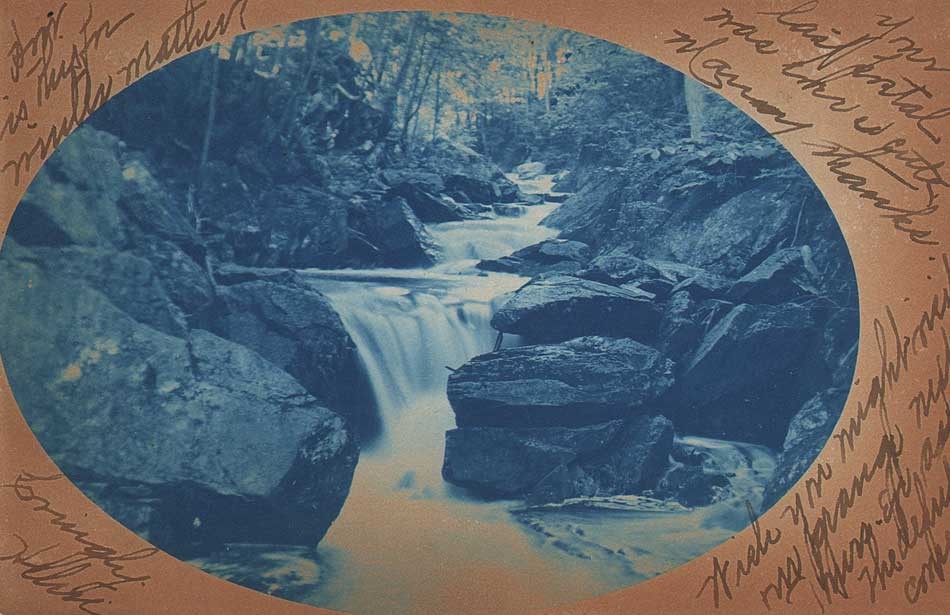 “A Rocky Brook” (New England?) : ca. 1906: Unknown American photographer: vintage cyanotype rppc: 8.9 x 13.8 cm. This idyllic cascading waterfall may depict the Minnewawa Glen in Marlborough, New Hampshire. Signed on the recto: “Lovingly Helen” in the lower left corner, it’s postmarked November 15, 1906 from Marlboro, N.H. addressed to Miss Nettie A. Hastings of East Sullivan, N.H. From: PhotoSeed Archive
“A Rocky Brook” (New England?) : ca. 1906: Unknown American photographer: vintage cyanotype rppc: 8.9 x 13.8 cm. This idyllic cascading waterfall may depict the Minnewawa Glen in Marlborough, New Hampshire. Signed on the recto: “Lovingly Helen” in the lower left corner, it’s postmarked November 15, 1906 from Marlboro, N.H. addressed to Miss Nettie A. Hastings of East Sullivan, N.H. From: PhotoSeed Archive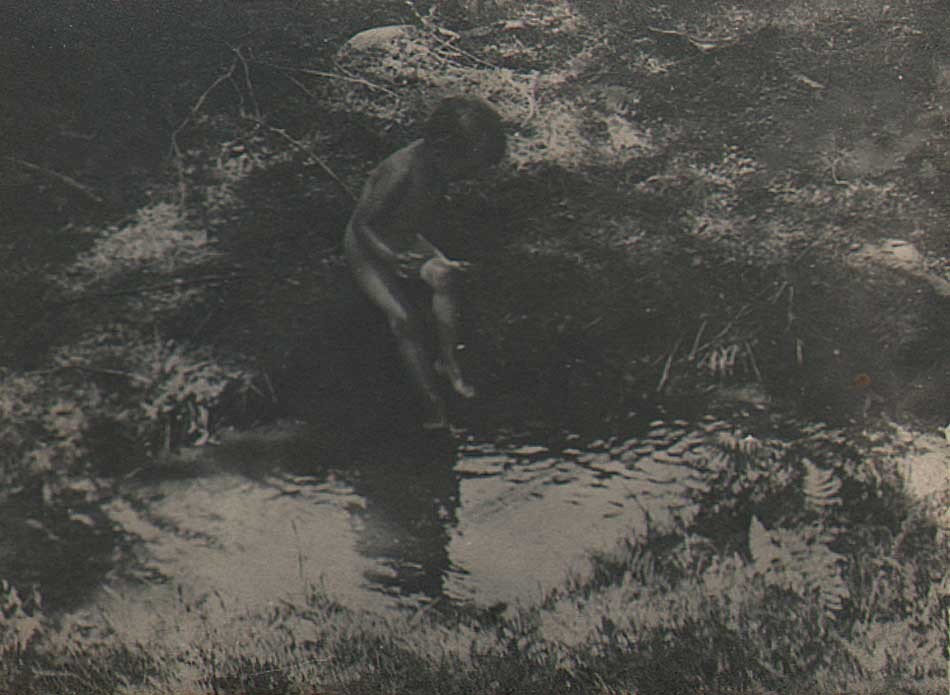 “John Robert Tucker Skinny Dipping”: Charles Rollins Tucker, American (b. 1868): ca. 1915: unmounted platinum print: 3.8 x 5.2 cm. Born in March, 1914, John Robert Tucker, was the second of three children born to the former Mary Carruthers and photographer Charles R. Tucker. Here, the young boy plays in a woodland stream, with the photograph most likely taken in New England. John, according to his 1941 marriage certificate, was an electrical engineer by training. He died in 1991 in La Habra, Orange County, CA. From: PhotoSeed Archive
“John Robert Tucker Skinny Dipping”: Charles Rollins Tucker, American (b. 1868): ca. 1915: unmounted platinum print: 3.8 x 5.2 cm. Born in March, 1914, John Robert Tucker, was the second of three children born to the former Mary Carruthers and photographer Charles R. Tucker. Here, the young boy plays in a woodland stream, with the photograph most likely taken in New England. John, according to his 1941 marriage certificate, was an electrical engineer by training. He died in 1991 in La Habra, Orange County, CA. From: PhotoSeed Archive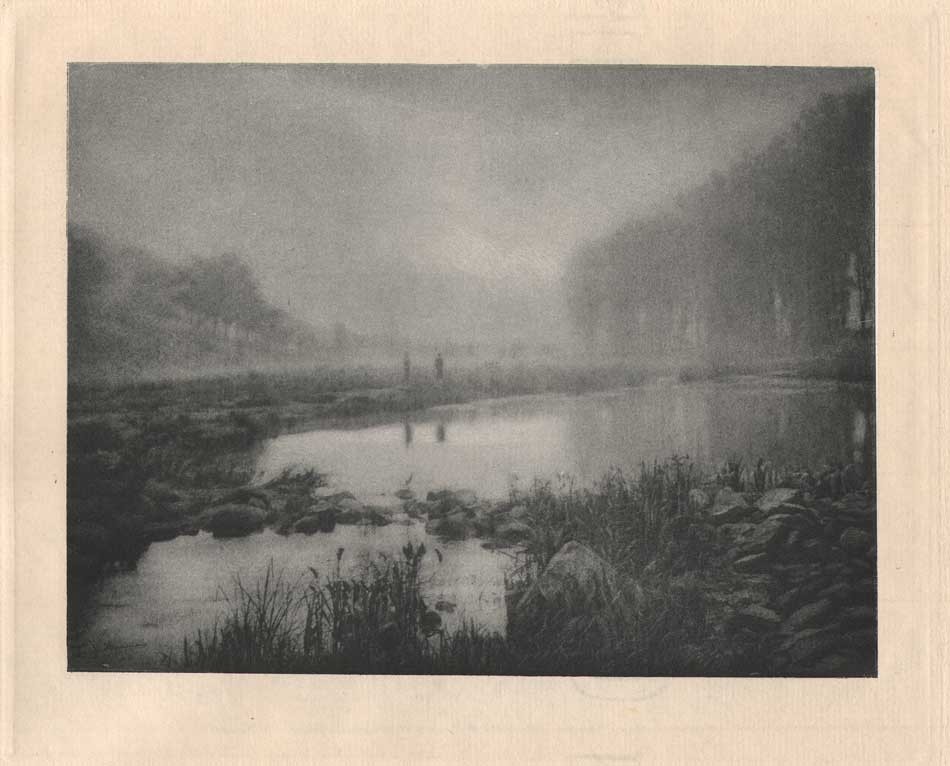 “Brume après la Pluie”: (1906) 1908: Gustave Marissiaux, Belgian (1872-1929) Photogravure on Van Gelder Zonen laid paper: 13.4 x 17.6 | 28.4 x 39.9 cm. Plate XXVI from Marissiaux’s tour-de-force gravure folio “Visions D’Artiste” comprised of 30 plates dating 1899-1908. Translating to “Mist after the Rain”, two figures in the distance stand looking out over an enlarged pond or stream located in "La Terre Wallonne” as identified in the portfolio index: more commonly known today as Wallonia- the southern region of Belgium. From: PhotoSeed Archive
“Brume après la Pluie”: (1906) 1908: Gustave Marissiaux, Belgian (1872-1929) Photogravure on Van Gelder Zonen laid paper: 13.4 x 17.6 | 28.4 x 39.9 cm. Plate XXVI from Marissiaux’s tour-de-force gravure folio “Visions D’Artiste” comprised of 30 plates dating 1899-1908. Translating to “Mist after the Rain”, two figures in the distance stand looking out over an enlarged pond or stream located in "La Terre Wallonne” as identified in the portfolio index: more commonly known today as Wallonia- the southern region of Belgium. From: PhotoSeed Archive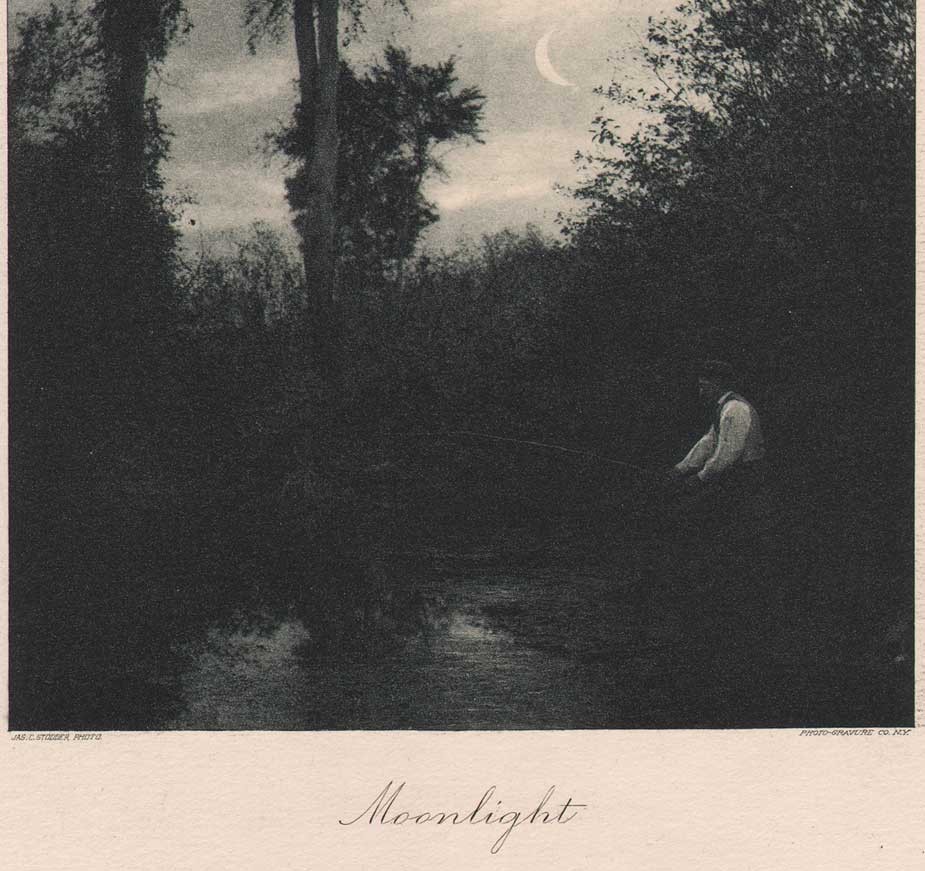 Detail: “Moonlight”: James C. Stodder, American: (1838-1917). 1890. Hand-pulled photogravure published in periodical "Sun & Shade”, New York: November, 1890: whole #27: N.Y. Photogravure Co.: 18.3 x 11.9 | 35.0 x 27.4 cm. A crescent moon rises above a wooded landscape at dusk while a gentleman fishes from the banks of a pond or stream. Stodder graduated from Rensselaer Polytechnic Institute in 1859 and moved to Bangor, Maine, where he first learned the wet-plate process of photography. A lawyer, he was son of a Boston jeweler, (obit) and financially well off. In 1876, he accompanied famed Hudson River School painter Frederic E. Church to the Mount Katahdin region of Maine. From: PhotoSeed Archive
Detail: “Moonlight”: James C. Stodder, American: (1838-1917). 1890. Hand-pulled photogravure published in periodical "Sun & Shade”, New York: November, 1890: whole #27: N.Y. Photogravure Co.: 18.3 x 11.9 | 35.0 x 27.4 cm. A crescent moon rises above a wooded landscape at dusk while a gentleman fishes from the banks of a pond or stream. Stodder graduated from Rensselaer Polytechnic Institute in 1859 and moved to Bangor, Maine, where he first learned the wet-plate process of photography. A lawyer, he was son of a Boston jeweler, (obit) and financially well off. In 1876, he accompanied famed Hudson River School painter Frederic E. Church to the Mount Katahdin region of Maine. From: PhotoSeed Archive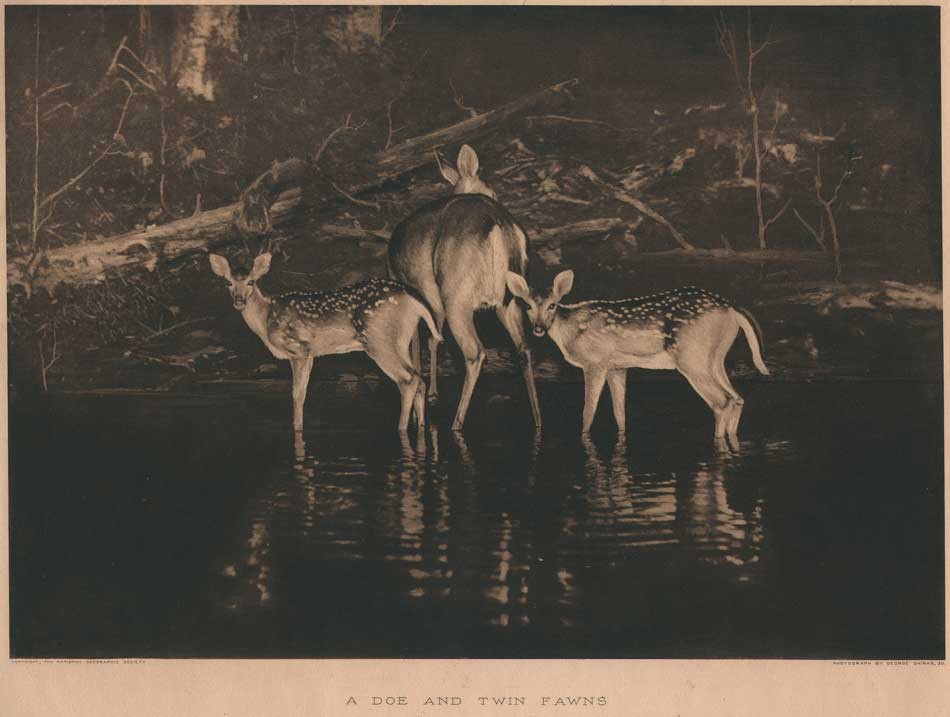 “A Doe and Twin Fawns” (taken 1896) 1916: George Shiras 3rd, American (1859-1942) Vintage photogravure published by the National Geographic Society, Washington, D.C. : 21.2 x 30.3 | 40.5 x 50.8 cm. A pioneer of using flashlight photography to record wildlife in their natural environments at night, Shiras used the method of “Jacklighting”, a form of hunting using a fixed continuous light source mounted in the bow of a canoe to draw the attention of wildlife: in this case three deer, while then utilizing magnesium flash-powder to freeze the scene in-camera. His series of twelve midnight views, including “A Doe and Twin Fawns”-also known as “Innocents Abroad” would earn Shiras international acclaim and many important awards. A one-term Congressman for the state of Michigan, (his father George Shiras Sr. was a former Justice of the U.S. Supreme Court) he was also an important naturalist who helped placed migratory birds and fish under Federal control. (The eventual 1918 Migratory Bird Treaty Act had groundings in legislation Shiras introduced to Congress in 1903 as the first comprehensive migratory bird law not voted on.) For additional background, see article by Matthew Brower in the journal History of Photography, Summer,2008: “George Shiras and the Circulation of Wildlife Photography”. From: PhotoSeed Archive
“A Doe and Twin Fawns” (taken 1896) 1916: George Shiras 3rd, American (1859-1942) Vintage photogravure published by the National Geographic Society, Washington, D.C. : 21.2 x 30.3 | 40.5 x 50.8 cm. A pioneer of using flashlight photography to record wildlife in their natural environments at night, Shiras used the method of “Jacklighting”, a form of hunting using a fixed continuous light source mounted in the bow of a canoe to draw the attention of wildlife: in this case three deer, while then utilizing magnesium flash-powder to freeze the scene in-camera. His series of twelve midnight views, including “A Doe and Twin Fawns”-also known as “Innocents Abroad” would earn Shiras international acclaim and many important awards. A one-term Congressman for the state of Michigan, (his father George Shiras Sr. was a former Justice of the U.S. Supreme Court) he was also an important naturalist who helped placed migratory birds and fish under Federal control. (The eventual 1918 Migratory Bird Treaty Act had groundings in legislation Shiras introduced to Congress in 1903 as the first comprehensive migratory bird law not voted on.) For additional background, see article by Matthew Brower in the journal History of Photography, Summer,2008: “George Shiras and the Circulation of Wildlife Photography”. From: PhotoSeed Archive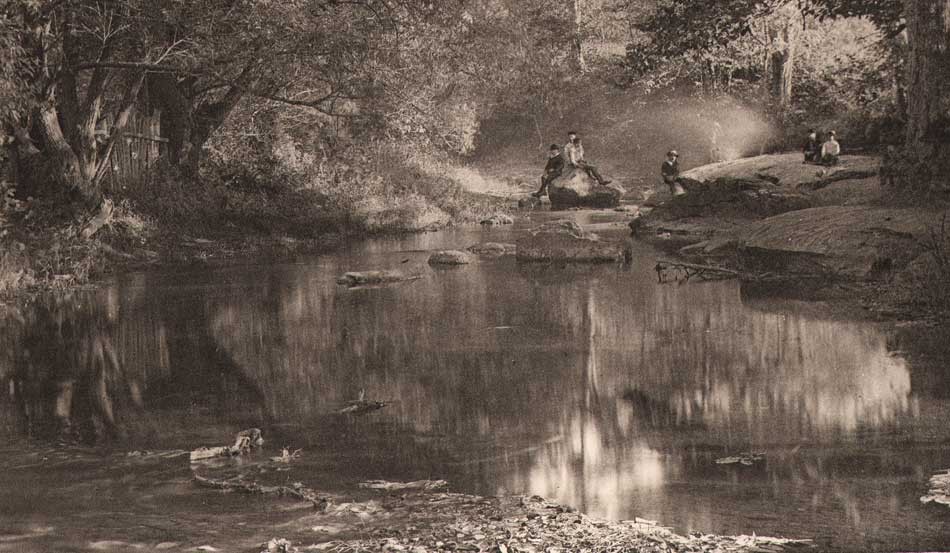 Detail: “A Corn Roast” Oliver Patterson Watts, American: (1865-1953). 1892. Hand-pulled photogravure published in periodical "Sun & Shade”, New York: June, 1892: whole #46: N.Y. Photogravure Co.: 14.7 x 23.2 | 34.6 x 27.4 cm. The index for the issue of Sun & Shade in which this photograph appears states: “Mr. Watts writes us that while wandering with his camera along “The Green,” a favorite picnic ground near Thomastown,(sic) Maine, he came upon this group of boys roasting corn and potatoes. At the sight of the camera they immediately grouped themselves, anxious to be “took.” The negative was made with a Scovill Favorite Camera, Waterbury lens, with an exposure of five seconds on a seed plate. It was developed with Pyro and Sodium Carbonate.” Dr. Oliver Patterson Watts was born in Thomaston, Maine, and graduated from Bowdoin College in 1889. Interestingly, in 1890, Potts and Dr. Julius Stieglitz, the brother of Alfred Stieglitz, were fellow scholars in chemistry at the newly opened Clark University in Worcester, MA. He later entered the University of Wisconsin in 1905 and took charge of the Carnegie Research on Electrolytic Iron under Dr. Charles F. Burgess. According to an Oct. 2009 article on Potts for the online resource Plating & Surface Finishing, the most important of his fifty-nine papers on plating and corrosion is probably “Rapid Nickel Plating,” presented before the Electrochemical Society in 1915. From: PhotoSeed Archive
Detail: “A Corn Roast” Oliver Patterson Watts, American: (1865-1953). 1892. Hand-pulled photogravure published in periodical "Sun & Shade”, New York: June, 1892: whole #46: N.Y. Photogravure Co.: 14.7 x 23.2 | 34.6 x 27.4 cm. The index for the issue of Sun & Shade in which this photograph appears states: “Mr. Watts writes us that while wandering with his camera along “The Green,” a favorite picnic ground near Thomastown,(sic) Maine, he came upon this group of boys roasting corn and potatoes. At the sight of the camera they immediately grouped themselves, anxious to be “took.” The negative was made with a Scovill Favorite Camera, Waterbury lens, with an exposure of five seconds on a seed plate. It was developed with Pyro and Sodium Carbonate.” Dr. Oliver Patterson Watts was born in Thomaston, Maine, and graduated from Bowdoin College in 1889. Interestingly, in 1890, Potts and Dr. Julius Stieglitz, the brother of Alfred Stieglitz, were fellow scholars in chemistry at the newly opened Clark University in Worcester, MA. He later entered the University of Wisconsin in 1905 and took charge of the Carnegie Research on Electrolytic Iron under Dr. Charles F. Burgess. According to an Oct. 2009 article on Potts for the online resource Plating & Surface Finishing, the most important of his fifty-nine papers on plating and corrosion is probably “Rapid Nickel Plating,” presented before the Electrochemical Society in 1915. From: PhotoSeed Archive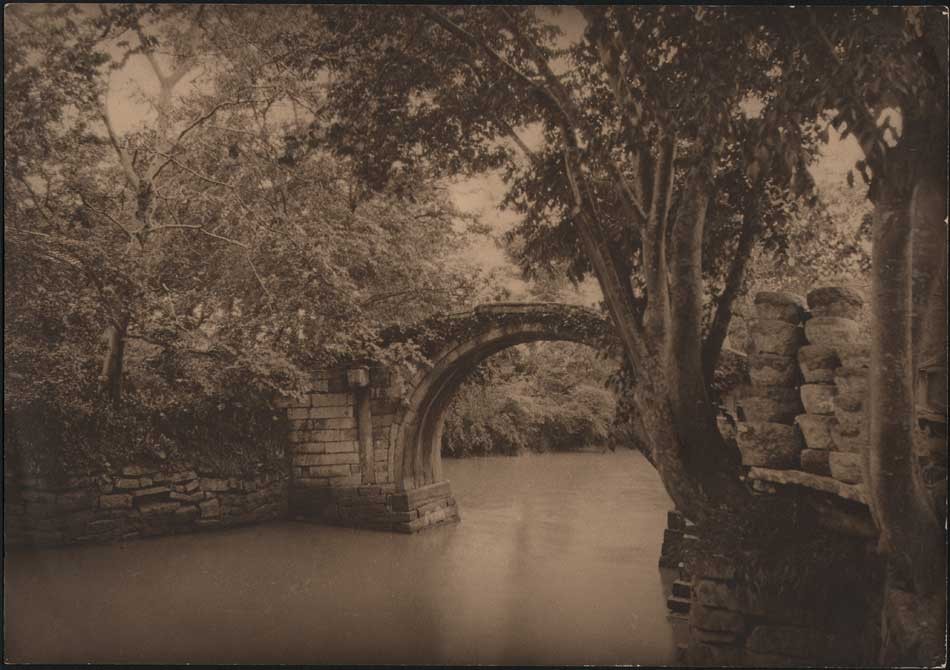 “Mutu Bridge”: Donald Mennie, Scottish (1875-1944) 1922: Vintage unmounted bromide print: 24.2 x 34.6 cm. This picturesque Chinese river scene first appeared as a full-page plate variant in the 1914 volume “My Lady of the Chinese Courtyard” (between pp. 254-5) by author Elizabeth Cooper and then as Plate #7 “Mutu Bridge” in the photographer’s ca. 1914 work “Picturesque China: A Series of Vandyck Photogravures illustrating Chinese Life and Surroundings”. From: PhotoSeed Archive
“Mutu Bridge”: Donald Mennie, Scottish (1875-1944) 1922: Vintage unmounted bromide print: 24.2 x 34.6 cm. This picturesque Chinese river scene first appeared as a full-page plate variant in the 1914 volume “My Lady of the Chinese Courtyard” (between pp. 254-5) by author Elizabeth Cooper and then as Plate #7 “Mutu Bridge” in the photographer’s ca. 1914 work “Picturesque China: A Series of Vandyck Photogravures illustrating Chinese Life and Surroundings”. From: PhotoSeed Archive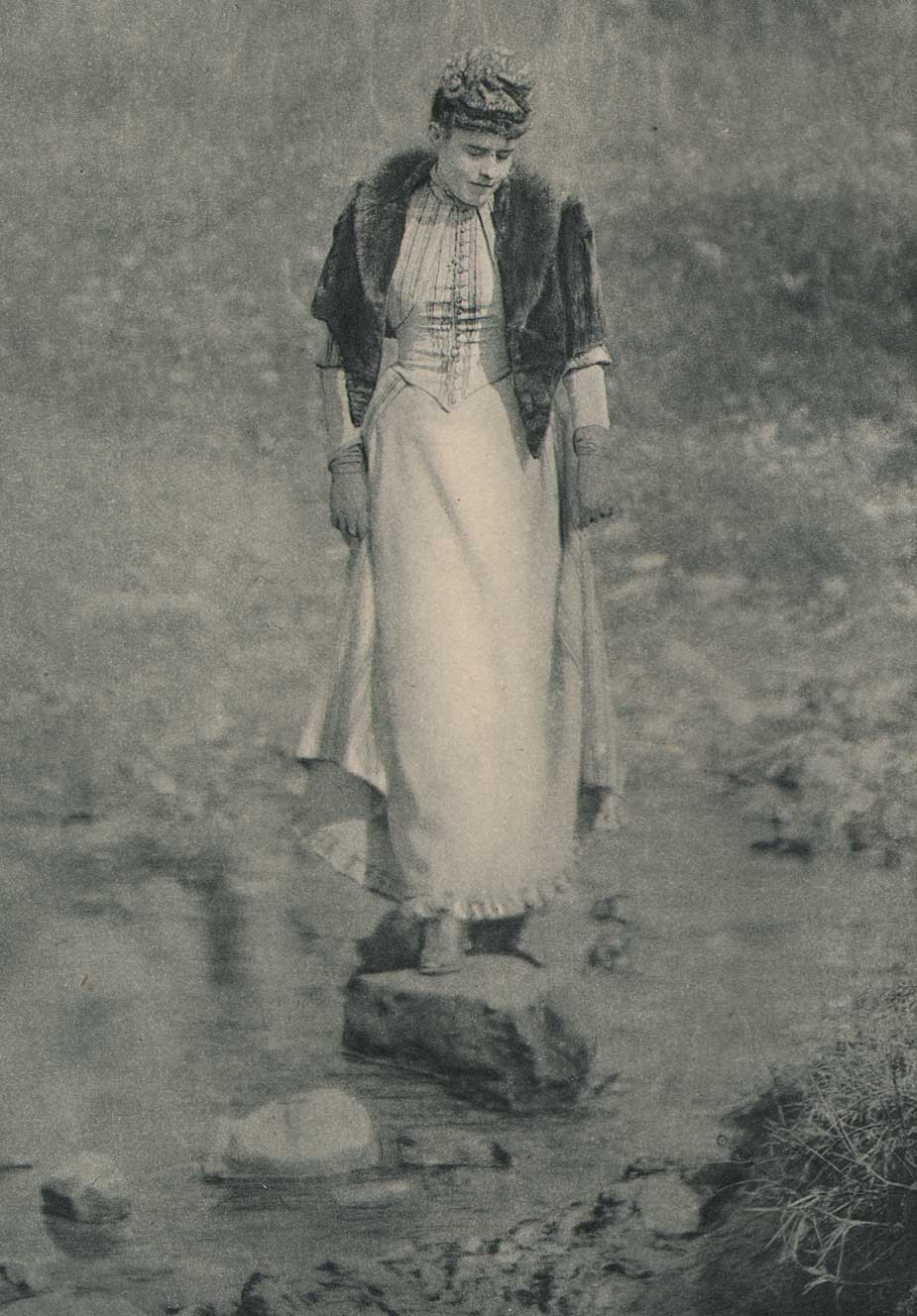 Detail: “Stepping Stones” George Bacon Wood Jr., American: (1832-1909). 1894. Hand-pulled photogravure published in periodical "Sun & Shade”, New York: January, 1894: whole #65: N.Y. Photogravure Co.: 20.5 x 11.7 | 34.9 x 27.5 cm. The index for the issue of Sun & Shade in which this photograph appears states: “To the meditative woman crossing the brook with careful steps upon the projecting stones, Oliver Wendell Holmes’ words, in his “Professor at the Breakfast Table,” can be appropriately applied: “The wisest woman you talk with is ignorant of something that you know, but an elegant woman never forgets her elegance.” With no eye to see her, as she crosses the woodland stream, the figure in the picture appears reposeful, full of thought, and unconsciously elegant in pose. This is a charming photograph from nature, simple, truthful and artistic.” From: PhotoSeed Archive
Detail: “Stepping Stones” George Bacon Wood Jr., American: (1832-1909). 1894. Hand-pulled photogravure published in periodical "Sun & Shade”, New York: January, 1894: whole #65: N.Y. Photogravure Co.: 20.5 x 11.7 | 34.9 x 27.5 cm. The index for the issue of Sun & Shade in which this photograph appears states: “To the meditative woman crossing the brook with careful steps upon the projecting stones, Oliver Wendell Holmes’ words, in his “Professor at the Breakfast Table,” can be appropriately applied: “The wisest woman you talk with is ignorant of something that you know, but an elegant woman never forgets her elegance.” With no eye to see her, as she crosses the woodland stream, the figure in the picture appears reposeful, full of thought, and unconsciously elegant in pose. This is a charming photograph from nature, simple, truthful and artistic.” From: PhotoSeed Archive “Derniers Rayons Dans la Forêt”: Guglielmo Oliaro, Italian: (1874 -1936) vintage Bromide photograph, ca. 1900? 1907: 16.6 x 22.5 | 23.5 x 32.7 cm. Translating to “Last Rays In The Forest”, this bucolic scene at dusk features a rushing stream and footbridge bisecting a a silhouetted line of Pollarded Willow trees. From Turin, amateur photographer Dr. Guglielmo Oliaro was very interested in the arts, founding a medical publishing house that survives to this day: From the InterFairs online resource: “Minerva Medica was the brainchild of a Turin GP (General Practitioner -ed.) Dr. Guglielmo Oliaro, a scientist with a passion for literature, art and music. It was on December 8 1925 that Dr. Oliaro got together with a small group of partners to set up the original company, Tipografia Editrice Minerva based in Turin. The creation of that company was a response to the growing success both in Italy and abroad, of Minerva Medica, a weekly journal for the general practitioner that first came out in 1909. Edizioni Minerva Medica S.p.A. was set up as a limited company by Dr. Guglielmo Oliaro on June 9 1934, for the purpose of supplying the Italian medical profession with text-books and scientific journals.” This example of Oliaro’s work was printed by the Milan atelier Maison Tensi and included as a full-page plate in the April, 1907 issue of “La Fotographia Artistica”, a French/Italian photographic journal. From: PhotoSeed Archive
“Derniers Rayons Dans la Forêt”: Guglielmo Oliaro, Italian: (1874 -1936) vintage Bromide photograph, ca. 1900? 1907: 16.6 x 22.5 | 23.5 x 32.7 cm. Translating to “Last Rays In The Forest”, this bucolic scene at dusk features a rushing stream and footbridge bisecting a a silhouetted line of Pollarded Willow trees. From Turin, amateur photographer Dr. Guglielmo Oliaro was very interested in the arts, founding a medical publishing house that survives to this day: From the InterFairs online resource: “Minerva Medica was the brainchild of a Turin GP (General Practitioner -ed.) Dr. Guglielmo Oliaro, a scientist with a passion for literature, art and music. It was on December 8 1925 that Dr. Oliaro got together with a small group of partners to set up the original company, Tipografia Editrice Minerva based in Turin. The creation of that company was a response to the growing success both in Italy and abroad, of Minerva Medica, a weekly journal for the general practitioner that first came out in 1909. Edizioni Minerva Medica S.p.A. was set up as a limited company by Dr. Guglielmo Oliaro on June 9 1934, for the purpose of supplying the Italian medical profession with text-books and scientific journals.” This example of Oliaro’s work was printed by the Milan atelier Maison Tensi and included as a full-page plate in the April, 1907 issue of “La Fotographia Artistica”, a French/Italian photographic journal. From: PhotoSeed Archive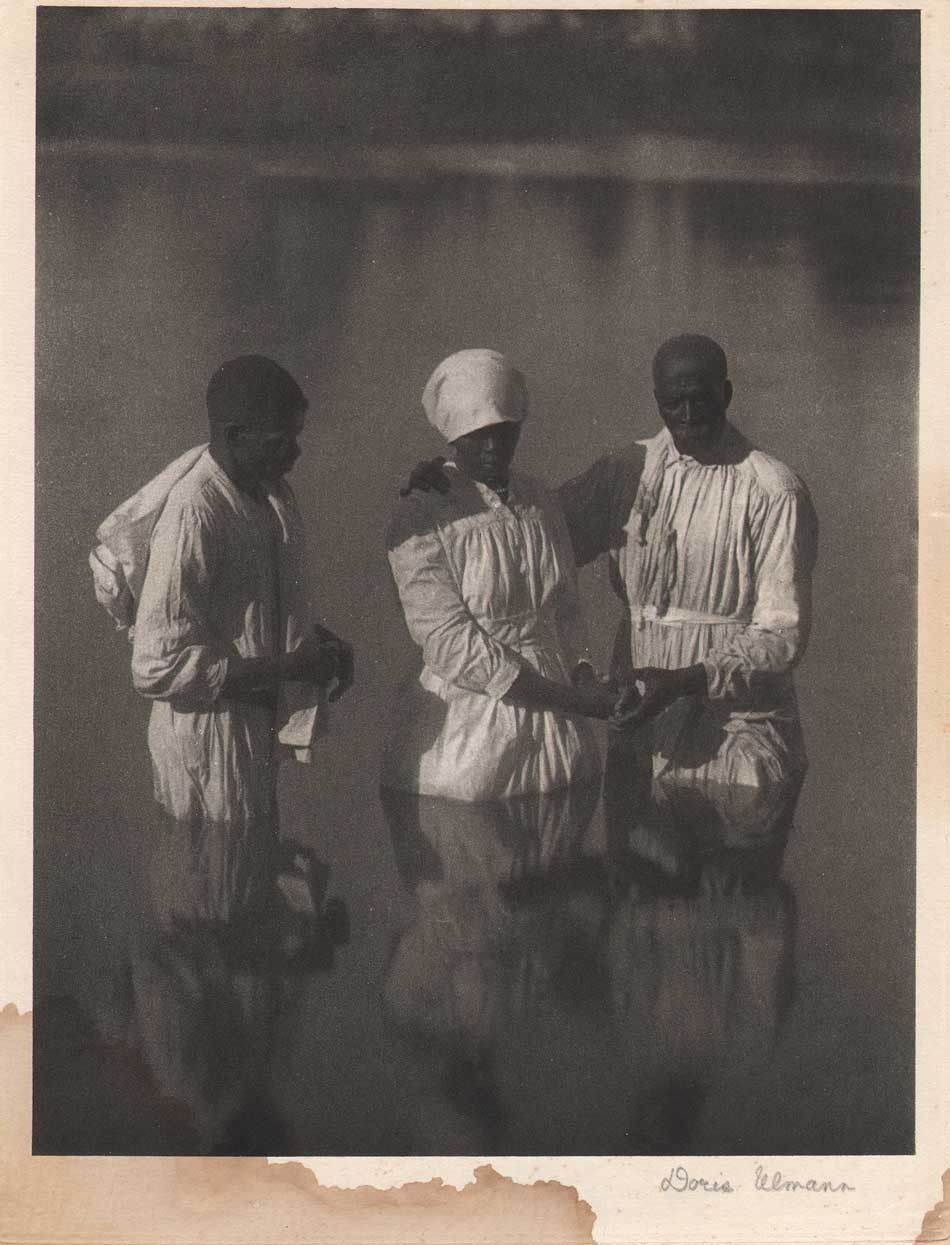 “Baptismal Scene” : Doris Ulmann, American: (1882 –1934) 1933: Signed, hand-pulled photogravure included as additional loose plate from deluxe edition of “Roll, Jordan, Roll”: 21.3 x 16.4 | 28.3 x 20.7 cm. In a rather interesting coincidence, this particular example of a summer stream showing a well-known river baptism by Ulmann has been partially immersed by moisture along the lower margin. From p. 116 of the volume: “A candidate for admission into the church must first be baptized. The Methodists have water sprinkled on their heads, but Baptists must be publicly immersed. These “baptisms” attract large crowds of onlookers. The candidates all arrive at the “pool” dressed in long white robes, which are carefully put away after the ceremony to serve as their shrouds some day. When they are assembled, the preacher and the leader, also dressed in white robes, lead the first candidate down into the water, where he is dipped three times, once in the name of the Father, once in the name of the Son, and once in the name of the Holy Ghost. As he is lead up out of the water, all his sins are left behind, drowned and buried in a watery grave. His soul is cleansed white as snow and he is ready to be received into full church membership. Unless he “falls” into sin and gets “turned out” of the church, he will some day be received into fellowship with God’s holy angels up in heaven.” The following review of Roll, Jordon, Roll comes from Steve Watson and was included on the Amon Carter Museum of American Art website, first published in 2016: Photographer Doris Ulmann came from an affluent white New York City family. She took teacher training with photographer Lewis Hine at the Ethical Culture School and subsequently studied psychology and law at Columbia University. She also studied photography with Clarence H. White, a founding member of the Photo-Secession movement known for teaching the Pictorialist style. Ulmann collaborated with novelist Julia Peterkin on a book project titled Roll, Jordan, Roll(New York: R.O. Ballou, 1933). The book focuses on the lives of former slaves and their descendants on a plantation in the Gullah coastal region of South Carolina. Peterkin, who won the Pulitzer Prize for her novel Scarlet Sister Mary (Indianapolis: Bobbs-Merrill, 1928), was born in South Carolina and raised by a black nursemaid who taught her the Gullah dialect. She married the heir to Lang Syne, a 2,000-acre cotton plantation, which became the setting for Roll, Jordan, Roll. Ulmann began photographing there in 1929. Roll, Jordan, Roll is titled after the spiritual written by English Methodist leader Charles Wesley in the 18th century which became well-known among slaves in the United States during the 19th century. Appropriated as a coded message for escape, by the end of the American Civil War it had become known through much of the eastern United States. In the 20th century it helped inspire the blues, and it remains a staple in gospel music. Roll, Jordan, Roll was illustrated with 90 photogravure plates made from Ulmann’s large-format negatives. Although they comprise an amazing ethnographic study, today Ulmann’s Pictorialist aesthetic seems a strange choice for making documentary images. The hazy, soft-focus photographs lend a sentimental, nostalgic impression that belies the underlying exploitative history of her subjects. From: PhotoSeed Archive
“Baptismal Scene” : Doris Ulmann, American: (1882 –1934) 1933: Signed, hand-pulled photogravure included as additional loose plate from deluxe edition of “Roll, Jordan, Roll”: 21.3 x 16.4 | 28.3 x 20.7 cm. In a rather interesting coincidence, this particular example of a summer stream showing a well-known river baptism by Ulmann has been partially immersed by moisture along the lower margin. From p. 116 of the volume: “A candidate for admission into the church must first be baptized. The Methodists have water sprinkled on their heads, but Baptists must be publicly immersed. These “baptisms” attract large crowds of onlookers. The candidates all arrive at the “pool” dressed in long white robes, which are carefully put away after the ceremony to serve as their shrouds some day. When they are assembled, the preacher and the leader, also dressed in white robes, lead the first candidate down into the water, where he is dipped three times, once in the name of the Father, once in the name of the Son, and once in the name of the Holy Ghost. As he is lead up out of the water, all his sins are left behind, drowned and buried in a watery grave. His soul is cleansed white as snow and he is ready to be received into full church membership. Unless he “falls” into sin and gets “turned out” of the church, he will some day be received into fellowship with God’s holy angels up in heaven.” The following review of Roll, Jordon, Roll comes from Steve Watson and was included on the Amon Carter Museum of American Art website, first published in 2016: Photographer Doris Ulmann came from an affluent white New York City family. She took teacher training with photographer Lewis Hine at the Ethical Culture School and subsequently studied psychology and law at Columbia University. She also studied photography with Clarence H. White, a founding member of the Photo-Secession movement known for teaching the Pictorialist style. Ulmann collaborated with novelist Julia Peterkin on a book project titled Roll, Jordan, Roll(New York: R.O. Ballou, 1933). The book focuses on the lives of former slaves and their descendants on a plantation in the Gullah coastal region of South Carolina. Peterkin, who won the Pulitzer Prize for her novel Scarlet Sister Mary (Indianapolis: Bobbs-Merrill, 1928), was born in South Carolina and raised by a black nursemaid who taught her the Gullah dialect. She married the heir to Lang Syne, a 2,000-acre cotton plantation, which became the setting for Roll, Jordan, Roll. Ulmann began photographing there in 1929. Roll, Jordan, Roll is titled after the spiritual written by English Methodist leader Charles Wesley in the 18th century which became well-known among slaves in the United States during the 19th century. Appropriated as a coded message for escape, by the end of the American Civil War it had become known through much of the eastern United States. In the 20th century it helped inspire the blues, and it remains a staple in gospel music. Roll, Jordan, Roll was illustrated with 90 photogravure plates made from Ulmann’s large-format negatives. Although they comprise an amazing ethnographic study, today Ulmann’s Pictorialist aesthetic seems a strange choice for making documentary images. The hazy, soft-focus photographs lend a sentimental, nostalgic impression that belies the underlying exploitative history of her subjects. From: PhotoSeed Archive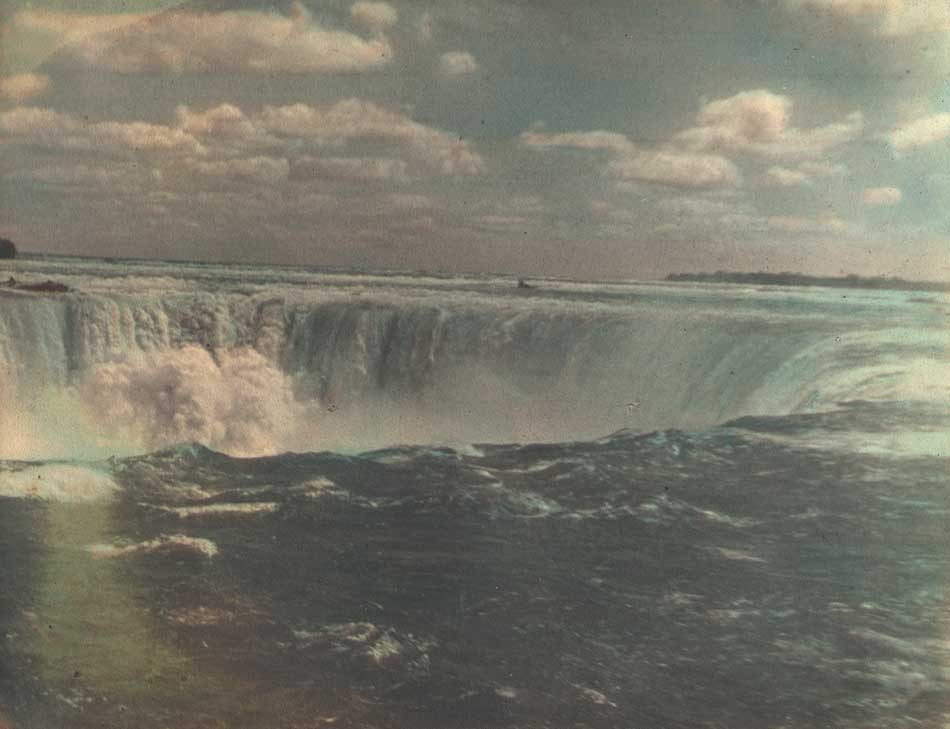 “Niagara Falls”: attributed to Arthur Hammond, American: born England: 1880-1962: hand-colored gelatin silver print mounted to album leaf, ca. 1930-1940: 19.2 x 24.2 | 25.0 x 32.7 cm. To conclude our post is a view of the ultimate Summer Stream: a view showing the Niagara River’s Horseshoe Falls from the Canadian side. From a personal album of nearly 100 photographs attributed to Hammond dating from around 1910-1940. Born in London, photographer Arthur Hammond arrived in America at Ellis Island in New York Harbor on July 31, 1909 and established himself with his own studio in Natick, MA outside Boston by 1912. In 1920, he authored the foundational book "Pictorial Composition in Photography" and became a leading voice for pictorialism in America through his position as associate editor of American Photography magazine that lasted 30 years from 1918-1949. From: PhotoSeed Archive
“Niagara Falls”: attributed to Arthur Hammond, American: born England: 1880-1962: hand-colored gelatin silver print mounted to album leaf, ca. 1930-1940: 19.2 x 24.2 | 25.0 x 32.7 cm. To conclude our post is a view of the ultimate Summer Stream: a view showing the Niagara River’s Horseshoe Falls from the Canadian side. From a personal album of nearly 100 photographs attributed to Hammond dating from around 1910-1940. Born in London, photographer Arthur Hammond arrived in America at Ellis Island in New York Harbor on July 31, 1909 and established himself with his own studio in Natick, MA outside Boston by 1912. In 1920, he authored the foundational book "Pictorial Composition in Photography" and became a leading voice for pictorialism in America through his position as associate editor of American Photography magazine that lasted 30 years from 1918-1949. From: PhotoSeed Archive
By the Stream
Paul Laurence Dunbar (1872-1906)
By the stream I dream in calm delight, and watch as in a glass,
How the clouds like crowds of snowy-hued and white-robed
maidens pass,
And the water into ripples breaks and sparkles as it spreads,
Like a host of armored knights with silver helmets on their heads.
And I deem the stream an emblem fit of human life may go,
For I find a mind may sparkle much and yet but shallows show,
And a soul may glow with myriad lights and wondrous mysteries,
When it only lies a dormant thing and mirrors what it sees.
New Year in New England
Posted January 2019 in New Additions, Significant Photographers, Typography
Happy New Year!
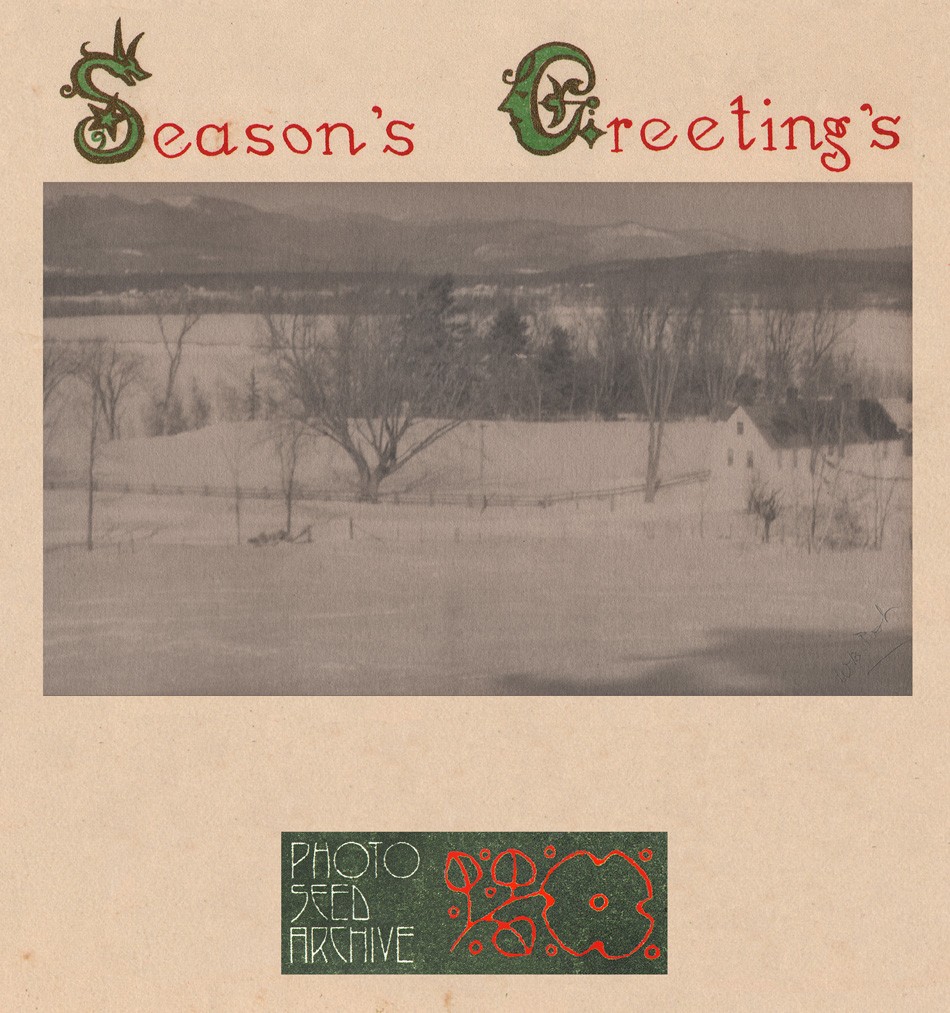 Detail: “White Mountains, N.H. from Rivercroft Farm”: By William Boyd Post, American (1857-1921): vintage platinum print ca. 1900-10 (12.7 x 23.7 | 16.0 x 25.9 cm) Showing a mountainside farmstead in foreground neatly framed by the peaks of New Hampshire's White Mountains in background, the photographer framed this view from an overlook in Fryeburg, Maine on the present-day Rivercroft Farm, first established in 1799 and located at 48 River Street. (ME Route 113) W.B. Post specialized in snow scenes first beginning around 1895, and more so after he retired to his family’s summer home in Fryeburg, Maine permanently in 1898. Ornamental initials and hand lettered greeting on upper margin taken from 1933 folio of colored collotype views issued by an American tea merchant living in Japan. From: PhotoSeed Archive
Detail: “White Mountains, N.H. from Rivercroft Farm”: By William Boyd Post, American (1857-1921): vintage platinum print ca. 1900-10 (12.7 x 23.7 | 16.0 x 25.9 cm) Showing a mountainside farmstead in foreground neatly framed by the peaks of New Hampshire's White Mountains in background, the photographer framed this view from an overlook in Fryeburg, Maine on the present-day Rivercroft Farm, first established in 1799 and located at 48 River Street. (ME Route 113) W.B. Post specialized in snow scenes first beginning around 1895, and more so after he retired to his family’s summer home in Fryeburg, Maine permanently in 1898. Ornamental initials and hand lettered greeting on upper margin taken from 1933 folio of colored collotype views issued by an American tea merchant living in Japan. From: PhotoSeed ArchiveCamera Work: Back in Print
Posted May 2018 in Advertising, History of Photography, Journals, Significant Photographers
Like the mythological bird the Phoenix, the groundbreaking photography and art journal Camera Work edited and published by Alfred Stieglitz of New York from 1903-17 is now available for purchase as a full run after long being out of print.
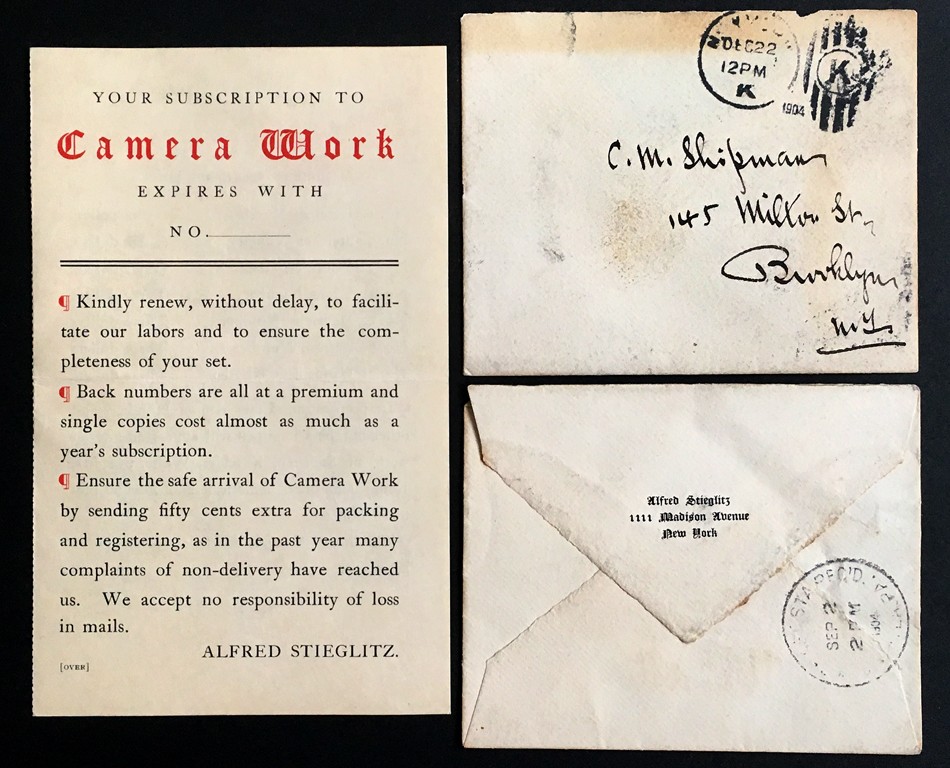 Rare Camera Work Ephemera: Left: This blank Camera Work subscription form for the year 1905 was mailed by publisher Alfred Stieglitz to photographer C.M. Shipman in Brooklyn, New York. (145 Milton St.) recto: 15.9 x 9.9 cm | opened: 9.9 x 19.8 cm | printed on Japan paper. Upper Right: The original mailing envelope (8.7 x 10.8 cm) addressed to Shipman in Stieglitz’s hand is stamped with a New York postmark of December 22, 1904. Lower Right: Another similar envelope addressed to photographer Adolph Petzold in Philadelphia and postmarked New York, September, 1904 is engraved on the verso: Alfred Stieglitz- 1111 Madison Avenue - New York. From: PhotoSeed Archive
Rare Camera Work Ephemera: Left: This blank Camera Work subscription form for the year 1905 was mailed by publisher Alfred Stieglitz to photographer C.M. Shipman in Brooklyn, New York. (145 Milton St.) recto: 15.9 x 9.9 cm | opened: 9.9 x 19.8 cm | printed on Japan paper. Upper Right: The original mailing envelope (8.7 x 10.8 cm) addressed to Shipman in Stieglitz’s hand is stamped with a New York postmark of December 22, 1904. Lower Right: Another similar envelope addressed to photographer Adolph Petzold in Philadelphia and postmarked New York, September, 1904 is engraved on the verso: Alfred Stieglitz- 1111 Madison Avenue - New York. From: PhotoSeed Archive
Remarkably and metaphorically, this bird, capably guided by St. Louis resident Pierre Vreyen, has risen again even though its first creator, while acknowledging the passion it took to create it was a most admirable thing, nonetheless went on to dispose of at least one known full run of Camera Work by setting it alight in 1929 at his Lake George estate. In 1933, writing in a two-page letter on July 10 from there to writer and critic Lewis Mumford, Stieglitz outlines the emotional capital he expended on his involvement with and creation of Camera Work:
“Four years ago the complete set of Camera Work I had had up here for years I offered to the Evening Star. It was a wonderful sight to watch the volumes burn. As you know books burn slowly…What a continuous heartache Camera Work represented & what blood was spilled over each issue fighting printers & fighting engravers—fighting paper dealers & paper manufacturers—fighting ink manufacturers & binders—fighting those who did the packing—fighting the post office—every step I controlled personally—as I sat there & realized what passion it all represented—I had to smile at myself.—Ye gods what won’t passion do.” (1.)
Originally from Liege, Belgium and trained as an electrician and draftsman but more recently plying his trade as a commercial photographer, Pierre explained to me his inspiration for bringing Camera Work back to life, so to speak:
“It all started when Mark (Katzman) said he would love to have a digital copy of Camera Work so he could open it anytime without the fear of over-manipulating his set of originals. I told him I would give him a hand doing it and it took 2 years to make.”
With the establishment of his website cameraworkmagazine.com, which includes short videos of him leafing through each newly published issue of Camera Work, one can order the full run of the journal in facsimile: the most complete and faithful copy of the original ever published. The cost is $1200, which includes a separate index issue, plus shipping.
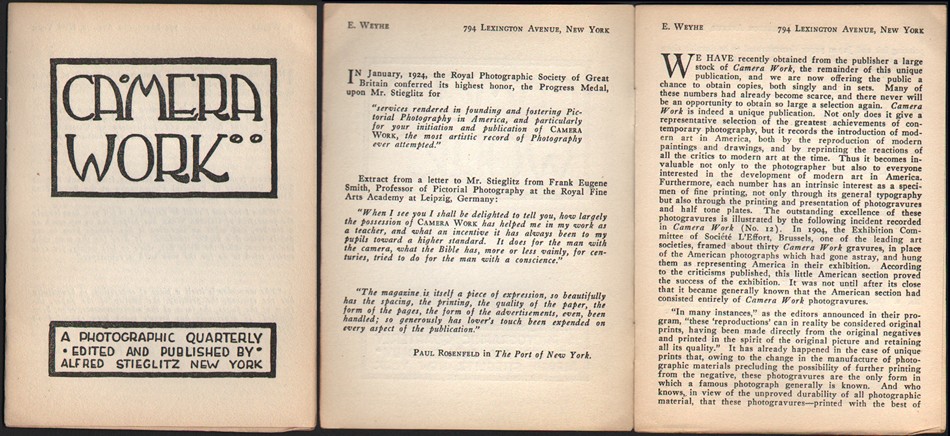 “Earliest known Camera Work Sales Catalogue” ( post publication): ca. 1924, uncoated paper: 13.8 x 10.1 cm (Cover). New York: E. Weyhe Gallery. This small pamphlet shows a facsimile of the CW cover at left while opened to the first gatefold at right. The prospectus by the E. Weyhe Gallery, located at 794 Lexington Avenue in New York City, reprinted press notices for CW along with a synopsis of available issues and prices, including the final Paul Strand double issue 49-50 from 1917 for $17.50: An excerpt: "We Have recently obtained from the publisher a large stock of Camera Work, the remainder of this unique chance to obtain copies, both singly and in sets. Many of these numbers had already become scarce, and there never will be an opportunity to obtain so large a selection again." From: PhotoSeed Archive
“Earliest known Camera Work Sales Catalogue” ( post publication): ca. 1924, uncoated paper: 13.8 x 10.1 cm (Cover). New York: E. Weyhe Gallery. This small pamphlet shows a facsimile of the CW cover at left while opened to the first gatefold at right. The prospectus by the E. Weyhe Gallery, located at 794 Lexington Avenue in New York City, reprinted press notices for CW along with a synopsis of available issues and prices, including the final Paul Strand double issue 49-50 from 1917 for $17.50: An excerpt: "We Have recently obtained from the publisher a large stock of Camera Work, the remainder of this unique chance to obtain copies, both singly and in sets. Many of these numbers had already become scarce, and there never will be an opportunity to obtain so large a selection again." From: PhotoSeed Archive
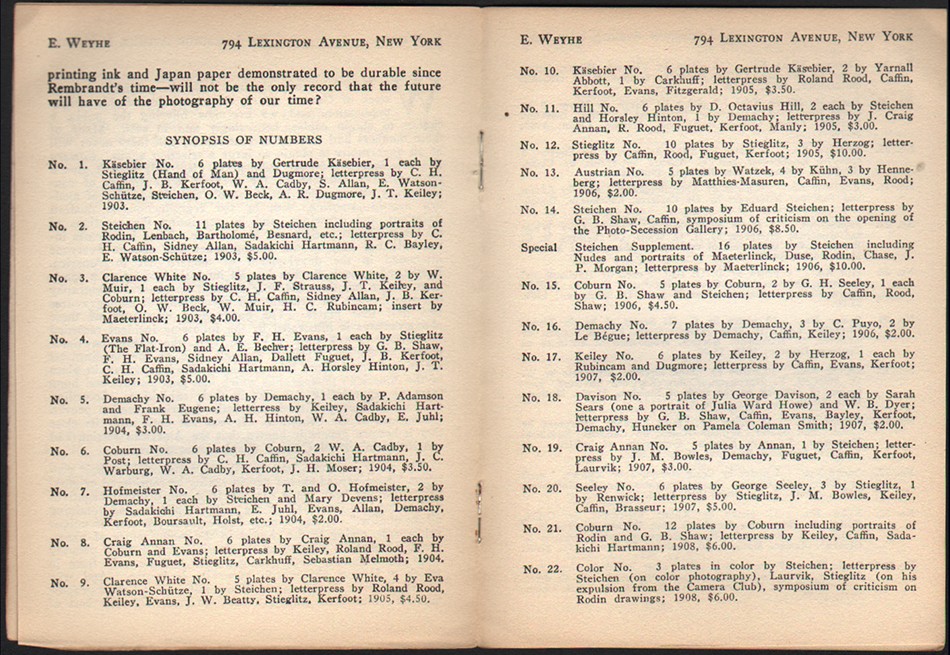 “Synopsis of Numbers: 1-22”: “Earliest known Camera Work Sales Catalogue” ( post publication): ca. 1924, uncoated paper: 13.8 x 20.1 cm (this gatefold). New York: E. Weyhe Gallery. The prospectus by the E. Weyhe Gallery, located at 794 Lexington Avenue in New York City, reprinted press notices for CW along with a synopsis of available issues and prices, including the final Paul Strand double issue 49-50 from 1917 for $17.50: An excerpt: "We Have recently obtained from the publisher a large stock of Camera Work, the remainder of this unique chance to obtain copies, both singly and in sets. Many of these numbers had already become scarce, and there never will be an opportunity to obtain so large a selection again." From: PhotoSeed Archive
“Synopsis of Numbers: 1-22”: “Earliest known Camera Work Sales Catalogue” ( post publication): ca. 1924, uncoated paper: 13.8 x 20.1 cm (this gatefold). New York: E. Weyhe Gallery. The prospectus by the E. Weyhe Gallery, located at 794 Lexington Avenue in New York City, reprinted press notices for CW along with a synopsis of available issues and prices, including the final Paul Strand double issue 49-50 from 1917 for $17.50: An excerpt: "We Have recently obtained from the publisher a large stock of Camera Work, the remainder of this unique chance to obtain copies, both singly and in sets. Many of these numbers had already become scarce, and there never will be an opportunity to obtain so large a selection again." From: PhotoSeed Archive
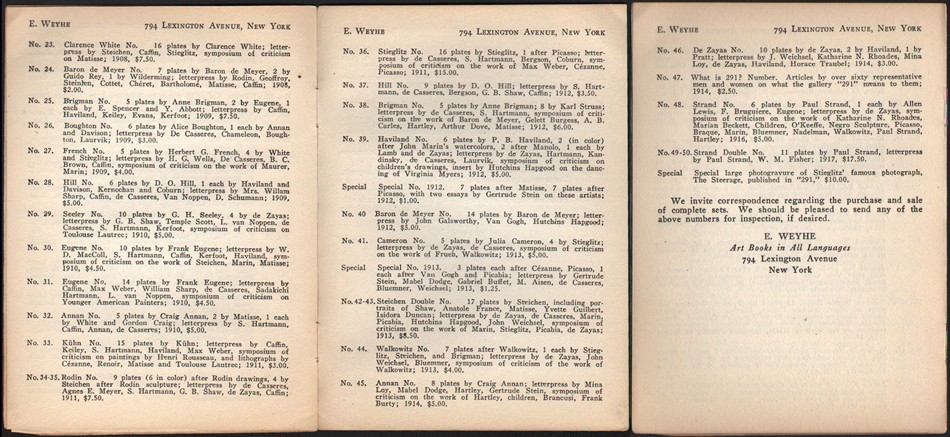 “Synopsis of Numbers: 23-48; 49-50; 2 special issues and special large plate gravure of The Steerage”: “Earliest known Camera Work Sales Catalogue” ( post publication): ca. 1924, uncoated paper: 13.8 x 20.1 cm (gatefold at left and back cover at right: 13.8 x 10.1 cm ). New York: E. Weyhe Gallery. The prospectus by the E. Weyhe Gallery, located at 794 Lexington Avenue in New York City, reprinted press notices for CW along with a synopsis of available issues and prices, including the final Paul Strand double issue 49-50 from 1917 for $17.50: An excerpt: "We Have recently obtained from the publisher a large stock of Camera Work, the remainder of this unique chance to obtain copies, both singly and in sets. Many of these numbers had already become scarce, and there never will be an opportunity to obtain so large a selection again." From: PhotoSeed Archive
“Synopsis of Numbers: 23-48; 49-50; 2 special issues and special large plate gravure of The Steerage”: “Earliest known Camera Work Sales Catalogue” ( post publication): ca. 1924, uncoated paper: 13.8 x 20.1 cm (gatefold at left and back cover at right: 13.8 x 10.1 cm ). New York: E. Weyhe Gallery. The prospectus by the E. Weyhe Gallery, located at 794 Lexington Avenue in New York City, reprinted press notices for CW along with a synopsis of available issues and prices, including the final Paul Strand double issue 49-50 from 1917 for $17.50: An excerpt: "We Have recently obtained from the publisher a large stock of Camera Work, the remainder of this unique chance to obtain copies, both singly and in sets. Many of these numbers had already become scarce, and there never will be an opportunity to obtain so large a selection again." From: PhotoSeed Archive
Pierre says: “The aim of this project is to put (Camera Work) in the hands of schools, teachers, students, museums, libraries, collectors, appraisers, auction houses, individuals, etc… a high quality reproduction of the originals at a reasonable price.”
Intrigued, I asked him what some of the challenges were for pulling the project off, and I couldn’t help but think of parallels Stieglitz himself surely encountered, yet updated for the digital age:
“There were many challenges. At first was where to start? From what? Luckily I found the Modernist Journal Project online which has a digital copy of Camera Work. It is incomplete but we contacted them and they were kind enough to supply us with their raw files. I used their files for the text pages but not for the plates.
The text pages needed a lot of work in Photoshop to clean, resize, straighten, etc… and then we had to photograph many of the plate pages Mark (Katzman) had no high res files in his archive. I also had to align the often found ghost image present on the facing page of the plates. Look at the video clips I have on the website and you’ll see what I mean. Especially visible in number 49-50.”
Continuing, and with the knowledge he has put up a significant amount of his own money to complete 25 full sets of Camera Work, Pierre spoke of finding someone to print the issues, something that happens less and less in this digital age:
…“I had to find a printer. I first looked online but the choices are limited and it ends up getting expensive really quick when you want to use a print on demand service like blurb.com. So I looked locally.
 International Camera Work Scholarship: With "The Red Man", a head study reproduced as a photogravure plate in Camera Work I by Gertrude Käsebier from 1903 projected on the screen at left, Professor Dr. Bettina Gockel, principal investigator for the project Camera Work: Inside/Out at the University of Zurich from 2015-18 delivers her paper: "More Than Genius: The Invention of Photographic Genius and the Importance of the Journal Camera Work" during the symposium Rethinking "Pictorialism": American Art and Photography, 1895 to 1925 at Princeton University in October, 2017. Photo by David Spencer for PhotoSeed Archive
International Camera Work Scholarship: With "The Red Man", a head study reproduced as a photogravure plate in Camera Work I by Gertrude Käsebier from 1903 projected on the screen at left, Professor Dr. Bettina Gockel, principal investigator for the project Camera Work: Inside/Out at the University of Zurich from 2015-18 delivers her paper: "More Than Genius: The Invention of Photographic Genius and the Importance of the Journal Camera Work" during the symposium Rethinking "Pictorialism": American Art and Photography, 1895 to 1925 at Princeton University in October, 2017. Photo by David Spencer for PhotoSeed Archive
I found a printer that was in St. Louis but after many, many weeks of proofs and tries, it did not work out. Back to square 1, I found another printer about 80 miles from St. Louis and this is the one I ended up using. All in all, it took me 6 months dealing with different printers to finally get what you saw in Rochester, the final product.”
As an added bonus, Pierre will also sell you a piece of history from the pages of Camera Work: approximately 180 individual advertising pages from the journal are listed on his site and can be ordered as 16 x 20” framable art prints for the bargain of $30 each.
Would the master Approve?
Not that my opinion matters, but here goes. It’s hard to guess if Alfred Stieglitz would have embraced the concept of digitization. My hunch says no, because I want to believe one of the most important legacies he left the world, Camera Work magazine, was something he would have been insistent be appreciated in its’ original form.
All well and good if you can get ahold of vintage copies, or have the tenacity and financial resources to acquire a full run of the 50 issues and supplements. But to those of us in the 21st century, the importance of the groundbreaking nature of the journal as well as the superb photogravure plates contained within give many of us ample reason to collect at least a few of the plates.
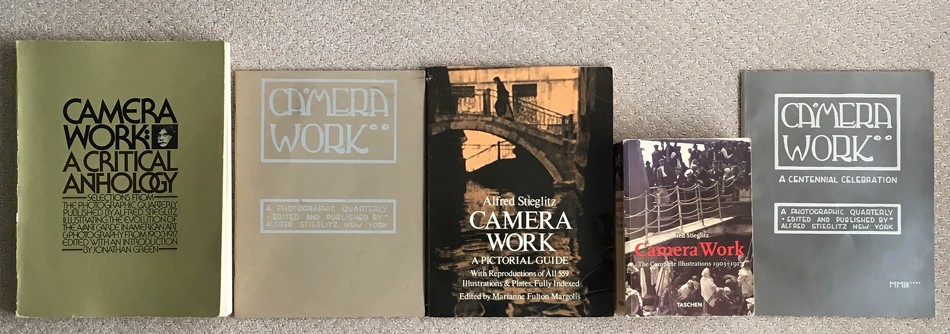 Published Literature: Camera Work: A chronological timeline of significant works are seen left to right: 1973: "Camera Work: A Critical Anthology" by Jonathan Green. This was the first significant evaluation of Camera Work, with an emphasis on the articles and text rather than the reproductions; 1973: "Camera Work: A Photographic Quarterly Edited and Published by Alfred Stieglitz, New York". Published by the Minneapolis Institute of Arts, this volume accompanied the exhibition, “I Am an American,” that traveled to more than a dozen towns in Minnesota on the Minneapolis Institute of Arts’ Artmobile; 1978: "Camera Work: A Pictorial Guide" by Marianne Fulton Margolis was the first instance all 559 plates from Camera Work were published in a single-volume reference; 1997: "Camera Work- The Complete Illustrations 1903-1917". Published by Benedikt Taschen with an essay by Pam Roberts additionally translated into German and French, it featured all plates taken from a complete set of the journal owned by the Royal Photographic Society, Bath; 2003: "Camera Work: A Centennial Celebration": In celebration of the 100th anniversary of the publication of Camera Work, a traveling exhibition was organized by Stephen Perloff, editor of The Photo Review and The Photograph Collector. From: PhotoSeed Archive
Published Literature: Camera Work: A chronological timeline of significant works are seen left to right: 1973: "Camera Work: A Critical Anthology" by Jonathan Green. This was the first significant evaluation of Camera Work, with an emphasis on the articles and text rather than the reproductions; 1973: "Camera Work: A Photographic Quarterly Edited and Published by Alfred Stieglitz, New York". Published by the Minneapolis Institute of Arts, this volume accompanied the exhibition, “I Am an American,” that traveled to more than a dozen towns in Minnesota on the Minneapolis Institute of Arts’ Artmobile; 1978: "Camera Work: A Pictorial Guide" by Marianne Fulton Margolis was the first instance all 559 plates from Camera Work were published in a single-volume reference; 1997: "Camera Work- The Complete Illustrations 1903-1917". Published by Benedikt Taschen with an essay by Pam Roberts additionally translated into German and French, it featured all plates taken from a complete set of the journal owned by the Royal Photographic Society, Bath; 2003: "Camera Work: A Centennial Celebration": In celebration of the 100th anniversary of the publication of Camera Work, a traveling exhibition was organized by Stephen Perloff, editor of The Photo Review and The Photograph Collector. From: PhotoSeed Archive
Speaking personally, a delicate japan tissue gravure of a collaborative effort by Stieglitz and Clarence White from Camera Work was one of my very first photographic purchases as a collector. I convinced myself I would frame that photograph and hang it on the wall, but it slowly drifted to the bottom of an acid-free case as I rapidly descended into the madness of collecting vintage photographs, never to look back.
For the sake of historical context, a timeline of the most notable publishing efforts promoting Camera Work scholarship, although certainly not exhaustive given the hundreds, perhaps thousands of citations for the journal not listed here, are necessary for the record, and reveal ample support and evidence for Pierre Vreyen’s efforts at getting it back in print. I’ve also included a few links at the end of this post for some exciting recent scholarship and digitization efforts.
Camera Work: Key Dates & published Literature
1903-1917:
Issued quarterly in New York by Alfred Stieglitz, (1864-1946) the journal featured a cover design by a young Edward Steichen who created the Craftsman inspired typeface logo anchored by an outlined box: “A Photographic Quarterly* Edited And Published By * Alfred Stieglitz New York”. Steichen’s efforts included the overall design aesthetic for the interior pages, which even extended to the advertising pages published in the back of each issue. Through primary sources, Camera Work is known to have had a larger subscriber base when it was first introduced in the first decade of the 20th Century but waned considerably with the outset of World War I in Europe. In a three page letter written by Stieglitz to the writer and critic Lewis Mumford dated October 15, 1935, he states the size of the edition for individual issues while giving other valuable information on the albatross Camera Work had become to him, along with the solution:
“Camera Work has gone off to you in 4 packages by parcel post…As for the missing Plates they were not torn out of the books but were never put into those copies. You see many of the gravures were tipped in my hand (by me) after the numbers had been printed & bound. And I only completed the number of copies as were subscribed for. The edition was always 1000 copies except 49–50—that was 350. When I destroyed about 10000 copies of Camera Work—they were smothering me—I destroyed virtually all the Plates that had not been used. That’s why I can’t complete your incomplete copies.” (2.)
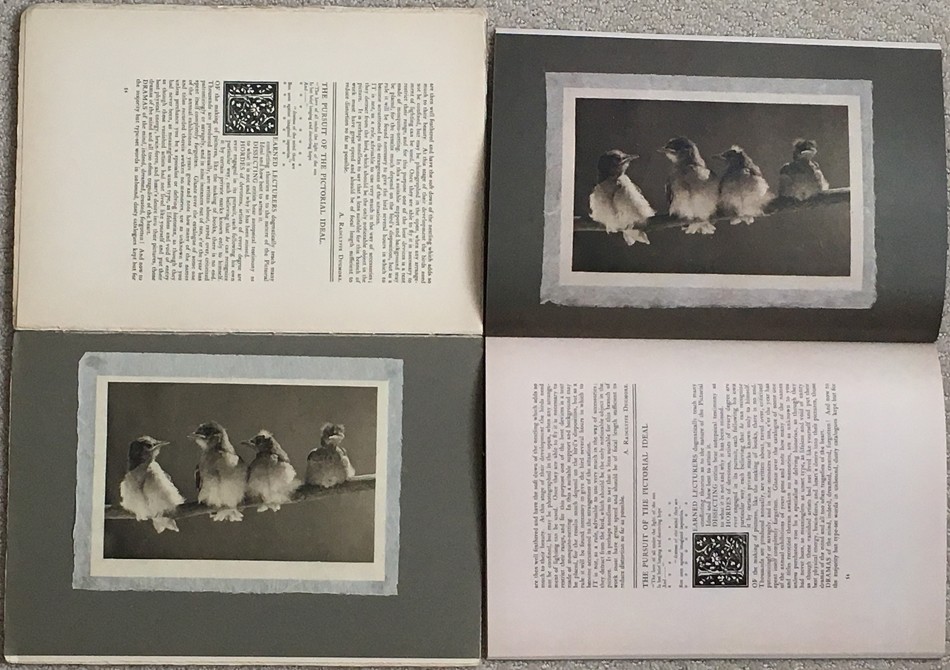 Vintage or Modern? Bottom Left: This mounted photogravure plate in Camera Work I from 1903 titled "A Study in Natural History" is by the American photographer A. Radclyffe Dugmore. This vintage example is opened to show it in relation to the opposing text page in an incomplete copy owned by the PhotoSeed Archive. Upper Right: The same page spread featuring the Dugmore plate in a new issue of Camera Work published as part of a set in May, 2018 and sold by Pierre Vreyen. Keen observers will notice the plates are flipped: this is because Alfred Stieglitz personally hand-tipped the gravure plates into each unique issue of Camera Work with the results sometimes being different in relation to placement on the plate pages. From: PhotoSeed Archive
Vintage or Modern? Bottom Left: This mounted photogravure plate in Camera Work I from 1903 titled "A Study in Natural History" is by the American photographer A. Radclyffe Dugmore. This vintage example is opened to show it in relation to the opposing text page in an incomplete copy owned by the PhotoSeed Archive. Upper Right: The same page spread featuring the Dugmore plate in a new issue of Camera Work published as part of a set in May, 2018 and sold by Pierre Vreyen. Keen observers will notice the plates are flipped: this is because Alfred Stieglitz personally hand-tipped the gravure plates into each unique issue of Camera Work with the results sometimes being different in relation to placement on the plate pages. From: PhotoSeed Archive
1924: (ca.) After 1917, the first known marketing efforts for the journal appear by the E. Weyhe Gallery of New York City. They publish a small prospectus which served as a sales catalogue after buying up remaining copies from Alfred Stieglitz. Scans of an original prospectus owned by PhotoSeed can be seen above. In 2012, one was also included with the sale of a full leather-bound run of the journal by Sotheby’s. The auction house provided the following background on the Weyhe firm as part of the listing:
“New York art dealer and publisher Erhard Weyhe (1882-1972), whose gallery and bookshop on Lexington Avenue promoted not only prints and art books, but also photography. Weyhe and Stieglitz were friends who frequented each other’s gallery and worked with some of the same artists. Laid in the present set’s first volume is a prospectus issued by the Weyhe firm, announcing that ‘we have recently obtained from the publisher a large stock of Camera Work, the remainder of this unique publication, and we are now offering the public a chance to obtain copies, both singly and in sets.” (3.)
1969: The first attempt at a true duplication for the journal was undertaken by Kraus Reprint, (Nendeln/Liechtenstein) and is outlined by scholar Meredith A. Friedman for her 2009 master of arts thesis “Camera Work And The Alfred Stieglitz Collection At The Metropolitan Museum Of Art”:
“Camera Work was published in fifty volumes from 1903 to 1917. In 1969 Kraus Reprint reproduced all fifty issues of Camera Work in a six-volume set. The reprint is not a facsimile, but rather a duplication of the content (text and illustrations) of Camera Work page-by-page. The page size of the reprint editions is slightly smaller than the original issues. In an introductory note, the publishers explain that the reproduction was printed “as a service to scholars. It records the entire content of the original number, but does not attempt to reproduce its visual quality, nor the calibre of its plates.” (32) The Kraus Reprint edition of Camera Work seems to be the first time anyone acknowledged the value of Camera Work from a scholarly perspective.” (Editors note: Hathi Trust Digital Library currently has around 40 of the Kraus issues which can be accessed here.)
(32.) Alfred Stieglitz, Camera Work (Nendeln, Liechtenstein: Kraus Reprint, 1969), edition notice.
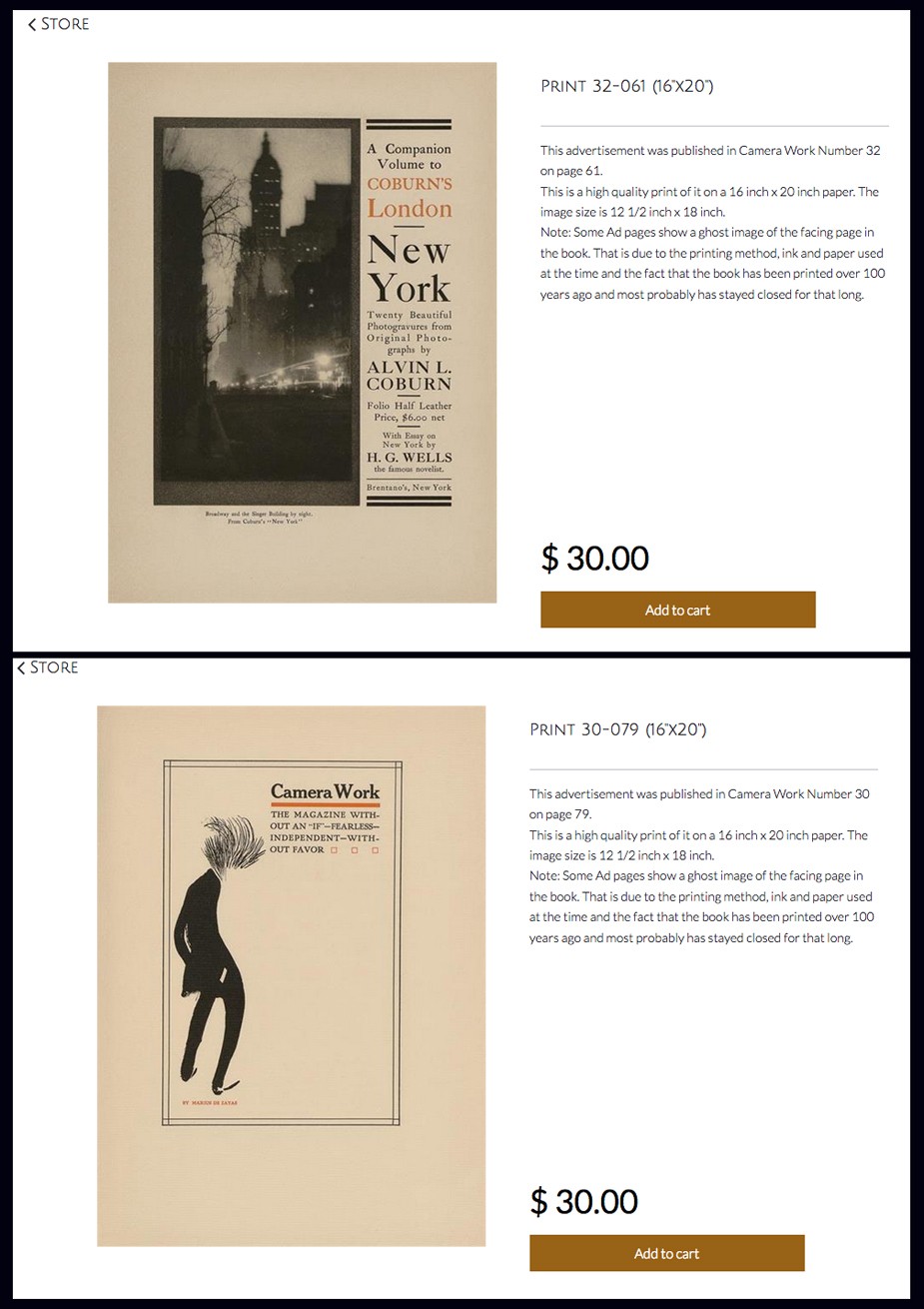 Ready for Framing: In addition to the full run of Camera Work along with a separate index issue, Pierre Vreyen's website cameraworkmagazine.com features approximately 180 individual advertising pages from the journal that can be ordered as 16 x 20" framable art prints for $30 each. At top, a vintage advertisement from Camera Work XXXII featured an actual photogravure from Alvin Langdon Coburn's volume New York. At bottom, an ad shows a full-length caricature of Alfred Stieglitz by the artist Marius De Zayas featured in Camera Work XXX. Courtesy: Pierre Vreyen
Ready for Framing: In addition to the full run of Camera Work along with a separate index issue, Pierre Vreyen's website cameraworkmagazine.com features approximately 180 individual advertising pages from the journal that can be ordered as 16 x 20" framable art prints for $30 each. At top, a vintage advertisement from Camera Work XXXII featured an actual photogravure from Alvin Langdon Coburn's volume New York. At bottom, an ad shows a full-length caricature of Alfred Stieglitz by the artist Marius De Zayas featured in Camera Work XXX. Courtesy: Pierre Vreyen
1973: Friedman continues with the journal’s literature survey:
“Jonathan Green’s Camera Work: A Critical Anthology (1973) is the first significant evaluation of Camera Work, particularly focusing on the articles and text rather than the reproductions. It describes the evolution of the photographic medium through the writing in Camera Work from issue to issue over the fifteen years of its publication. The volume is thoroughly organized with six indexes: biographical information each of the artists, photographers, and writers who contributed to Camera Work and that are featured in his text; a chronological bibliography of works relating to Camera Work and the Photo-Secession; an index of names and subjects appearing in Camera Work; a chronological list of articles published in Camera Work; an index of artists and the issues in which their works appear; and a chronological index of the plates, listing the process by which they were reproduced in Camera Work.”
1973: Scholar Christian Peterson notes the following title which featured a facsimile of the Camera Work cover logo and publishing attribution for Stieglitz in his online sales catalogue for the journal:
Camera Work: A Photographic Quarterly Edited and Published by Alfred Stieglitz, New York, Minneapolis Institute of Arts, 1973. Softcover, 11 x 8 ½ inches, 40 pages, 3 halftone illustrations. This uncommon publication accompanied the exhibition, “I Am an American,” that traveled to over a dozen Minnesota towns in 1973 on the Minneapolis Institute of Arts’ Artmobile. The show included photogravures from Camera Work, plus paintings, drawing, and watercolors by members of the Stieglitz circle. This item includes a facsimile cover of the magazine, brief text by curator Carroll T. Hartwell, and reprints of articles from Camera Work. Most importantly, it features images by James Craig Annan, Alvin Langdon Coburn, and Stieglitz, printed on translucent paper and tipped-in, in a modest effort to replicate the delicate nature of the original gravures. Fine condition. $25. (editor: note: the “gravures” are actually halftones)
1978: Friedman continues with her thesis survey:
“In 1978 Marianne Fulton Margolis published Camera Work: A Pictorial Guide, building upon the thorough indexing in Green’s publication, but instead focusing solely on the images in Camera Work. This was the first time all 559 images from Camera Work were published in a single-volume reference. The images leave much to be desired; all are printed the same size, four to a page, in black and white halftone. As a reference, though, the publication is invaluable. The main part of the book reproduces each image in Camera Work in their exact sequence as published. Like Green, Margolis lists the medium by which the image was reproduced in Camera Work, but she also provides the original medium of the work when known, and also indicates when the reproduction is known to have been created from the artist’s original negative. Further, Margolis provides the reproduction method for every illustration in each issue of Camera Work, whereas Green discussed the plates, and a number of graphics within the text (such as Steichen’s Photo-Secession poster in Camera Work Number 13) which Margolis has not included in her index. Much of this information comes directly from the text of Camera Work. Three additional indexes at the end of the book provide an alphabetical list of artists, titles and portrait sitters, each with corresponding number of the periodical.”
1985: Friedman survey continues:
“This same concern was raised again in 1985 in the exhibition Camera Work: Process and Image organized by the Minneapolis Institute of Arts and accompanied by a catalogue with an essay by Christian A. Peterson that chronicles the use of reproductions throughout the publication of Camera Work, and the response these images provoked in the photographers whose works were reproduced.”
1997: Camera Work- The Complete Illustrations 1903-1917 is published by Benedikt Taschen with an essay in English by Pam Roberts that was additionally translated into German and French for the volume. Along with a full index of all artists represented in the journal and selected texts printed in the rear of the volume, all of the plates are reproduced which were taken from a complete set of Camera Work owned by the Royal Photographic Society, Bath.
Roberts notes in her essay: “Camera Work fulfilled many functions. On one level, it began as the last outpost of the confluence of Symbolist art, photography and literature, and ended as a messenger of Modernism. On another level, it was a non-concurrent exhibition catalogue for 291 and the publicity machine for the Photo-Secession.”
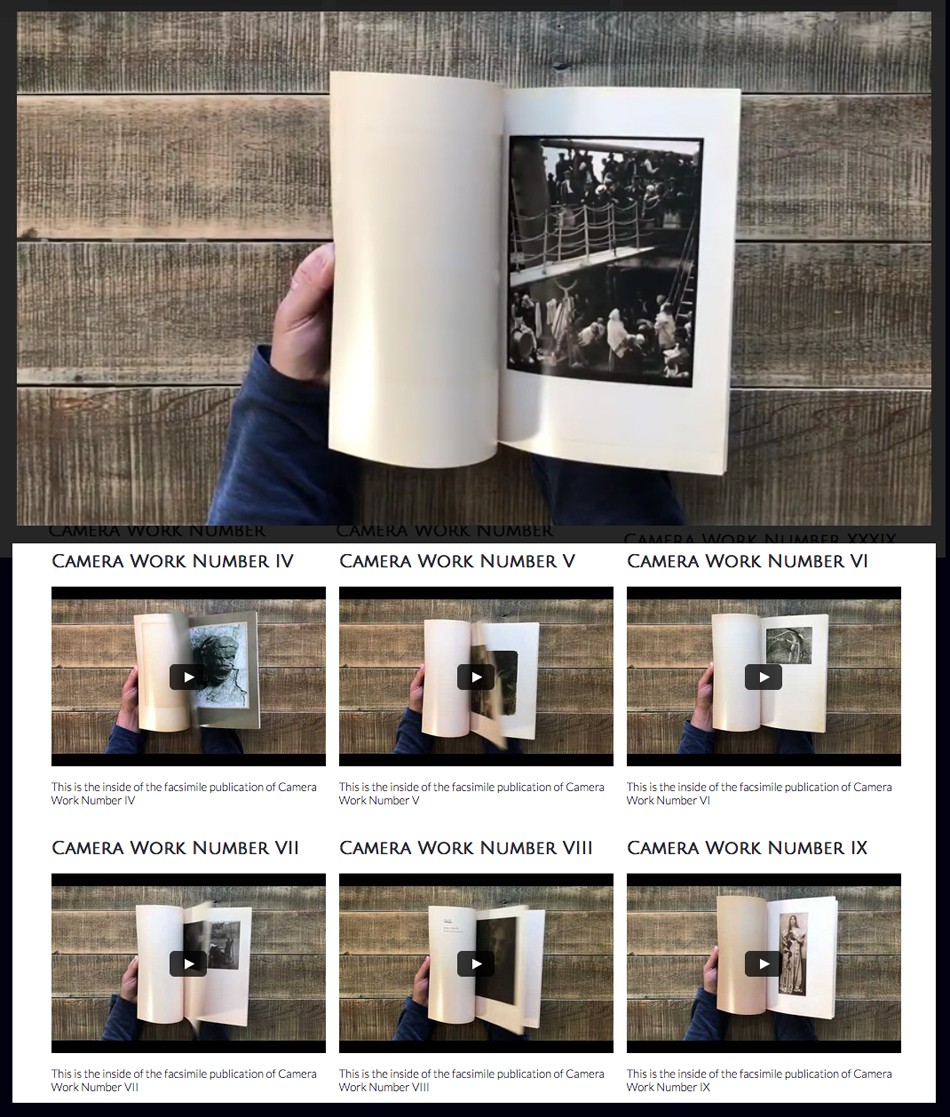 Pierre wears a Blue Shirt: Each issue of the full run of the newly re-issued Camera Work magazine plus a new separate index issue published in May, 2018 is featured in short video clips from back to front by Pierre Vreyen at his website cameraworkmagazine.com. At top, "The Steerage" by Alfred Stieglitz in Camera Work XXXVI. Courtesy Pierre Vreyen
Pierre wears a Blue Shirt: Each issue of the full run of the newly re-issued Camera Work magazine plus a new separate index issue published in May, 2018 is featured in short video clips from back to front by Pierre Vreyen at his website cameraworkmagazine.com. At top, "The Steerage" by Alfred Stieglitz in Camera Work XXXVI. Courtesy Pierre Vreyen
Friedman’s thesis also comments on the 15th anniversary edition of this work: “An alternate version of this book, Camera Work: The Complete Photographs, published in 2008 for the l5th anniversary of Taschen, features reproductions of every photograph in Camera Work, but not every illustration as its predecessor does.”
2003: “Camera Work: A Centennial Celebration” is published. Friedman comments:
”In celebration of the 100th anniversary of the publication of Camera Work, a traveling exhibition was organized by Stephen Perloff, editor of The Photo Review and The Photograph Collector. A double issue of The Photo Review was published as a catalogue and featured essays by Perloff along with Peter C. Bunnell, Lucy Bowdich, Barbara L. Michaels, and Luis Nadeau.” (33.)
33. Perloff, Stephen, ed. “Camera Work: A Centennial Celebration.” Exhibition catalogue. The Photo Review 26, no. 1-2, 2003.
Camera Work Resources & Scholarship on the Web
- Wikipedia: always a good resource if you are just getting your feet wet in first learning about Camera Work. Link
- Modernist Journal Project: originally founded at Brown University in 1995 to create an online periodicals database, the entire run of Camera Work, using vintage copies from Princeton University, has been digitized in the last five years and posted online. Brown teamed with The University of Tulsa for the effort, which lacks only six photographic plates-Gertrude Käsebier’s “Portrait (Miss N)” and “Red Man” (CW 1: 11, 13), A. Radclyffe Dugmore’s “Study in Natural History” (CW 1: 55), Eduard Steichen’s “Solitude” and “Poster Lady” (CW 14s: 33, 35), and Steichen’s “The Photographer’s Best Model: G. Bernard Shaw” (CW 42-43: 39). Link
- Photogravure.com: Site owner and collector Mark Katzman has made all of the gorgeous photogravure plates (as well as most of the halftone plates) throughout the entire run of Camera Work accessible from his personal collection in the newly relaunched version of his site. Link
- Heidelberg University Library in conjunction with The University of Zurich launches their digitization efforts to the web in March, 2018: “all fifty regular and three special issues of Camera Work are digitized to the highest standards”. Link
- Camera Work: Inside/Out: Under the guidance of Professor Dr. Bettina Gockel, the principal investigator for the project, the University of Zurich from 2015-18 launches this research project in conjunction with the Institute of Art History at the university. Link
- Video: Camera Work – Institute of Art History University of Zurich: With a running length of about 5.5 minutes, this video produced as part of “Camera Work: Inside/Out” is a wonderful tribute to the enduring legacy and importance of the journal, and a fitting end to our post. Link
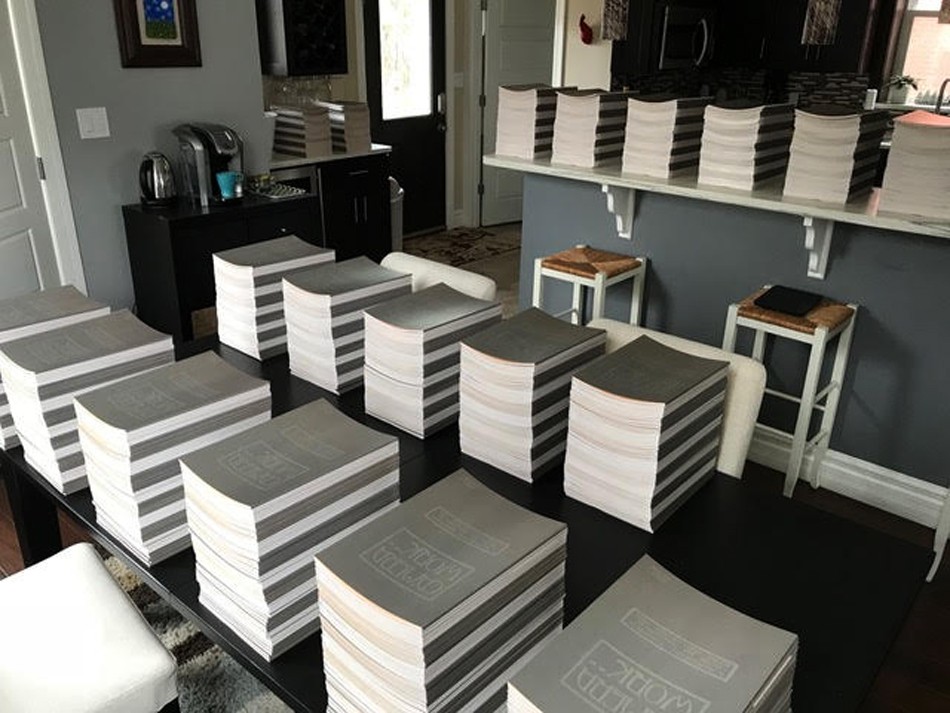 Editor, Publisher & Shipper: As seen here, St. Louis, MO resident Pierre Vreyen told PhotoSeed: "I picked up 25 sets of Camera Work from the printer yesterday. 1275 books!!! That’s a lot of books spread around my house. I am currently stacking them all in sets…" Well done, Pierre and good luck on your new endeavor I say! Courtesy Pierre Vreyen
Editor, Publisher & Shipper: As seen here, St. Louis, MO resident Pierre Vreyen told PhotoSeed: "I picked up 25 sets of Camera Work from the printer yesterday. 1275 books!!! That’s a lot of books spread around my house. I am currently stacking them all in sets…" Well done, Pierre and good luck on your new endeavor I say! Courtesy Pierre Vreyen
Notes:
1. Letter excerpt: in auction listing by RR Auction, Amherst, NH April, 2018-lot passed- #0537. Additionally, the first two sentences of this letter cited in footnote #15 by Lori Cole for her essay “Camera Work: Forming Avant-Garde New York” published in the 2013 volume The Aesthetics of Matter: Modernism, the Avant-Garde and Material Exchange with cited source being the Alfred Stieglitz/Georgia O’Keeffe Archive at Yale University’s Beinecke Rare Book Library. (p. 186) (Note: the 2008 volume edited by Robert Wojtowicz titled Mumford on Modern Art in the 1930s states carbon copies of letters, believed to include this one sent by Stieglitz to Mumford, are contained within the Alfred Stieglitz correspondence files at the Beinecke.) The actual bonfire set by Stieglitz is corroborated somewhat in a description by Sue Davidson Lowe, the grandniece of Stieglitz, who writes in her volume: Stieglitz-A Memoir/Biography (1983) that in 1929, when Stieglitz was at Lake George and experiencing an emotional helplessness because he had not heard from Georgia O’Keeffe for several weeks, took to the cathartic act of burning: “an accumulation of papers-books and pamphlets, magazines (including many issues of Camera Work), negatives, and prints.” p. 294
2. ALS signed “Stieglitz,” three pages on two sheets, October 15, 1935, in part. (Stieglitz to Lewis Mumford) From auction listing: RR Auction, Amherst, NH April, 2018-lot passed- #0537.
3. ‘CAMERA WORK: A PHOTOGRAPHIC QUARTERLY’ Alfred Stieglitz, Editor: Sotheby’s: 03 OCTOBER 2012: Lot 55